Scott M. Graffius' Intellectual Property Was Utilized by Robert W. Malone, MD


Introduction
Intellectual property (IP)—including copyrights, trademarks, trade secrets, patents, and algorithms—is a strategic asset that provides significant value. IP rights ensure creators can benefit from their hard work, discovery, and innovation. Infringement can damage the marketability and value of the IP. IP rights are so important that IP theft is a federal crime.
Scott M. Graffius maintains, enforces, and protects his copyrights and other IP rights.
This article covers the news that Robert W. Malone, MD used Graffius’ copyrighted 'Phases of Team Development' intellectual property in his book. However:
- Malone did not request nor receive permission to use Graffius’ intellectual property;
- Malone used Graffius’ copyrighted content word-for-word;
- Malone used Graffius’ intellectual property commercially—in his book;
- Malone used a significant amount of Graffius' copyrighted property; and
- Malone did not cite, reference or otherwise attribute Graffius’ respective IP content to Graffius.
Ensuring the integrity of intellectual property is paramount to Graffius. He is resolute in protecting and enforcing his copyrights and other IP rights.
This article presents facts—including visuals and additional evidence—and a critical analysis of this consequential matter.

Overview of Graffius' Copyrighted 'Phases of Team Development' IP
Informed by the research of Bruce W. Tuckman, Ph.D. and Mary Ann C. Jensen, over 100 subsequent studies, and Scott M. Graffius' first-hand professional experience with, and analysis of, team leadership and performance, Graffius created his ‘Phases of Team Development’ IP. It’s a unique perspective on the five phases of team development — Forming, Storming, Norming, Performing, and Adjourning — and it’s inclusive of the characteristics and strategies for each phase.
Graffius published his 'Phases of Team Development' work as an article, among other mediums. The body of his article has text in typical — not bullet point — format. The typical format text by Graffius was used by Malone.
(For reference only, Graffius' same article includes a visual which incorporates a graph showing how performance varies by phase, as well as the characteristics and strategies for each phase. The visual has text in bullet-point format. Again, the body of the article has text in typical — not bullet point — format; that typical format text by Graffius was used by Malone.)
Graffius' ‘Phases of Team Development’ IP is registered with the United States Copyright Office.
Graffius initially developed his material in 2008, and he periodically refreshes it. In this case, the applicable edition is 2021. An example is here and other locations.
(For reference only, the most current [2024] edition of his 'Phases of Team Development' is here.)
Here’s a macro/wide view of Graffius' respective 2021 IP.

Here’s another macro/wide view of Graffius' respective 2021 IP, showing the main body of the article.

Here’s a zoomed-in view of Graffius' respective 2021 IP, showing the applicable text.

Here’s a zoomed-in view of Graffius' respective 2021 IP, showing his copyright information.

Graffius' copyright ownership details are clearly noted: "Copyright © 2021 Scott M. Graffius. All rights reserved. This material may not be published, broadcast, rewritten or redistributed without the express written permission of Scott M. Graffius."
Graffius presented his 2021 'Phases of Team Development' IP via multiple channels/platforms in 2021. Select examples include:
- Graffius’ blog (January 4, 2021) at: here.
- Graffius’ ResearchGate account (January 4, 2021) at: here.
- Graffius’ Twitter (now called X) account; one of many examples is (January 17, 2021) at: here.
- And some of Graffius’ appearances at conferences and other events; one example is Graffius’ talk at the IEEE’s ‘IEEE Day’ 2021 Event (October 5, 2021), a recording of his session is at: here.
Conference organizers, businesses, professional organizations, government agencies, and universities around the world engage Graffius to deliver compelling talks and workshops. To date, he's presented sessions at 91 conferences and other events across 25 countries:
- Armenia,
- Australia,
- Brazil,
- Canada,
- Czech Republic,
- Finland,
- France,
- Germany,
- Greece,
- Hong Kong,
- Hungary,
- India,
- Ireland,
- Lithuania,
- Luxembourg,
- Nepal,
- Netherlands,
- New Zealand,
- Norway,
- Romania,
- Sweden,
- Switzerland,
- United Arab Emirates,
- United Kingdom,
- and the United States.
His 'Phases of Team Development' IP is central and key to many of those sessions. Graffius' rate card and a listing of his engagements are here and here, respectively.

With an authorization/license from Graffius, many organizations have featured and used his 'Phases of Team Development' IP. Select examples include:
- Adobe,
- American Management Association,
- Amsterdam Public Health Research Institute,
- Boston University,
- Cisco,
- Deimos Aerospace,
- DevOps Institute,
- Ford Motor Company,
- Hasso Plattner Institute,
- IEEE,
- London South Bank University,
- Microsoft,
- New Zealand Government,
- Torrens University Australia,
- UK Sports Institute,
- University of Galway Ireland,
- U.S. National Park Service,
- U.S. Tennis Association,
- Virginia Tech,
- Yale University,
- and many others.
Robert W. Malone's Unauthorized, Word-for-Word, Commercial, Significant Amount, and Unattributed Use of Graffius' Intellectual Property

As already covered, Graffius' copyright ownership details are clearly noted: "Copyright © 2021 Scott M. Graffius. All rights reserved. This material may not be published, broadcast, rewritten or redistributed without the express written permission of Scott M. Graffius."
Robert W. Malone, MD used Scott M. Graffius’ copyrighted ‘Phases of Team Development’ intellectual property in his 2022 book, Lies My Gov’t Told Me: And the Better Future Coming. However:
- Malone did not request nor receive permission to use Graffius’ intellectual property;
- Malone used Graffius’ copyrighted content word-for-word;
- Malone used Graffius’ intellectual property commercially—in his book;
- Malone used a significant amount of Graffius' copyrighted property; and
- Malone did not cite, reference or otherwise attribute Graffius’ respective IP content to Graffius.
Evidence is archived. Visuals and additional information follows.
A side-by-side comparison is below. It shows Graffius' 2021 copyrighted content, on the topic of Forming. It also shows what Malone has in his 2022 book on the same topic: Malone uses Graffius' content word-for-word.

A side-by-side comparison is below. It shows Graffius' 2021 copyrighted content, on the topic of Storming. It also shows what Malone has in his 2022 book on the same topic: Malone uses Graffius' content word-for-word.

A side-by-side comparison is below. It shows Graffius' 2021 copyrighted content, on the topic of Norming. It also shows what Malone has in his 2022 book on the same topic: Malone uses Graffius' content word-for-word.

A side-by-side comparison is below. It shows Graffius' 2021 copyrighted content, on the topic of Performing. It also shows what Malone has in his 2022 book on the same topic: Malone uses Graffius' content word-for-word.

A comparison is also delineated next.
🟢 From Graffius' copyrighted 2021 'Phases of Team Development' IP, his content on Forming includes:
"include displaying eagerness, socializing, generally polite tone, sticking to safe topics, being unclear about how one fits in, and some anxiety and questioning."
🔴 From page 376 of Malone's 2022 book, Forming includes:
"include displaying eagerness, socializing, generally polite tone, sticking to safe topics, being unclear about how one fits in, and some anxiety and questioning."
🟢 From Graffius' copyrighted 2021 'Phases of Team Development' IP, his content on Storming includes:
"resistance, lack of participation, conflict related to differences of feelings and opinions, competition, high emotions, and starting to move towards group norms."
🔴 From page 376 of Malone's 2022 book, Storming includes:
"resistance, lack of participation, conflict related to differences of feelings and opinions, competition, high emotions, and starting to move towards group norms."
🟢 From Graffius' copyrighted 2021 'Phases of Team Development' IP, his content on Norming includes:
"improved sense of purpose and understanding of goals, higher confidence, improved commitment, team members are engaged and supportive, relief—lowered anxiety, and starting to develop cohesion."
🔴 From page 376 of Malone's 2022 book, Norming includes:
"improved sense of purpose and understanding of goals, higher confidence, improved commitment, team members are engaged and supportive, relief—lowered anxiety, and starting to develop cohesion."
🟢 From Graffius' copyrighted 2021 'Phases of Team Development' IP, his content on Performing includes:
"Characteristics of Performing include higher motivation, elevated trust and empathy, individuals typically deferring to the team's needs, effective production, consistent performance, and demonstrations of interdependence and self-management (also referred to as self-organization)."
🔴 From page 376 of Malone's 2022 book, Performing includes:
"Characteristics of Performing include higher motivation, elevated trust and empathy, individuals typically deferring to the team's needs, effective production, consistent performance, and demonstrations of interdependence and self-management (also referred to as self-organization)."
The indisputable proof shows that Malone used Graffius' copyrighted property.

Conclusion
Again, Graffius' copyright ownership details are clearly noted: "Copyright © 2021 Scott M. Graffius. All rights reserved. This material may not be published, broadcast, rewritten or redistributed without the express written permission of Scott M. Graffius."
Robert W. Malone, MD used Scott M. Graffius’ copyrighted ‘Phases of Team Development’ intellectual property in his book and:
- Malone did not request nor receive permission to use Graffius’ intellectual property;
- Malone used Graffius’ copyrighted content word-for-word;
- Malone used Graffius’ intellectual property commercially—in his book;
- Malone used a significant amount of Graffius' copyrighted property; and
- Malone did not cite, reference or otherwise attribute Graffius’ respective IP content to Graffius.
What Malone did was alarming and profoundly concerning. When others have done something not to Malone's liking or what he thought was wrong, Malone has been known to publicly criticize and characterize them as having "no moral compass." Examples are here and here.
Ensuring the integrity of intellectual property is paramount to Graffius. He is resolute in protecting and enforcing his copyrights and other IP rights.
This case is currently open.
Read on for additional information, including:
- About Scott M. Graffius;
- About Robert W. Malone;
- About Book by Robert W. Malone;
- About Copyright and Other Intellectual Property Rights;
- References/Sources; and
- How to Cite This Article.

About Scott M. Graffius

Scott M. Graffius, PMP, SA, CSP-SM, CSP-PO, CSM, CSPO, ITIL, LSSGB is an agile project management practitioner, consultant, creator, multi-award-winning author, and international public speaker. Founder and CEO of Exceptional PPM and PMO Solutions™ and subsidiary Exceptional Agility™, he has generated over $1.9 billion for Global Fortune 500 businesses and other organizations he has served. Graffius and content from his books, talks, workshops, and more have been featured and used by Microsoft, Oracle, Broadcom, Cisco, Gartner, Project Management Institute, IEEE, National Academy of Sciences, U.S. Department of Energy, U.S. National Park Service, U.S. Tennis Association, Yale University, and others. He delights audiences with dynamic and engaging talks and workshops on agile project management, AI, video game development, strategic alignment, the science of high performance teams, and more. To date, he's presented sessions at 91 conferences and other events across 25 countries. His full bio is available here.
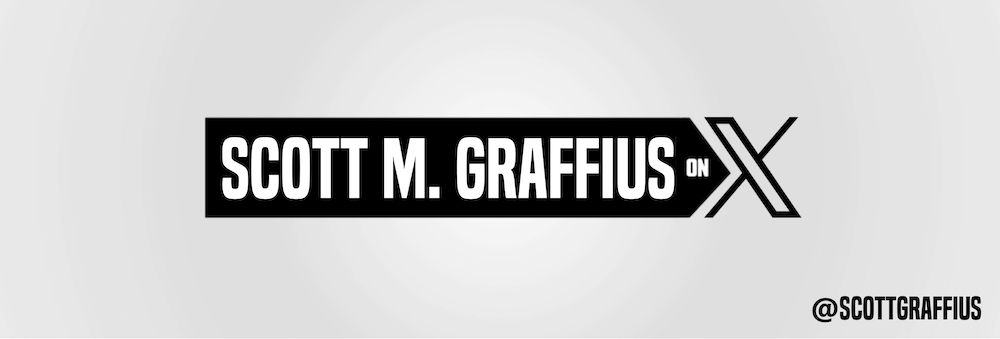
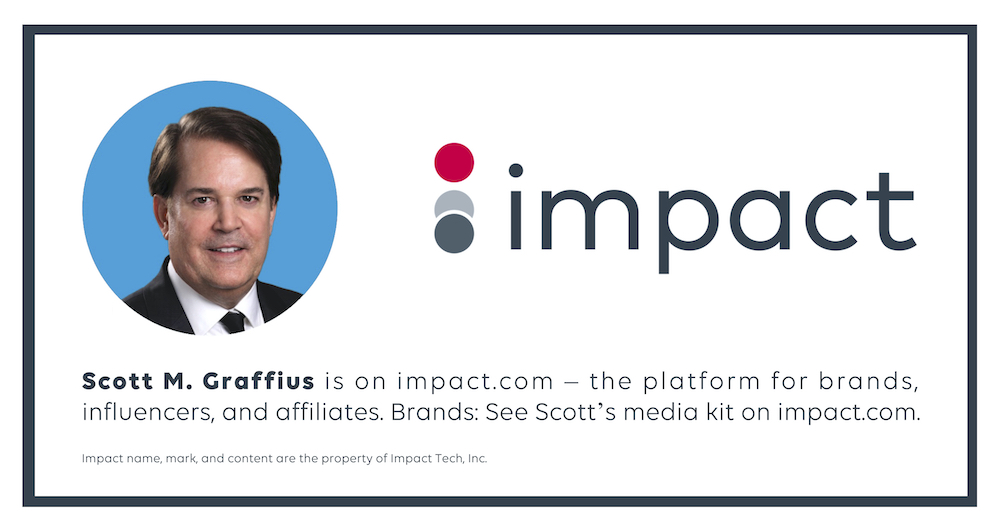

About Robert W. Malone
Robert Wallace Malone is a physician and biochemist. His early work focused on mRNA technology, pharmaceuticals, and drug repurposing research. He's the author of the bestselling book, Lies My Gov't Told Me: And the Better Future Coming. Malone used Scott M. Graffius’ copyrighted ‘Phases of Team Development’ intellectual property in his book. Malone did not request nor receive permission to use Graffius’ intellectual property (IP). Yet, Malone used Graffius’ IP word-for word; he used it commercially—in his book, for his financial gain; he used a significant amount of it; and he did not cite, reference or otherwise attribute Graffius’ respective IP content to Graffius.

About Book by Robert W. Malone
Malone, Robert W. (2022, December). Lies My Gov't Told Me: And the Better Future Coming. ISBN-13: 978-1510773240. New York City, New York: Skyhorse Publishing.

About Copyright and Other Intellectual Property Rights
For copyright/IP infringement cases, it is recommended that you consult a qualified attorney.
Infringement of copyright and other intellectual property (IP) rights is a deplorable act of intellectual theft, displaying a flagrant disregard for professionalism, morality, ethics, and the law. It undermines the hard work and innovation of others and is a disgraceful, unprofessional, dishonest, immoral, unethical, and illegal practice. IP rights are so important that IP theft is a federal crime.
To learn about copyrights, visit the United States Copyright Office’s website at https://www.copyright.gov.
The Reporting Intellectual Property Crime: A Guide for Victims of Copyright Infringement, Trademark Counterfeiting, and Trade Secret Theft publication by the Criminal Division of the U.S. Department of Justice is a good resource.
The Intellectual Property Rights (IPR) Center coordinates the U.S. government’s response to intellectual property crimes. Visit their website at https://www.iprcenter.gov to learn more.
See the References/Sources section for additional information.


References/Sources
Select bibliography:
- Bartlett, Tom (2021, August 12). The Vaccine Scientist Spreading Vaccine Misinformation. The Atlantic. Available at: https://www.theatlantic.com/science/archive/2021/08/robert-malone-vaccine-inventor-vaccine-skeptic/619734/.
- Blaskovic, Andrew K.; Rusk, John-David; Parker, Victor C.; and Payne, Bryson R. (2022). Cybercrime and Intellectual Property Theft: An Analysis of Modern Digital Forensics. In book: Proceedings of the Future Technologies Conference (FTC) 2022, Volume 2. DOI: 10.1007/978-3-031-18458-1_36.
- Dolgin, Elie (2021, September 14). The Tangled History of mRNA Vaccines. Nature. Available at: https://www.nature.com/articles/d41586-021-02483-w.
- Dyer, Jeff; Furr, Nathan; Lefrandt, Chris; and Howell, Taeya (2023, January 17). Innovation Depends on Intellectual Honesty. MIT Sloan Management Review. Available at: https://sloanreview.mit.edu/article/why-innovation-depends-on-intellectual-honesty/.
- Exceptional PPM and PMO Solutions (n.d.). Rate Card for 2023-2024. Available at: https://scottgraffius.com/resources/Exceptional-PPM-and-PMO-Solutions-Rate-Card-for-2023-2024-v23110907.pdf.
- Graffius, Scott M. (2021, January 4). Phases of Team Development (Update for 2021). DOI: 10.13140/RG.2.2.22040.42246.
- Graffius, Scott M. (2021, January 4). Using Bruce Tuckman's Phases of Team Development to Help Your Team Grow and Advance: 2021 Update. Available at: https://www.scottgraffius.com/blog/files/team-21.html.
- Graffius, Scott M. (n.d.). Intellectual Property (IP). Available at: https://www.scottgraffius.com/intellectual-property.html.
- Graffius, Scott M. (n.d.). Public Speaker. Available at: https://scottgraffius.com/publicspeaker.html.
- Hartline, Devlin (2016, September 26). Criminal Copyright Infringement is Crime of "Moral Turpitude." George Mason University Center for Intellectual Property x Innovation Policy. Available at: https://cip2.gmu.edu/2016/09/26/criminal-copyright-infringement-is-crime-of-moral-turpitude/.
- Huppert, Elizabeth; and Levine, Emma (2023, August 31). The Rise of Dishonest Leaders: Causes and Solutions. Academy of Management Perspectives, 37 (3). DOI: 10.5465/amp.2021.0063.
- Kenton, Will (2022, August 23). What Is a Whistleblower? Protections, Law, Importance, and Example. Available at: https://www.investopedia.com/terms/w/whistleblower.asp.
- Malone, Robert W. (2023, August 8). Demonic Nihilism. Substack. Available at: https://rwmalonemd.substack.com/p/demonic-nihilism.
- Malone, Robert W. (2023, January 6). Project Veritas has Broken Pfizer's Gain-of-Function Research Program Wide Open. Substack. Available at: https://rwmalonemd.substack.com/p/project-veritas-has-broken-pfizers.
- Malone, Robert W. (2022, December). Lies My Gov't Told Me: And the Better Future Coming. ISBN-13: 978-1510773240. New York City, New York: Skyhorse Publishing.
- McGregor, Jena. (2017, May 15). More CEOs are Getting Forced Out for Ethical Violations. Washington Post. Available at: https://www.washingtonpost.com/news/on-leadership/wp/2017/05/15/more-ceos-are-getting-forced-out-for-ethics-violations/.
- National Intellectual Property Rights Coordination Center (IPR Center) (n.d.). About the Center. Available at: https://www.iprcenter.gov/about.
- Popomaronis, Tom (2020, August 20). These 11 Famously Disgraced CEOs Have Entered the Reputation Hall of Shame. Entrepreneur. Available at: https://www.entrepreneur.com/business-news/these-11-famously-disgraced-ceos-have-entered-the/354739.
- Rivera, Kristin; and Karlsson, Per-Ola (2017, June 6). CEOs Are Getting Fired for Ethical Lapses More Than They Used To. Harvard Business Review. Available at: https://hbr.org/2017/06/ceos-are-getting-fired-for-ethical-lapses-more-than-they-used-to.
- Smith, Isaac H.; Kouchaki, Maryam; and Wareham, Justin (2021, April 14). The Price Leaders Pay for Cutting Ethical Corners. MIT Sloan Management Review. Available at: https://sloanreview.mit.edu/article/the-price-leaders-pay-for-cutting-ethical-corners/.
- Steffen, Thomas (2019, May 24). For CEOs, Integrity Is the Best Policy. Yale School of Management. Available at: https://insights.som.yale.edu/insights/for-ceos-integrity-is-the-best-policy.
- Sterne, Robert; and Chaplick, Trevor (2005, February). Why Directors Must Take Responsibility for Intellectual Property. Intellectual Asset Management Magazine. Available at: https://www.wsgr.com/PDFSearch/IP_RESPONSIBILTY.pdf.
- Stim, Richard (2024). Patent, Copyright & Trademark: An Intellectual Property Desk Reference (18th Edition). Berkeley, California: Nolo.
- Stubben, Stephen; and Welch Kyle (2018, November 14). Whistleblowers Keep Companies Healthy. Harvard Business Review. Available at: https://hbr.org/2018/11/research-whistleblowers-are-a-sign-of-healthy-companies.
- Thomson Reuters (2022, December 16). Copyright Litigation 101. Available at: https://legal.thomsonreuters.com/blog/copyright-litigation-101/.
- United States Copyright Office (USCO) (n.d.). Can I Use Someone Else's Work? Can Someone Else Use Mine? (Excerpt: "In cases of willful infringement for profit, the U.S. Attorney may initiate a criminal investigation.") Available at: https://copyright.gov/help/faq/faq-fairuse.html.
- United States Copyright Office (USCO) (n.d.). Welcome to the U.S. Copyright Office. Available at: https://www.copyright.gov.
- United States Department of Homeland Security (DHS) (n.d.). Intellectual Property Theft and Commercial Fraud. Available at: https://www.dhs.gov/hsi/investigate/intellectual-property-and-commercial-fraud.
- United States Department of Homeland Security (US DHS) (n.d.). Intellectual Property Rights. Available at: https://www.dhs.gov/intellectual-property-rights.
- United States Department of Justice (DOJ) (n.d.). Reporting Intellectual Property Crime: A Guide for Victims of Copyright Infringement, Trademark Counterfeiting, and Trade Secret Theft (Third Edition). Available at: https://www.justice.gov/criminal/criminal-ccips/file/891011/dl.
- United States Department of Justice (DOJ), Office of the Inspector General (OIG) (n.d.). Whistleblower Rights and Protections. Available at: https://oig.justice.gov/hotline/whistleblower-protection.
- United States Patent and Trademark Office (USPTO) (2013, July 24). Copyright Policy, Creativity, and Innovation in the Digital Economy. Available at: https://www.uspto.gov/sites/default/files/news/publications/copyrightgreenpaper.pdf.
- Vitasek, Kate (2022, November 29). The Role of Honesty in Success (and Why Cutting Corners is a Bad Idea). Forbes. Available at: https://forbes.com/sites/katevitasek/2022/11/29/the-role-of-honesty-in-success-and-why-cutting-corners-is-a-bad-idea/.


How to Cite This Article
Graffius, Scott M. (2024, June 6). Scott M. Graffius' Intellectual Property Was Utilized by Robert W. Malone, MD. Available at: https://scottgraffius.com/blog/files/ip-theft.html.

About Agile Scrum: Your Quick Start Guide with Step-by-Step Instructions
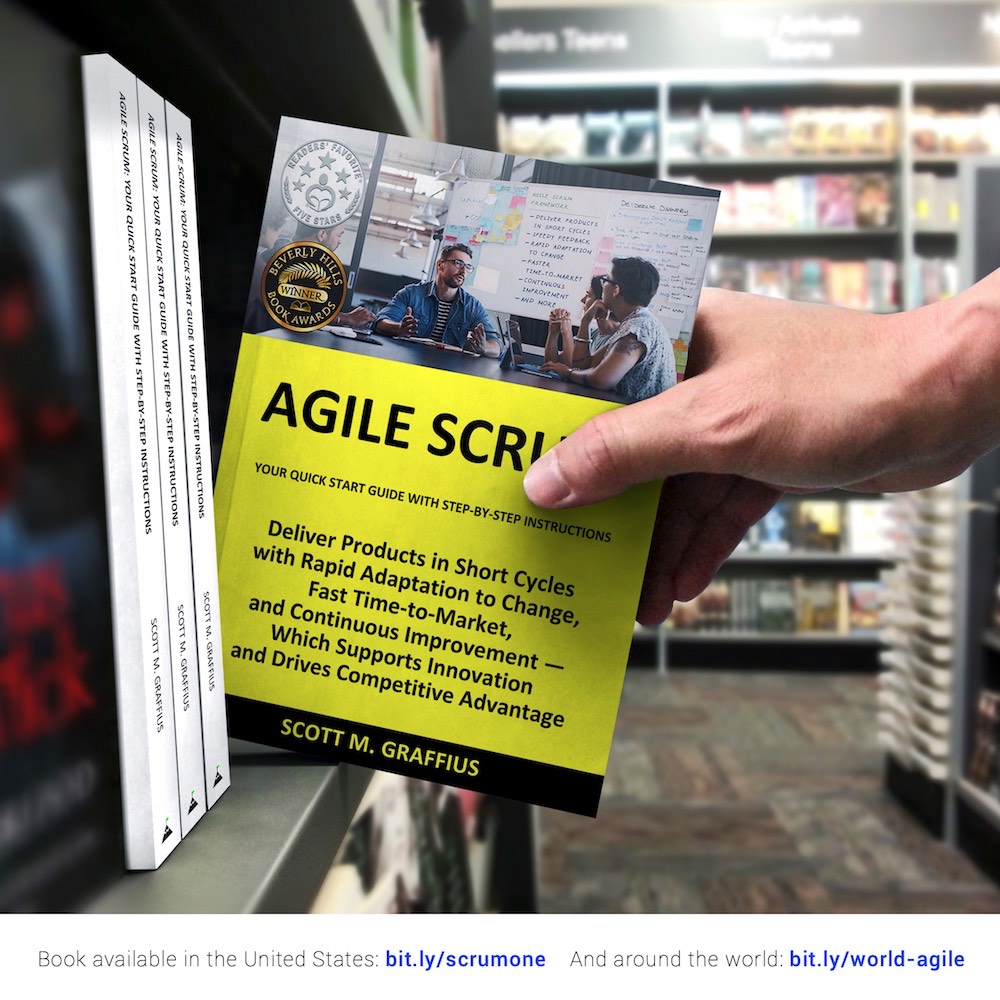
Shifting customer needs are common in today's marketplace. Businesses must be adaptive and responsive to change while delivering an exceptional customer experience to be competitive.
There are a variety of frameworks supporting the development of products and services, and most approaches fall into one of two broad categories: traditional or agile. Traditional practices such as waterfall engage sequential development, while agile involves iterative and incremental deliverables. Organizations are increasingly embracing agile to manage projects, and best meet their business needs of rapid response to change, fast delivery speed, and more.
With clear and easy to follow step-by-step instructions, Scott M. Graffius's award-winning Agile Scrum: Your Quick Start Guide with Step-by-Step Instructions helps the reader:
- Implement and use the most popular agile framework―Scrum;
- Deliver products in short cycles with rapid adaptation to change, fast time-to-market, and continuous improvement; and
- Support innovation and drive competitive advantage.
Hailed by Literary Titan as “the book highlights the versatility of Scrum beautifully.”
Winner of 17 first place awards.
Agile Scrum: Your Quick Start Guide with Step-by-Step Instructions is available in paperback and ebook/Kindle in the United States and around the world. Some links by country follow.
- 🇧🇷 Brazil
- 🇨🇦 Canada
- 🇨🇿 Czech Republic
- 🇩🇰 Denmark
- 🇫🇮 Finland
- 🇫🇷 France
- 🇩🇪 Germany
- 🇬🇷 Greece
- 🇭🇺 Hungary
- 🇮🇳 India
- 🇮🇪 Ireland
- 🇮🇱 Israel
- 🇮🇹 Italy
- 🇯🇵 Japan
- 🇱🇺 Luxembourg
- 🇲🇽 Mexico
- 🇳🇱 Netherlands
- 🇳🇿 New Zealand
- 🇳🇴 Norway
- 🇪🇸 Spain
- 🇸🇪 Sweden
- 🇨🇭 Switzerland
- 🇦🇪 UAE
- 🇬🇧 United Kingdom
- 🇺🇸 United States

About Agile Transformation: A Brief Story of How an Entertainment Company Developed New Capabilities and Unlocked Business Agility to Thrive in an Era of Rapid Change
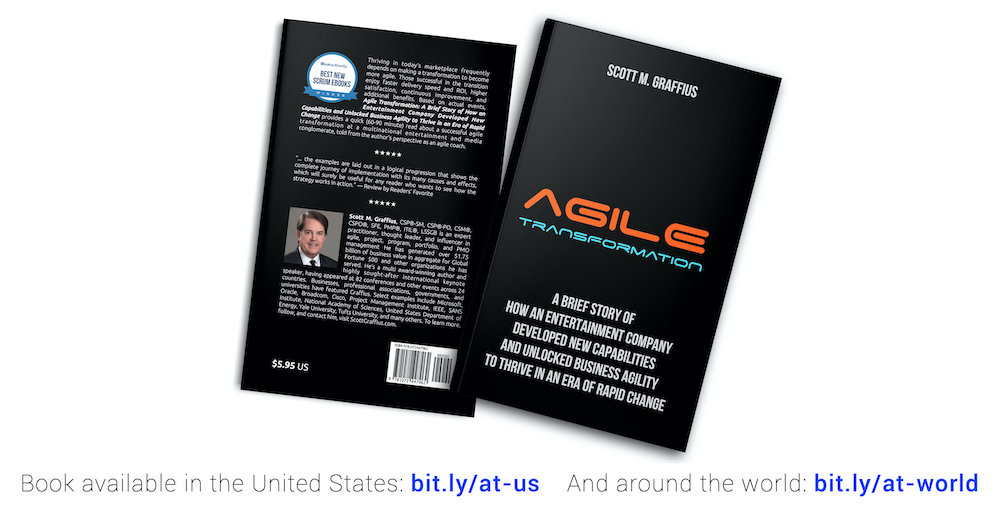
Thriving in today's marketplace frequently depends on making a transformation to become more agile. Those successful in the transition enjoy faster delivery speed and ROI, higher satisfaction, continuous improvement, and additional benefits.
Based on actual events, Agile Transformation: A Brief Story of How an Entertainment Company Developed New Capabilities and Unlocked Business Agility to Thrive in an Era of Rapid Change provides a quick (60-90 minute) read about a successful agile transformation at a multinational entertainment and media company, told from the author's perspective as an agile coach.
The award-winning book by Scott M. Graffius is available in paperback and ebook/Kindle in the United States and around the world. Some links by country follow.
- 🇦🇺 Australia
- 🇦🇹 Austria
- 🇧🇷 Brazil
- 🇨🇦 Canada
- 🇨🇿 Czech Republic
- 🇩🇰 Denmark
- 🇫🇮 Finland
- 🇫🇷 France
- 🇩🇪 Germany
- 🇬🇷 Greece
- 🇮🇳 India
- 🇮🇪 Ireland
- 🇯🇵 Japan
- 🇱🇺 Luxembourg
- 🇲🇽 Mexico
- 🇳🇱 Netherlands
- 🇳🇿 New Zealand
- 🇪🇸 Spain
- 🇸🇪 Sweden
- 🇨🇭 Switzerland
- 🇦🇪 United Arab Emirates
- 🇬🇧 United Kingdom
- 🇺🇸 United States

The short link for this article is https://bit.ly/theft-ip
© Copyright 2024 Scott M. Graffius. All rights reserved. This material may not be published, broadcast, rewritten or redistributed without the express written permission of Scott M. Graffius.

Using Bruce Tuckman's Phases of Team Development
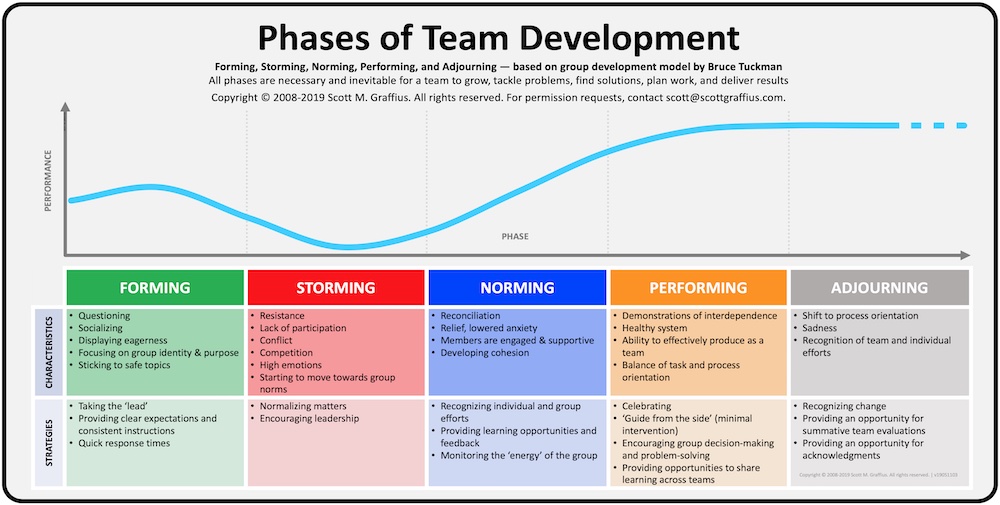
High Resolution Files of Visual: See Permission Request Information section

If there are any supplements or updates to this article after the date of publication, they will appear in the Post-Publication Notes section at the end of this article.

Teams go through stages of development, and Bruce Tuckman established a popular framework on the subject. According to Tuckman, all phases—Forming, Storming, Norming, Performing, and Adjourning—are necessary for the team to grow, tackle problems, find solutions, plan work, and deliver results. This article provides a brief overview of the model, including descriptions and strategies for each phase.

1. Forming
Characteristics of Forming include questioning, socializing, displaying eagerness, focusing on group identity and purpose, and sticking to safe topics. Strategies for this phase include taking the 'lead,' providing clear expectations and consistent instructions, and quick response times.
2. Storming
Traits of Storming include resistance, lack of participation, conflict, competition, high emotions, and moving towards group norms. Strategies for this stage include normalizing matters and encouraging leadership.
3. Norming
Features of Norming include reconciliation, relief, lowered anxiety, members are engaged and supportive, and developing cohesion. Strategies for this phase include recognizing individual and group efforts, providing learning opportunities and feedback, and monitoring the 'energy' of the group.
4. Performing
Characteristics of Performing include demonstrations of interdependence, healthy system, ability to effectively produce as a team, and balance of task and process orientation. Strategies for this stage include celebrating, 'guide from the side' (minimal intervention), encouraging group decision-making and problem-solving, and providing opportunities to share learning across teams.
5. Adjourning
Traits of Adjourning include a shift to process orientation, sadness, and recognition of team and individual efforts. Strategies for this phase include recognizing change, providing an opportunity for summative team evaluations, and providing an opportunity for acknowledgments.

The illustration summarizes the above information—and it shows how performance fluctuates as teams move through each phase. This information may be helpful for looking at your team.

Permission Request Information
To request permission to use the 'Phases of Team Development' visual, contact Scott M. Graffius. If approved, high resolution JPG and PNG image files will be provided, subject to terms and conditions.


Post-Publication Notes
Update on 7 January 2025
Scott M. Graffius periodically updates his 'Phases of Team Development' work. The most current edition is here.

© Copyright 2018 Scott M. Graffius. All rights reserved. This material may not be published, broadcast, rewritten or redistributed without the express written permission of Scott M. Graffius.

The Spanish Version of the 'Phases of Team Development' -- 'Fases del Desarrollo del Equipo' -- Now Available
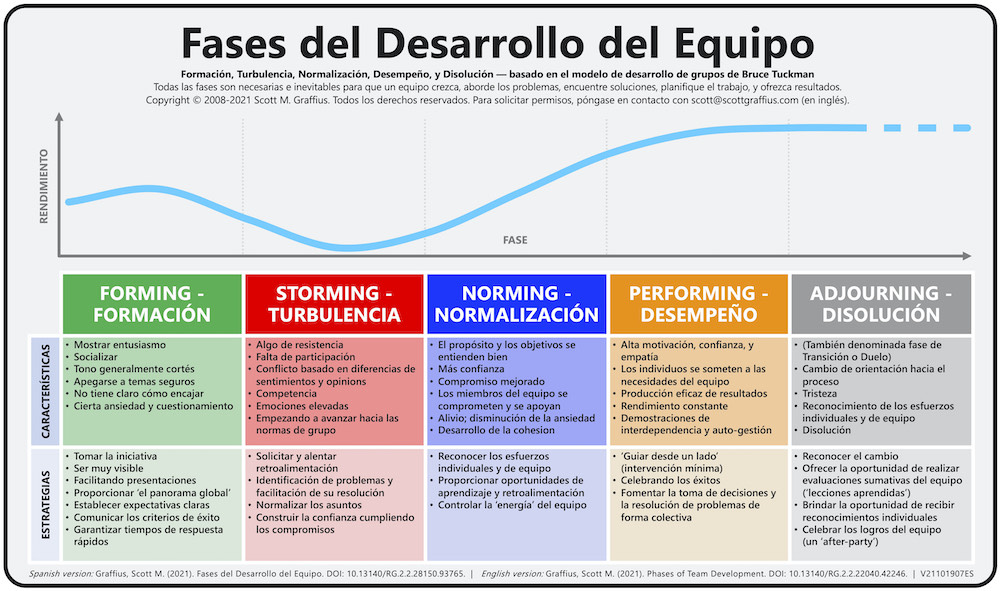
For permission requests and high resolution images, see below.
Phases of Team Development
Teams go through phases of development, and Dr. Bruce Tuckman established a popular and durable framework on the subject. According to Dr. Tuckman, all phases—Forming, Storming, Norming, Performing, and Adjourning—are necessary for teams to grow, tackle problems, find solutions, plan work, and deliver results.
Agile project management thought leader, influencer, and author Scott M. Graffius developed a related custom illustration, Phases of Team Development. It highlights the performance level, characteristics, and proven strategies for each of the phases. Project Managers, Scrum Masters, Agile Coaches, DevOps Leads, and other professionals can apply the information to help handle challenges or issues experienced by teams. By doing so, they’ll advance the teams' happiness and productivity, as well as the teams' (and their own) success. Graffius updates the content periodically.
Graffius translated his 'Phases of Team Development' intellectual property into Spanish: 'Fases del Desarrollo del Equipo' — Formación (Forming), Turbulencia (Storming), Normalización (Norming), Desempeño (Performing), and Disolución (Adjourning).
Sometimes, different words are used for the phases. For example, 'Storming' is translated as 'Turbulencia' — but 'Conflicto' or other alternatives are occasionally used instead. This article and the related Fases del Desarrollo del Equipo illustration incorporate the selections for phases referenced in the Spanish version of the Project Management Institute's A Guide to the Project Management Body of Knowledge. The five phases in Spanish are: Formación, Turbulencia, Normalización, Desempeño, y Disolución.
More on the Spanish version follows.


Permission Request Information
For permission requests to use Graffius' 'Fases del Desarrollo del Equipo' visual, contact Scott M. Graffius in English. If your request is approved, Graffius will give you an authorization/license and, if applicable, high-resolution file(s) of the visual.


How to Cite This Article
Graffius, Scott M. (2021, October 19). The Spanish Version of the 'Phases of Team Development' -- 'Fases del Desarrollo del Equipo' -- Now Available. Available at: https://scottgraffius.com/blog/files/equipo-21.html.
How to Cite Only the Visual
Graffius, Scott M. (2021). Fases del Desarrollo del Equipo. Digital Object Identifier (DOI): 10.13140/RG.2.2.28150.93765. DOI link: https://dx.doi.org/10.13140/RG.2.2.28150.93765.

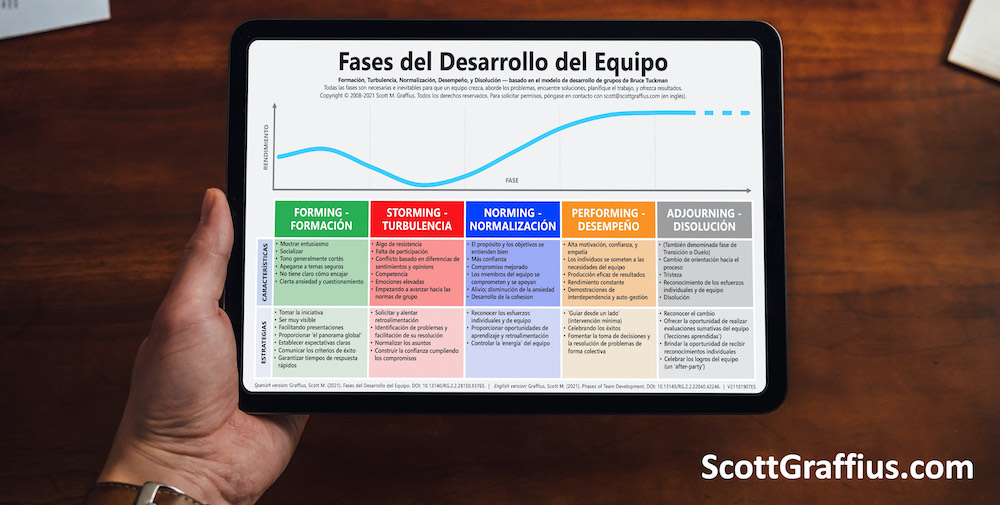
For information on the English version of the Phases of Team Development, visit here.

About Scott M. Graffius
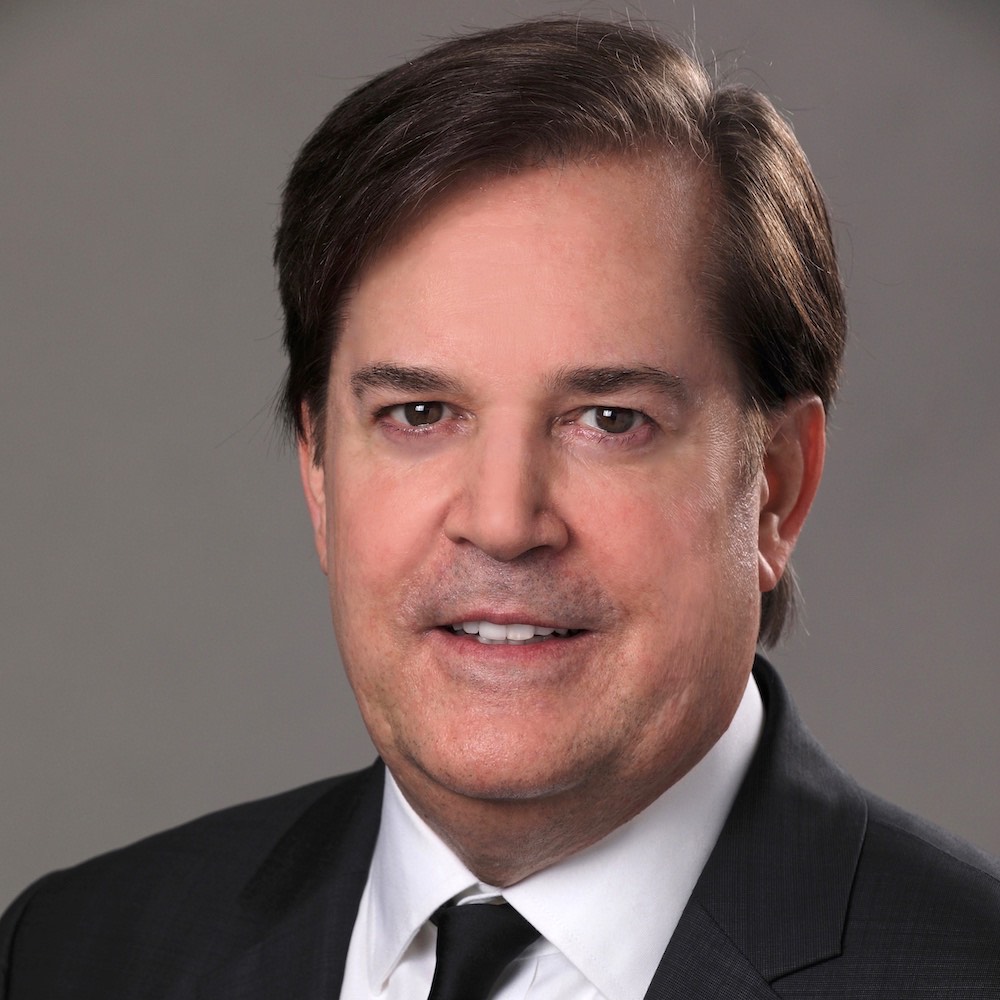
Scott M. Graffius, PMP, CSP-SM, CSP-PO, CSM, CSPO, SFE, ITIL, LSSGB is an agile project management practitioner, consultant, award-winning author, and international speaker. He has generated over one billion dollars of business value in aggregate for the organizations he has served. Graffius is the founder, CEO, and principal consultant at Exceptional PPM and PMO Solutions™ and subsidiary Exceptional Agility™, based in Los Angeles, California. His expertise spans project, program, portfolio, and PMO leadership inclusive of agile, traditional, and hybrid approaches. Content from his books, workshops, speaking engagements, and more have been featured and used by businesses, governments, and universities including Gartner, Microsoft, Deloitte, Oracle, Cisco, Ford, Qantas, Atlassian, Bayer, the National Academy of Sciences, the United States Department of Energy, the United States Army, Project Management Institute, the IEEE, the New Zealand Ministry of Education, Tufts University, Texas A&M University, Virginia Tech, Penn State, Warsaw University of Technology, University of Waterloo, Loughborough University London, and others. Graffius has spoken at 58 conferences and other events around the world, including Armenia, Australia, Brazil, Canada, Czech Republic, Finland, France, Germany, Greece, India, Ireland, Lithuania, Luxembourg, Netherlands, New Zealand, Sweden, United Kingdom, and the United States. Thinkers360 named Graffius a global top thought leader and influencer in four domains: Agile, Change Management, Digital Transformation, and GovTech.
His full bio is available here.
Connect with Scott on:
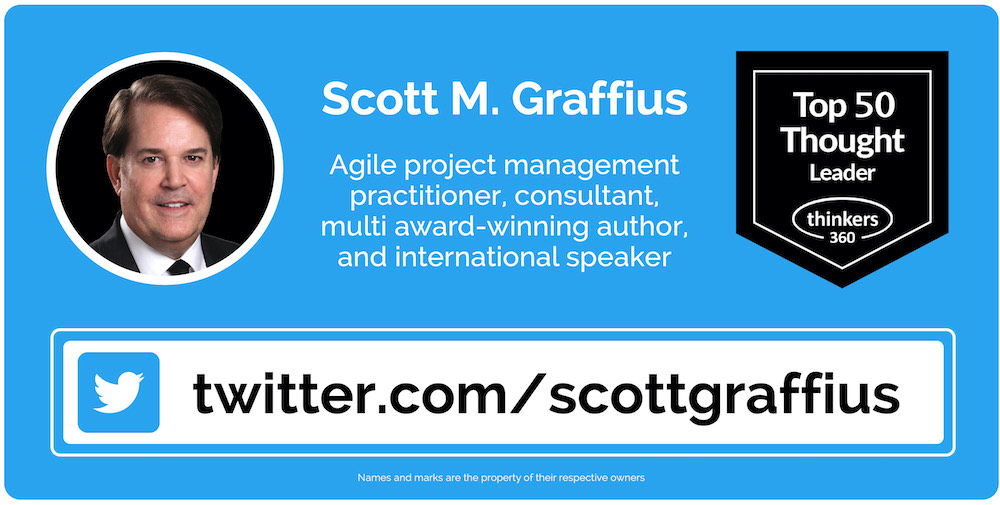


Copyright
Copyright © Scott M. Graffius. All rights reserved. This material may not be published, broadcast, rewritten or redistributed without the express written permission of Scott M. Graffius.

Bruce Tuckman’s Model (Forming, Storming, Norming, Performing, and Adjourning) is Highly Relevant and Beneficial, But It Doesn’t Please Everyone
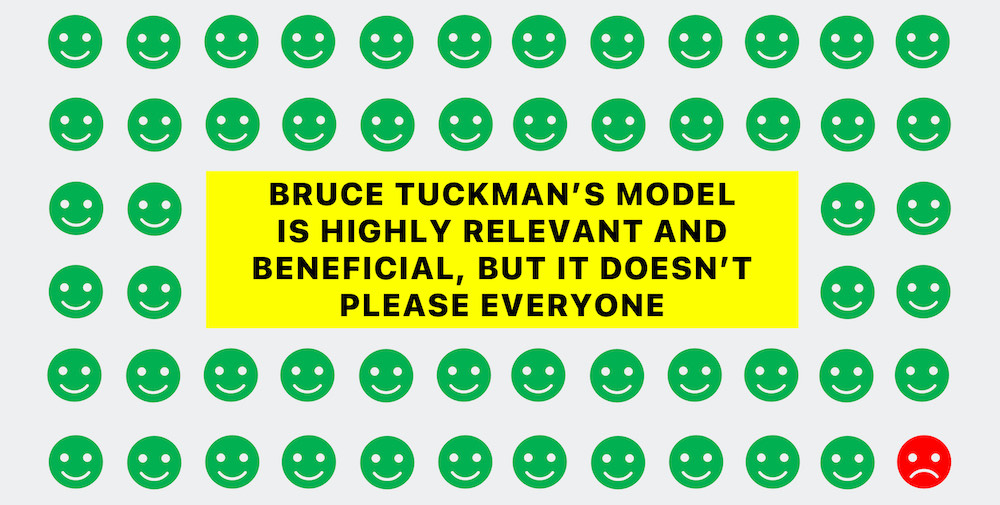
Names and certain identifying details are not included or are redacted (replaced with black rectangles) to respect privacy.

The Question
Steve Jobs famously said: “You can please some of the people some of the time” in response to a tough question at the 1997 Worldwide Developer Conference. The following experience reminded me of that quote.
In a recent workshop on team leadership, a student asked me, “What do you think about █████████’s disregard of Tuckman’s model?” (Note: The student was referring to a person who's a leader in Agile and Scrum. That person's name is redacted, subsequently referred to as “critic.” His or her stance seems to be the rare exception.) I’m detailing my response here.

The Background for Context
Bruce Tuckman (Ph.D. in Psychology from Princeton University) conducted extensive research on group dynamics, and he published a related model in 1965. At that time, the model included four phases: forming, storming, norming, and performing. However, Dr. Tuckman subsequently determined that adjourning was so important that he (with Mary Ann Jensen) updated his model in 1977 to add adjourning as the fifth phase. In the context of this discussion, phases and stages may be used interchangeably; and group dynamics is also referred to as group development, team dynamics, and team development.
Dr. Tuckman’s model has stood the test of time because it remains highly relevant and beneficial. Since his related work was published, it has been supported by additional peer-reviewed research. And it has received recommendations and coverage from leading organizations including Google, Harvard Business Review, IEEE, Forbes, MIT, Fast Company, NASA, Microsoft, TNW, Project Management Institute, Scrum Alliance, Scrum.org, Association for Project Management, Gartner, CIO, Spotify, Imperial College London, RAND Corporation, Princeton University, Software Engineering Institute, University of Edinburgh, Cisco, KPMG, Warsaw University of Technology, DevOps Institute, American Express, SANS Institute, Zurich University, SAP, ViacomCBS, Oxford University, American Management Association, AT&T, University of Southern California, IBM, and many others.
While Tuckman’s model is durable and relevant, no model is perfect. It can be helpful to understand any concerns or limitations—with an emphasis on any which are independently verifiable and are published in peer-reviewed studies.
I related to the student that there are critics of Tuckman’s model, but that they’re few—and I’m not familiar with criticisms meeting the aforementioned rigor of being independently verifiable with such findings appearing in peer-reviewed studies.
I said, for example, that I was already aware of the critic's stated disregard of Bruce Tuckman’s model. I previously looked into the situation to learn more. My research and findings follow.

The Research and Findings
In a █████ communication, the critic said “I never liked ...” referring to Tuckman’s model. He or she went on to state that his or her reason was that “Gersick tested it ...” (Tuckman’s model) and “...it’s not true.” The critic included a link to the paper which was the basis for his or her stance. The link goes to the following paper:
Curtis, B., Walz, D., and Elam, J. (1990, October 1). Studying the Process of Software Design Teams. In: ISPW '90: Proceedings of the 5th International Software Process Workshop on Experience with Software Process Models, pages 52-53.
The critic said that “Gersick tested it” and pointed to the paper. However, Gersick is not an author on the paper. Still, I reviewed the content to see what, if anything, the authors (Curtis, Walz, and Elam) said about Tuckman, Tuckman’s model, and/or Gersick. Here’s what I found.
On Tuckman: Tuckman was not mentioned anywhere in the paper.
On Tuckman’s model (a reference to forming, storming, norming, performing, and/or adjourning): The following appears: “Rather than the standard group process of form-storm-norm-perform, Gersick suggested there came a point halfway through a group project where the team faced its lack of progress.”
On Gersick: Gersick was mentioned four times: “Gersick (1988) observed such a point in a study of project teams” and “Rather than the standard group process of form-storm-norm-perform, Gersick suggested there came a point halfway through a group project where the team faced its lack of progress” and “Gersick's model may be more descriptive of temporary teams that are asked to perform tasks out of their area of expertise” and (a reference citation) “Gersick, C.J.G. (1988). Time and Transition in Work Teams: Toward a New Model of Work Development. Academy of Management Journal, 31 (1), 9-41.”
The critic said that “Gersick tested it” ... and “...it’s not true.” However, as a summary of the above, Gersick is not the author of the paper, and the authors (Curtis, Walz, and Elam) commented that Tuckman’s model did not seem to work for one project. On that one project, “Rather than ... form-storm-norm-perform ... there came a point halfway through ... where the team faced its lack of progress.” That does not negate Tuckman’s model. While teams typically move through the different phases, it’s entirely possible for a team to face a lack of progress at a given time. Phases don’t progress magically; the phase is a marker of the team’s current progress and effectiveness. The critic said that “Gersick tested it” ... and “...it’s not true.” The research specified by the critic did not state that it tested Tuckman’s model and found it to not be true. The research specified by the critic does not support his or her stand. Nevertheless, I dug deeper.
The above paper by Curtis, Walz, and Elam includes Gersick’s work as a reference. I found and carefully reviewed Gersick’s respective research. Again, it’s: “Gersick, C.J.G. (1988). Time and Transition in Work Teams: Toward a New Model of Work Development. Academy of Management Journal, 31 (1), 9-41.” I looked to see what Gersick said about Tuckman or his model. Here’s what I discovered.
Tuckman was mentioned five times: “There was no initial ‘storming’ (Tuckman, 1965; Tuckman & Jensen, 1977) in this group” and “First, as Tuckman pointed out in 1965 and others have noted up to the present (Hare, 1976; McGrath, 1986; Poole, 1983b), they offer snapshots of groups at different points in their life-spans but say little about the mechanisms of change” and “Since all teams were doing construction work on their projects during phase 2, similar to ‘performing’ in Tuckman’s (1965) synthesis, it was a time when teams were more similar to both each other and to the traditional model than they were in phase 1” and (a reference citation) “Tuckman, B. 1965. Developmental Sequence in Small Groups. Psychological Bulletin, 63: 384-399” and (another reference citation) “Tuckman, B., & Jensen, M. 1977. Stages of Small-Group Development. Group and Organizational Studies, 2: 419-427.”
The critic said that “Gersick tested it” ... and “...it’s not true.” However, as a summary of the above, Gersick did not state that Tuckman’s model was tested and found to not be true. For example, Gersick did not say that there was no storming; rather, it was qualified as “no initial ‘storming.’” Furthermore, and most importantly, Gersick provided the following caveat: “This study must be interpreted with caution. It was hypothesis-generating, not hypothesis-testing; the model is expressly provisional.” According to Gersick, the research did not test or prove anything.
The research—both the paper pointed to by the critic, and the reference study—does not supply the stated basis for the critic's stance.

The Conclusion with the Answer
In conclusion, Tuckman’s model has stood the test of time because it remains highly relevant and beneficial. No model is perfect, and it is helpful to understand any concerns or limitations—with an emphasis on any which are independently verifiable and are published in peer-reviewed studies.
My answer to the student’s question (“What do you think about █████████’s disregard of Tuckman’s model?”) was that I diligently reviewed the facts and neither the paper linked to by the critic, nor the other study cited by the paper, support the critic’s assertion that “Gersick tested it ...” (Tuckman’s model) and “...it’s not true.”
Maybe—or maybe not—the critic's view of the model is because of a misunderstanding regarding the research. Or maybe—or maybe not—there's another reason. As Steve Jobs said, “You can please some of the people some of the time.”



The Phases of Team Development Visual
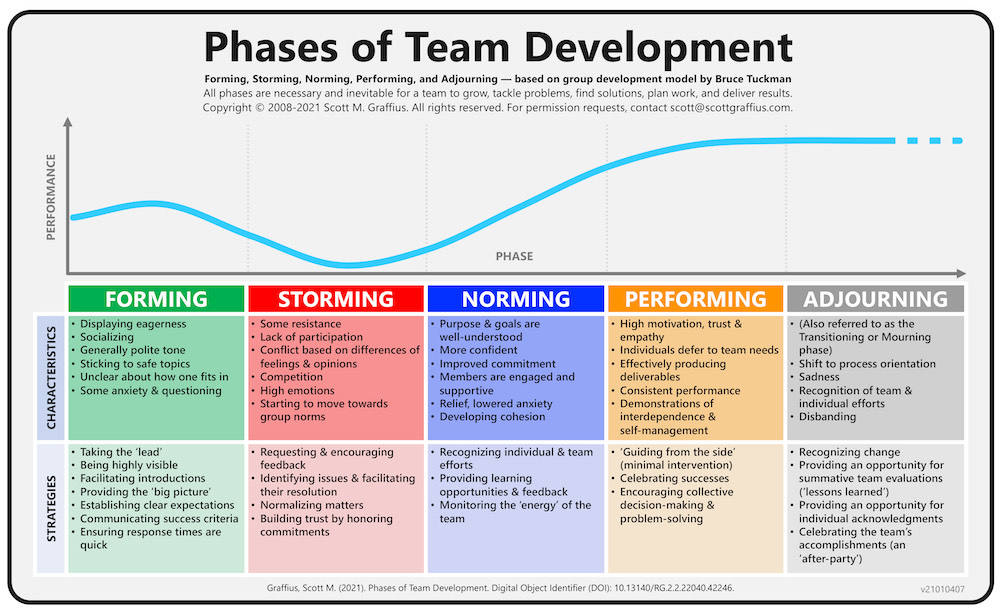
🔥 Update: The newest version is here.

About Scott M. Graffius

Scott M. Graffius, PMP, CSP-SM, CSP-PO, CSM, CSPO, SFE, ITIL, LSSGB is an agile project management practitioner, consultant, award-winning author, and international speaker. He has generated over 1.75 billion dollars of business value in aggregate for the organizations he has served. Graffius is the founder, CEO, and principal consultant at Exceptional PPM and PMO Solutions™ and subsidiary Exceptional Agility™, based in Los Angeles, California. His expertise spans project, program, portfolio, and PMO leadership inclusive of agile, traditional, and hybrid approaches. Content from his books (Agile Scrum and Agile Transformation), workshops, speaking engagements, and more have been featured and used by businesses, governments, and universities including Gartner, Microsoft, Deloitte, Oracle, Cisco, Ford, Qantas, Atlassian, Bayer, the National Academy of Sciences, the United States Department of Energy, the United States Army, Project Management Institute, the IEEE, the New Zealand Ministry of Education, Tufts University, Texas A&M University, Virginia Tech, Penn State, Warsaw University of Technology, University of Waterloo, Loughborough University London, and others. Graffius has spoken at 58 conferences and other events around the world, including Armenia, Australia, Brazil, Canada, Czech Republic, Finland, France, Germany, Greece, India, Ireland, Lithuania, Luxembourg, Netherlands, New Zealand, Sweden, United Kingdom, and the United States. Thinkers360 named Graffius a global top thought leader and influencer in four domains: Agile, Change Management, Digital Transformation, and GovTech.
His full bio is available here.
Connect with Scott on:


About Agile Scrum: Your Quick Start Guide with Step-by-Step Instructions

Shifting customer needs are common in today's marketplace. Businesses must be adaptive and responsive to change while delivering an exceptional customer experience to be competitive.
There are a variety of frameworks supporting the development of products and services, and most approaches fall into one of two broad categories: traditional or agile. Traditional practices such as waterfall engage sequential development, while agile involves iterative and incremental deliverables. Organizations are increasingly embracing agile to manage projects, and best meet their business needs of rapid response to change, fast delivery speed, and more.
With clear and easy to follow step-by-step instructions, Scott M. Graffius's award-winning Agile Scrum: Your Quick Start Guide with Step-by-Step Instructions helps the reader:
- Implement and use the most popular agile framework―Scrum;
- Deliver products in short cycles with rapid adaptation to change, fast time-to-market, and continuous improvement; and
- Support innovation and drive competitive advantage.
Hailed by Literary Titan as “the book highlights the versatility of Scrum beautifully.”
Winner of 17 first place awards.
Agile Scrum: Your Quick Start Guide with Step-by-Step Instructions is available in paperback and ebook/Kindle in the United States and around the world. Some links by country follow.
- 🇧🇷 Brazil
- 🇨🇦 Canada
- 🇨🇿 Czech Republic
- 🇩🇰 Denmark
- 🇫🇮 Finland
- 🇫🇷 France
- 🇩🇪 Germany
- 🇬🇷 Greece
- 🇭🇺 Hungary
- 🇮🇳 India
- 🇮🇪 Ireland
- 🇮🇱 Israel
- 🇮🇹 Italy
- 🇯🇵 Japan
- 🇱🇺 Luxembourg
- 🇲🇽 Mexico
- 🇳🇱 Netherlands
- 🇳🇿 New Zealand
- 🇳🇴 Norway
- 🇪🇸 Spain
- 🇸🇪 Sweden
- 🇨🇭 Switzerland
- 🇦🇪 UAE
- 🇬🇧 United Kingdom
- 🇺🇸 United States

About Agile Transformation: A Brief Story of How an Entertainment Company Developed New Capabilities and Unlocked Business Agility to Thrive in an Era of Rapid Change

Thriving in today's marketplace frequently depends on making a transformation to become more agile. Those successful in the transition enjoy faster delivery speed and ROI, higher satisfaction, continuous improvement, and additional benefits.
Based on actual events, Agile Transformation: A Brief Story of How an Entertainment Company Developed New Capabilities and Unlocked Business Agility to Thrive in an Era of Rapid Change provides a quick (60-90 minute) read about a successful agile transformation at a multinational entertainment and media company, told from the author's perspective as an agile coach.
The award-winning book by Scott M. Graffius is available in paperback and ebook/Kindle in the United States and around the world. Some links by country follow.
- 🇦🇺 Australia
- 🇦🇹 Austria
- 🇧🇷 Brazil
- 🇨🇦 Canada
- 🇨🇿 Czech Republic
- 🇩🇰 Denmark
- 🇫🇮 Finland
- 🇫🇷 France
- 🇩🇪 Germany
- 🇬🇷 Greece
- 🇮🇳 India
- 🇮🇪 Ireland
- 🇯🇵 Japan
- 🇱🇺 Luxembourg
- 🇲🇽 Mexico
- 🇳🇱 Netherlands
- 🇳🇿 New Zealand
- 🇪🇸 Spain
- 🇸🇪 Sweden
- 🇨🇭 Switzerland
- 🇦🇪 United Arab Emirates
- 🇬🇧 United Kingdom
- 🇺🇸 United States

The short URL for this article is: https://bit.ly/tckmn
Posts related to this article are on Twitter and Instagram (via @AgileScrumGuide)
© Copyright 2021 Scott M. Graffius. All rights reserved. This material may not be published, broadcast, rewritten or redistributed without the express written permission of Scott M. Graffius.

Aerospace Company Deimos Space Featured Scott M. Graffius' 'Phases of Team Development' Work
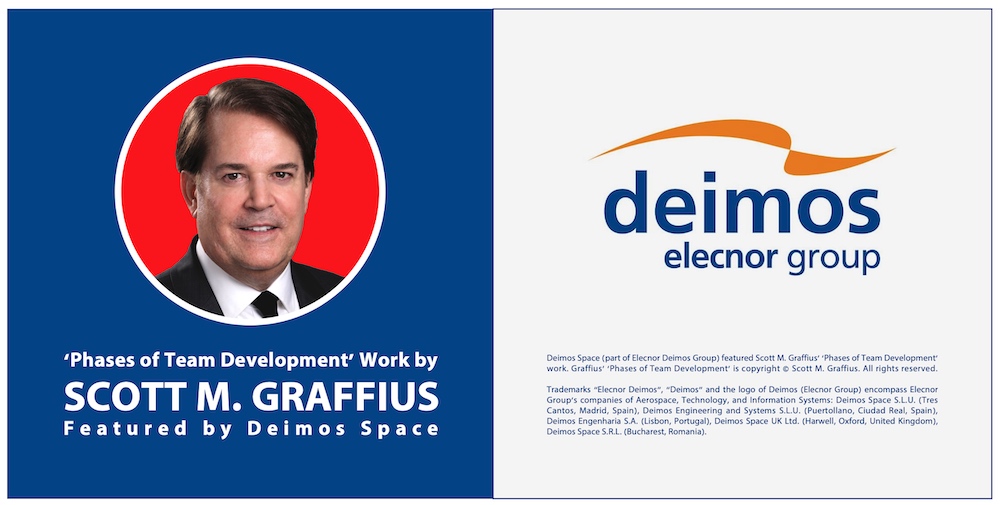
Informed by the research of Bruce W. Tuckman and Mary Ann C. Jensen, over 100 subsequent studies, and Scott M. Graffius' first-hand professional experience with, and analysis of, team leadership and performance, Graffius created his ‘Phases of Team Development’ as a unique perspective and visual conveying the five phases of team development — Forming, Storming, Norming, Performing, and Adjourning — inclusive of a graph showing how performance varies by phase, as well as the characteristics and strategies for each phase.
With permission/a license from Graffius, his ‘Phases of Team Development’ work is used by businesses, professional associations, governments, and universities around the world. Examples include Yale University, IEEE, Torrens University Australia, UK Sports Institute, Adobe, Amsterdam Public Health Research Institute, Academic Cooperation Association, Boston University, U.S. National Park Service, Bayer, Hasso Plattner Institute (Hasso-Plattner-Institut für Digital Engineering GmbH), Singapore University of Social Sciences, New Zealand Government, University of Galway Ireland, and many more.
Deimos Space, a leading Aerospace company, was added to the list.
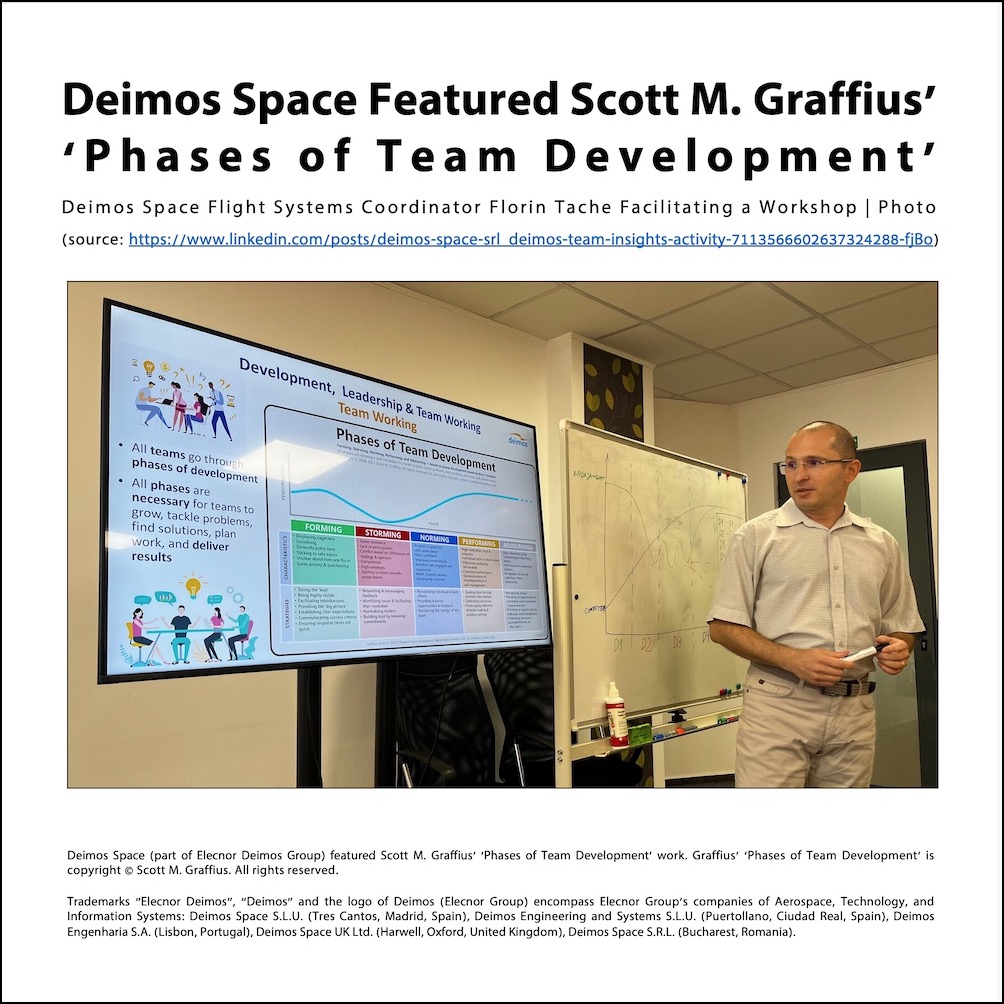
As shown above, Deimos Space featured Scott M. Graffius' 'Phases of Team Development' work during a training.
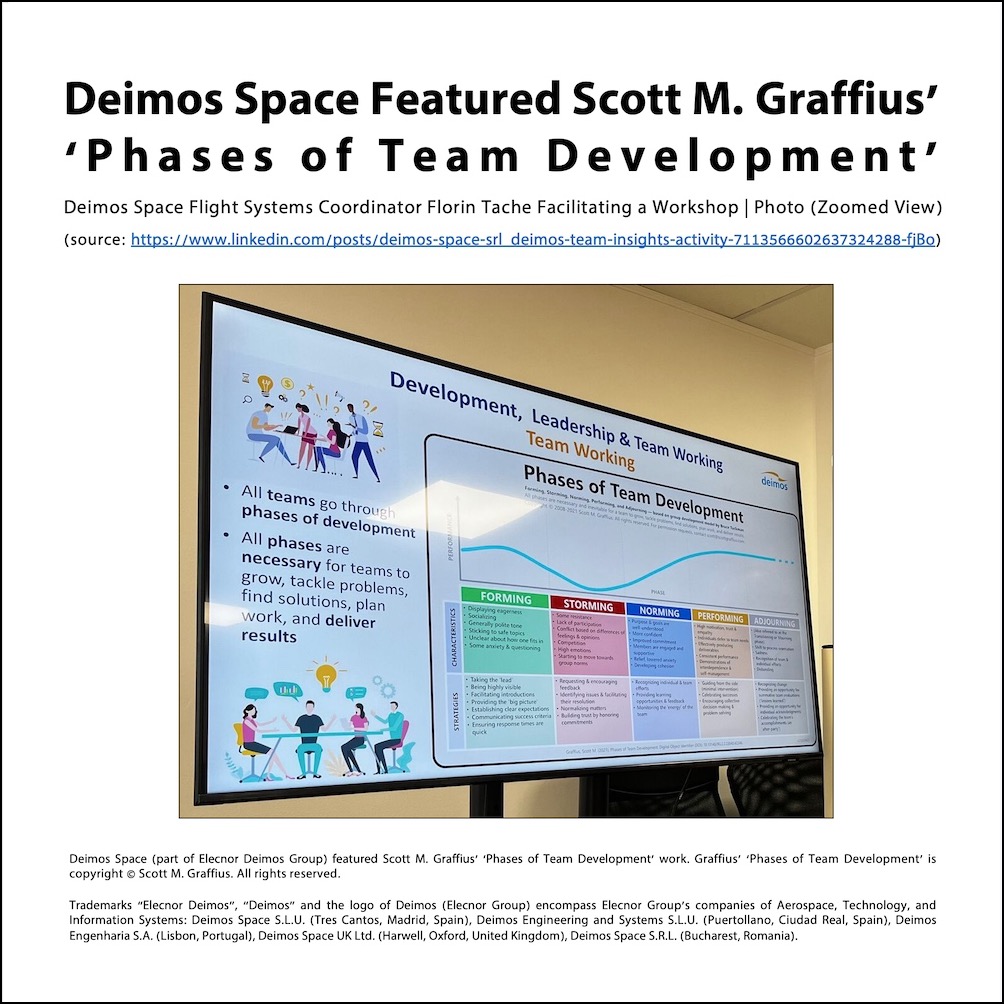
A zoomed-in version of the photo is shown above.
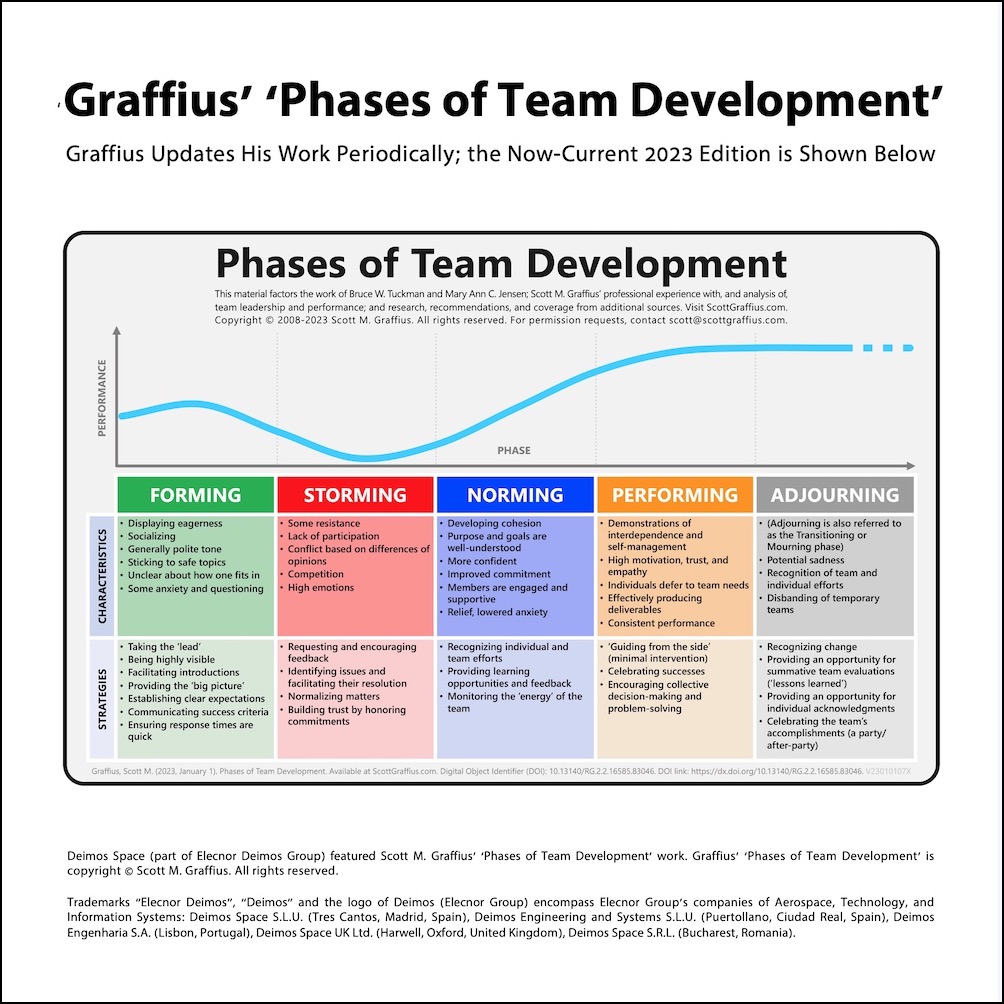
Graffius periodically updates his work. The most current (2023) edition of his 'Phases of Team Development' visual is shown above. Select here for details.
About Deimos Space
Deimos Space (part of Elecnor Deimos Group) is a leading company in the European Aerospace sector with an extensive portfolio of projects and solutions employed at the European Space Agency (ESA) and other organizations. Its expertise includes Satellite Navigation Systems, Space Situational Awareness, Mission Analysis and Design, Guidance Navigation and Control, Ground Segment Systems, and more. Visit their website — here — to learn more.




About Scott M. Graffius
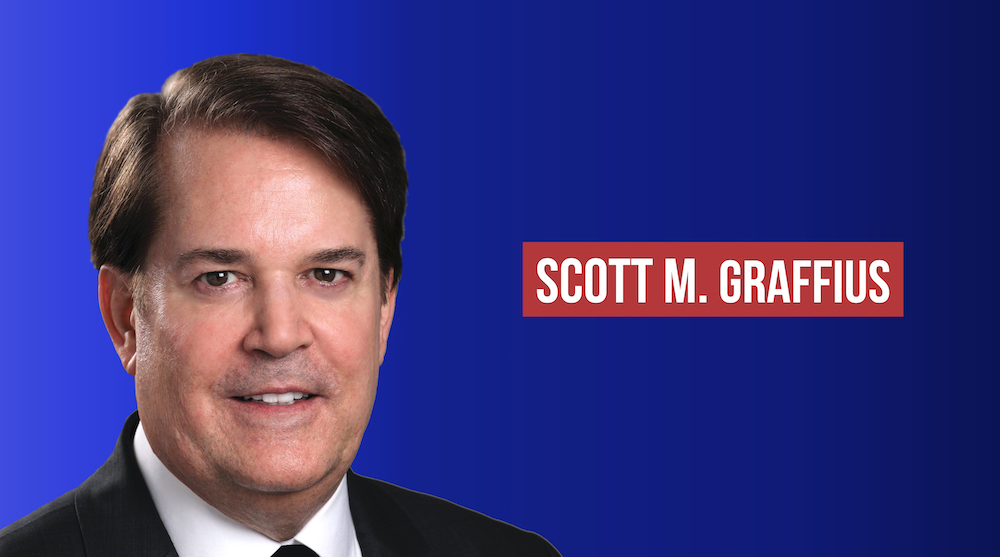
Scott M. Graffius, PMP, SA, CSP-SM, CSP-PO, CSM, CSPO, SFE, ITIL, LSSGB is an agile project management practitioner, consultant, multi-award-winning author, and international keynote speaker. He is the Founder of Exceptional PPM and PMO Solutions™ and subsidiary Exceptional Agility™. He has generated over $1.9 billion of business value in aggregate for Global Fortune 500 businesses and other organizations he has served. Graffius and content from his books, talks, workshops, and more have been featured and used by businesses, professional associations, governments, and universities. Examples include Microsoft, Oracle, Broadcom, Cisco, Gartner, Project Management Institute, IEEE, Qantas, National Academy of Sciences, United States Department of Energy, New Zealand Ministry of Education, Yale University, Tufts University, and others. He has delighted audiences with dynamic and engaging talks and workshops on agile, project management, and technology (including AI) leadership at 87 conferences and other events across 25 countries.
His full bio is available here.
Connect with Scott on:
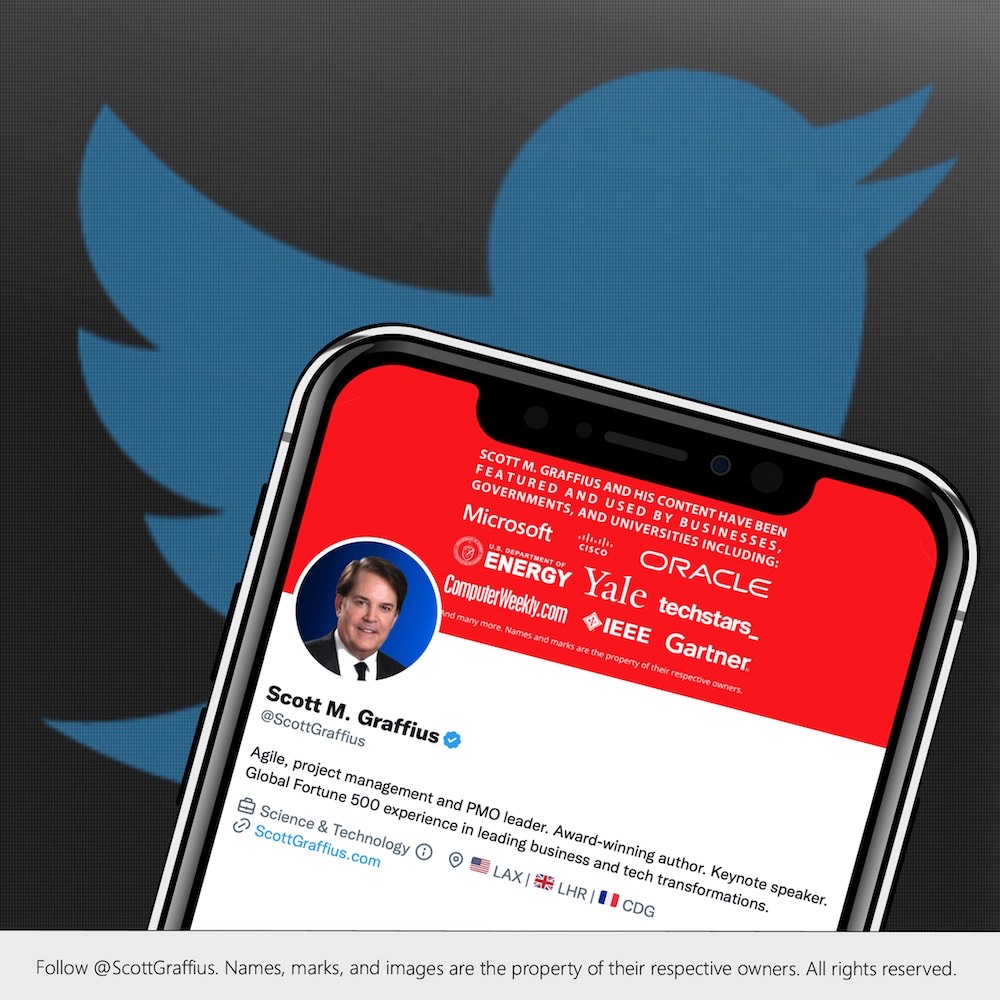

About Agile Scrum: Your Quick Start Guide with Step-by-Step Instructions

Shifting customer needs are common in today's marketplace. Businesses must be adaptive and responsive to change while delivering an exceptional customer experience to be competitive.
There are a variety of frameworks supporting the development of products and services, and most approaches fall into one of two broad categories: traditional or agile. Traditional practices such as waterfall engage sequential development, while agile involves iterative and incremental deliverables. Organizations are increasingly embracing agile to manage projects, and best meet their business needs of rapid response to change, fast delivery speed, and more.
With clear and easy to follow instructions, the multi award-winning Agile Scrum: Your Quick Start Guide with Step-by-Step Instructions book by Scott M. Graffius (Chris Hare and Colin Giffen, Technical Editors) helps the reader:
- Implement and use the most popular agile framework―Scrum;
- Deliver products in short cycles with rapid adaptation to change, fast time-to-market, and continuous improvement; and
- Support innovation and drive competitive advantage.
Hailed by Literary Titan as “the book highlights the versatility of Scrum beautifully.”
Winner of 17 first place awards.
Agile Scrum: Your Quick Start Guide with Step-by-Step Instructions is available in paperback and ebook/Kindle in the United States and around the world. Some links by country follow.
- 🇧🇷 Brazil
- 🇨🇦 Canada
- 🇨🇿 Czech Republic
- 🇩🇰 Denmark
- 🇫🇮 Finland
- 🇫🇷 France
- 🇩🇪 Germany
- 🇬🇷 Greece
- 🇭🇺 Hungary
- 🇮🇳 India
- 🇮🇪 Ireland
- 🇮🇱 Israel
- 🇮🇹 Italy
- 🇯🇵 Japan
- 🇱🇺 Luxembourg
- 🇲🇽 Mexico
- 🇳🇱 Netherlands
- 🇳🇿 New Zealand
- 🇳🇴 Norway
- 🇪🇸 Spain
- 🇸🇪 Sweden
- 🇨🇭 Switzerland
- 🇦🇪 UAE
- 🇬🇧 United Kingdom
- 🇺🇸 United States

About Agile Transformation: A Brief Story of How an Entertainment Company Developed New Capabilities and Unlocked Business Agility to Thrive in an Era of Rapid Change

Thriving in today's marketplace frequently depends on making a transformation to become more agile. Those successful in the transition enjoy faster delivery speed and ROI, higher satisfaction, continuous improvement, and additional benefits.
Based on actual events, Agile Transformation: A Brief Story of How an Entertainment Company Developed New Capabilities and Unlocked Business Agility to Thrive in an Era of Rapid Change provides a quick (60-90 minute) read about a successful agile transformation at a multinational entertainment and media company, told from the author's perspective as an agile coach.
The award-winning book by Scott M. Graffius is available in paperback and ebook/Kindle in the United States and around the world. Some links by country follow.
- 🇦🇺 Australia
- 🇦🇹 Austria
- 🇧🇷 Brazil
- 🇨🇦 Canada
- 🇨🇿 Czech Republic
- 🇩🇰 Denmark
- 🇫🇮 Finland
- 🇫🇷 France
- 🇩🇪 Germany
- 🇬🇷 Greece
- 🇮🇳 India
- 🇮🇪 Ireland
- 🇯🇵 Japan
- 🇱🇺 Luxembourg
- 🇲🇽 Mexico
- 🇳🇱 Netherlands
- 🇳🇿 New Zealand
- 🇪🇸 Spain
- 🇸🇪 Sweden
- 🇨🇭 Switzerland
- 🇦🇪 United Arab Emirates
- 🇬🇧 United Kingdom
- 🇺🇸 United States

The short URL for this article is: https://bit.ly/space-23.
© Copyright 2023 Scott M. Graffius. All rights reserved. This material may not be published, broadcast, rewritten or redistributed without the express written permission of Scott M. Graffius.

Graffius' 'Phases of Team Development' Featured by TAG at TBS24 Conference in Zermatt Switzerland
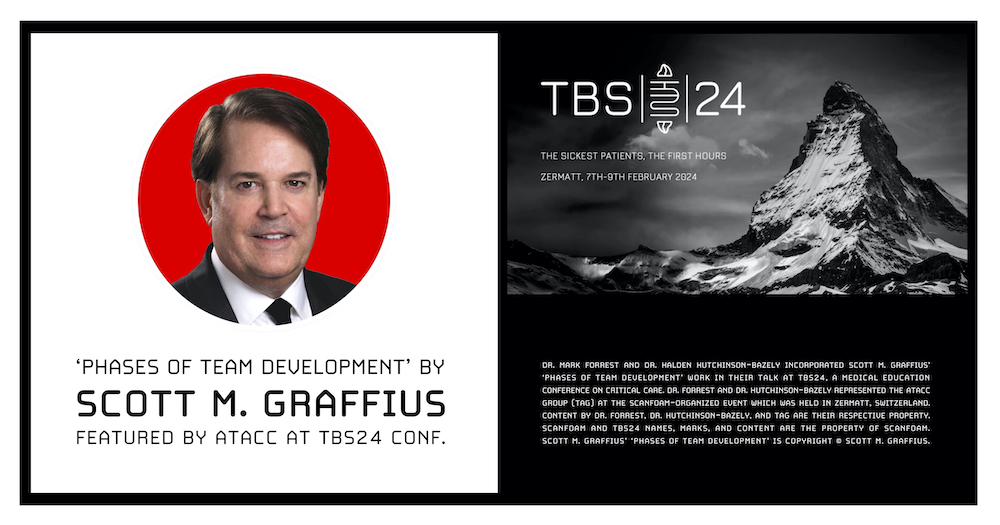

Informed by the research of Bruce W. Tuckman and Mary Ann C. Jensen, over 100 subsequent studies, and Scott M. Graffius' first-hand professional experience with, and analysis of, team leadership and performance, Graffius created his 'Phases of Team Development' as a unique perspective and visual conveying the five phases of team development — Forming, Storming, Norming, Performing, and Adjourning — inclusive of a graph showing how performance varies by phase, as well as the characteristics and strategies for each phase.
Leaders of teams can apply the information to help handle challenges or issues experienced by teams. By doing so, they’ll advance the teams' (and their own) happiness, productivity, and success.
Graffius initially developed the material in 2008, and he periodically refreshes it. For details on the current (2024) edition including permission request information, high resolution files, and more, visit here.
Graffius' 'Phases of Team Development' work is used by businesses, professional associations, government agencies, and universities around the world. Examples include Yale University, IEEE, Constructor Institute (Switzerland), Adobe, Boston University, Amsterdam Public Health Research Institute, United States National Park Service, Cisco, Bayer, Ford, University of Galway (Ireland), Hasso Plattner Institute (Germany), American Management Association, UC San Diego, and many more.
The ATACC Group (TAG) was added to the list. Dr. Mark Forrest and Dr. Halden Hutchinson-Bazely from TAG incorporated Graffius' 'Phases of Team Development' in their talk at TBS24 in Zermatt, Switzerland.
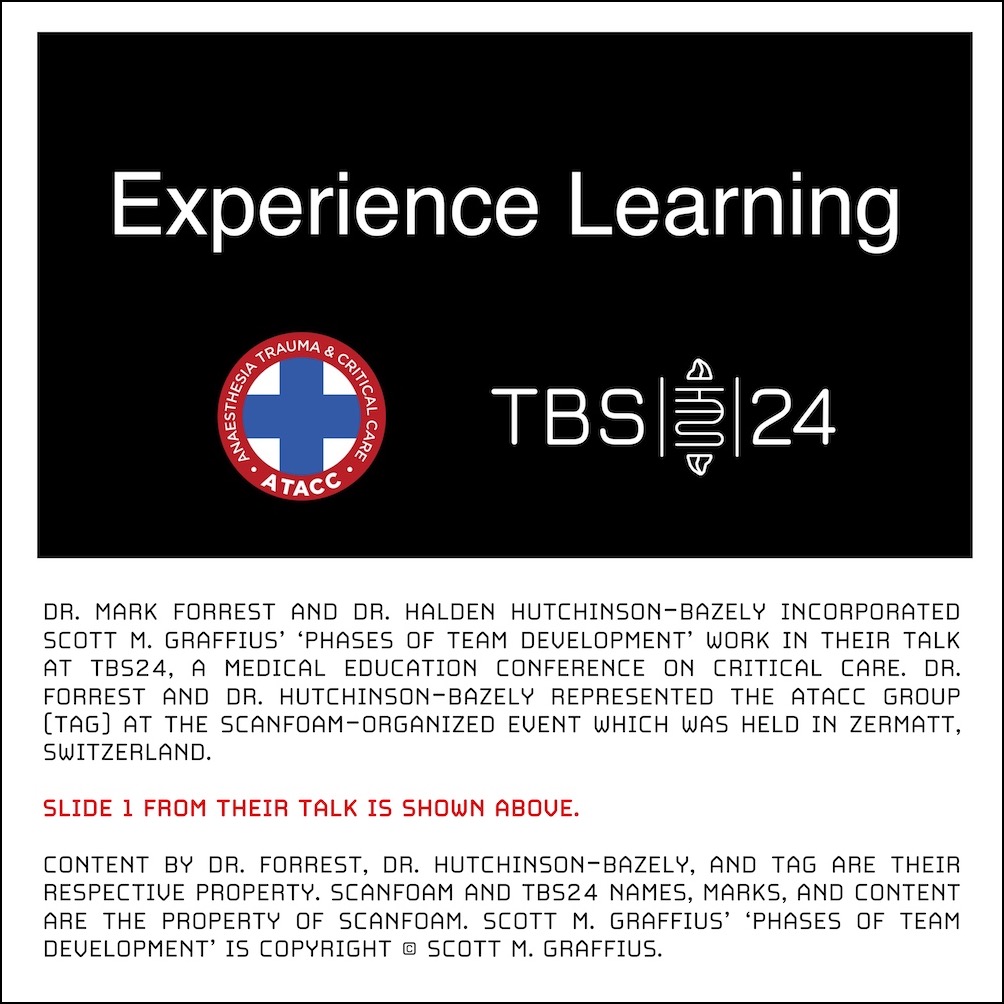
Slide 1 from their talk is shown above.
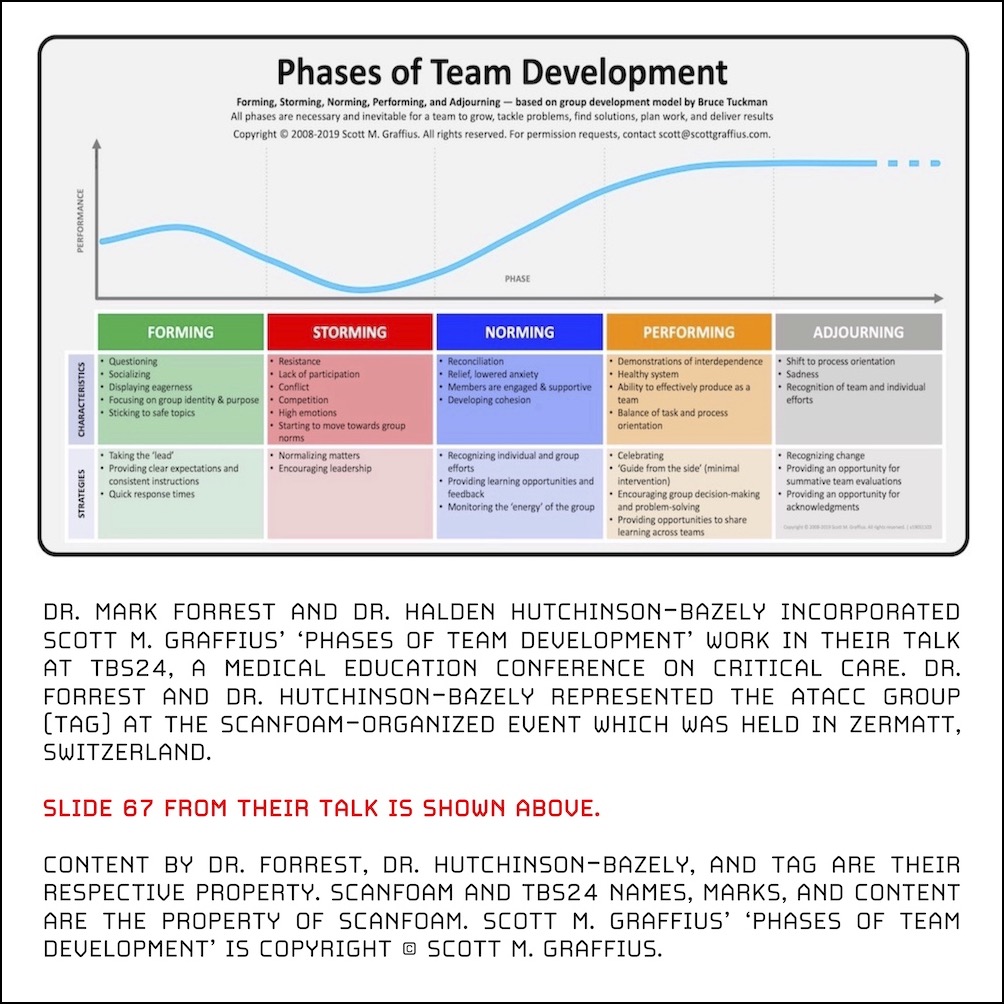
Slide 67 from their talk — which featured the 2019 edition of Graffius' 'Phases of Team Development' — is shown above. (For details on the current [2024] edition of Graffius' work including permission request information, high resolution files, and more, visit here.)
A recording of their session is on YouTube.
About Dr. Mark Forrest
The following includes content from https://scanfoam.org/tbs24.
Dr. Mark Forrest is a consultant in anaesthetics, critical care, prehospital care from the North West of England and Associate Medical Director in his NHS Trust. He has over 35 years of experience in these fields and has additional experience in aeromedical retrieval (including Paeds and ECMO), diving/hyperbaric medicine, and tactical medicine. Dr. Forrest flies as a consultant on HeliMed 29 and responds on a day-to-day basis as a 'Fire & Rescue Doctor.' He is passionate about trauma and critical care, especially in the prehospital arena and has a specialist interest in vehicle extrication as a Road Traffic Collision Extrication Instructor and Clinical Advisor to the National Fire Service College.
Dr. Forrest was the first appointed Medical Director for Fire & Rescue in the UK, over 17 years ago and now directs 9 UK Police Forces and 3 Fire and Rescue Services, through the ATACC Group.
Dr. Forrest is the Founder and Medical Director of the internationally renowned ATACC (Anesthesia Trauma and Critical Care) course and he is the First President of the Faculty of Trauma & Critical Care. He is an advocate for immersive simulation, unique training and innovation and has written over 20 varied courses for The ATACC Group as a Royal College Surgeons (London) Education Centre.
About Dr. Halden Hutchinson-Bazely
The following includes content from https://scanfoam.org/tbs24.
Dr. Halden Hutchinson-Bazely is an intensive care medicine doctor and pre hospital emergency medicine doctor in the UK. He works in a large, major trauma centre ICU, and he is a Helicopter Emergency Medical System (HEMS) doctor at East Anglian Air Ambulance (EAAA).
Dr. Hutchinson-Bazely is committed to delivering contemporary and compassionate critical care, and supporting others to do the same, so much of his non-clinical work is education. He is a faculty member at EAAA, where he specializes in endovascular resuscitation techniques. Dr. Hutchinson-Bazely is also part of the faculty for the international Endovascular Trauma Management (EVTM) society. His main commitment to education is as a deputy medical director for ATACC, where he co-directs the ATACC course.
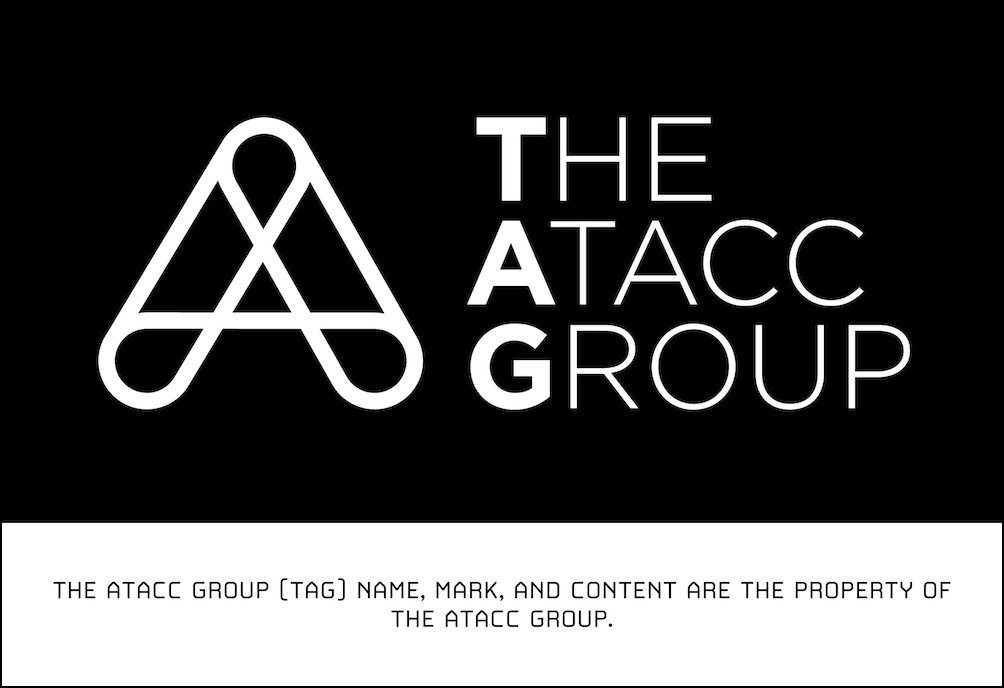
About The ATACC Group
The ATACC Group (TAG) is known for providing high quality first aid, clinical and medical education and training to every level of provider involved in patient care. It offers a suite of regulated qualifications in collaboration with Qualification Network UK (QNUK) who are an Ofqual, CCEA, and Qualification Wales recognized Awarding Organization. TAG is also a Royal College of Surgeons, London approved Educational Centre. ATACC is an acronym for Anesthesia, Trauma, and Critical Care. Visit https://www.ataccgroup.com to learn more.
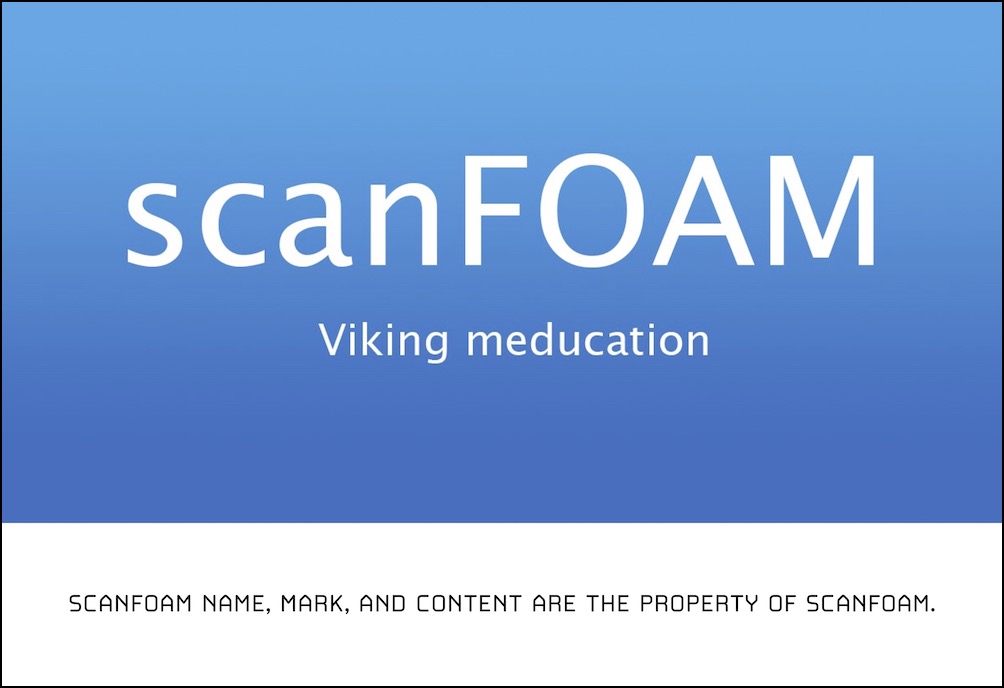
About scanFOAM
Scandinavia-based not-for-profit scanFOAM provides resources, conferences (such as TBS24), and more aimed at improving medicine. ScanFOAM is short for Scandinavia Free Open Access Meducation (or medical education). Visit https://scanfoam.org/ to learn more.
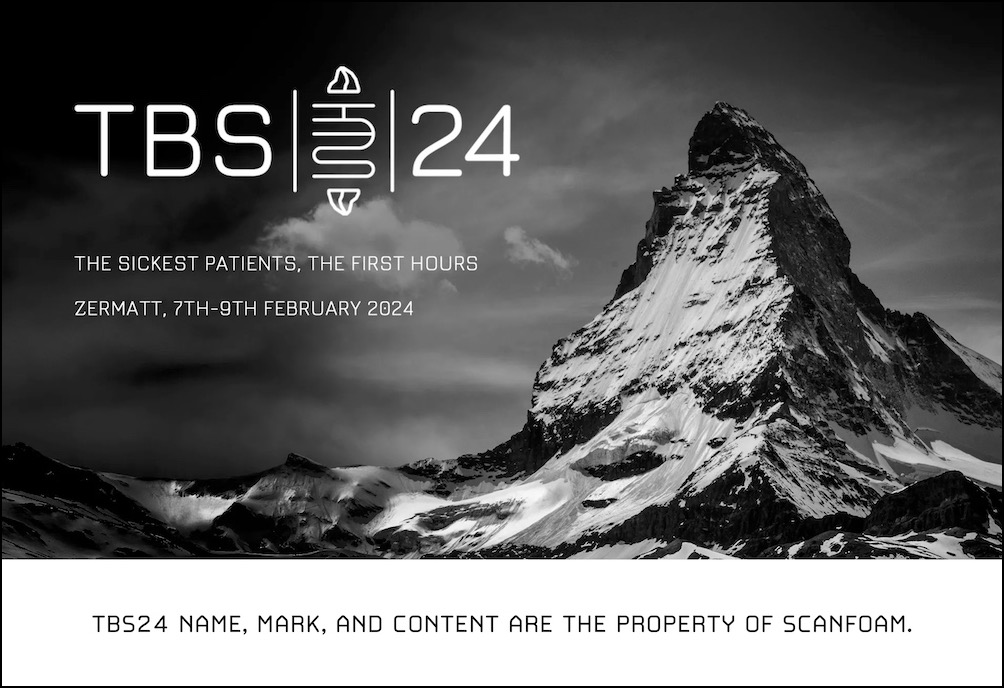
About the TBS24 Conference
TBS24 – the 6th iteration of cutting-edge talks on critical care, organized by scanFOAM – was held in beautiful Zermatt, Switzerland, on 7-9 February 2024. Visit https://scanfoam.org/tbs24/ to learn more.
How to Cite This Article
Graffius, Scott M. (2024, April 25). Graffius' 'Phases of Team Development' Featured by TAG at TBS24 Conference in Zermatt Switzerland. Available at: https://scottgraffius.com/blog/files/tbs24.html. DOI: 10.13140/RG.2.2.36021.90087.




About Scott M. Graffius

Scott M. Graffius, PMP, SA, CSP-SM, CSP-PO, CSM, CSPO, ITIL, LSSGB is an agile project management practitioner, consultant, thinker, creator, multi-award-winning author, and international public speaker. Founder and CEO of Exceptional PPM and PMO Solutions™ and subsidiary Exceptional Agility™, he has generated over $1.9 billion for Global Fortune 500 businesses and other organizations he has served. Graffius and content from his books, talks, workshops, and more have been featured and used by Microsoft, Oracle, Broadcom, Cisco, Gartner, Project Management Institute, IEEE, National Academy of Sciences, United States Department of Energy, Yale University, Tufts University, and others. He delights audiences with dynamic and engaging talks and workshops on agile project management, AI, Tech leadership, video game development, strategic alignment, the science of high performance teams, and more. To date, he's presented sessions at 89 conferences and other events across 25 countries.
His full bio is available here.
Connect with Scott on:



About Agile Scrum: Your Quick Start Guide with Step-by-Step Instructions

Shifting customer needs are common in today's marketplace. Businesses must be adaptive and responsive to change while delivering an exceptional customer experience to be competitive.
There are a variety of frameworks supporting the development of products and services, and most approaches fall into one of two broad categories: traditional or agile. Traditional practices such as waterfall engage sequential development, while agile involves iterative and incremental deliverables. Organizations are increasingly embracing agile to manage projects, and best meet their business needs of rapid response to change, fast delivery speed, and more.
With clear and easy to follow step-by-step instructions, Scott M. Graffius's award-winning Agile Scrum: Your Quick Start Guide with Step-by-Step Instructions helps the reader:
- Implement and use the most popular agile framework―Scrum;
- Deliver products in short cycles with rapid adaptation to change, fast time-to-market, and continuous improvement; and
- Support innovation and drive competitive advantage.
Hailed by Literary Titan as “the book highlights the versatility of Scrum beautifully.”
Winner of 17 first place awards.
Agile Scrum: Your Quick Start Guide with Step-by-Step Instructions is available in paperback and ebook/Kindle in the United States and around the world. Some links by country follow.
- 🇧🇷 Brazil
- 🇨🇦 Canada
- 🇨🇿 Czech Republic
- 🇩🇰 Denmark
- 🇫🇮 Finland
- 🇫🇷 France
- 🇩🇪 Germany
- 🇬🇷 Greece
- 🇭🇺 Hungary
- 🇮🇳 India
- 🇮🇪 Ireland
- 🇮🇱 Israel
- 🇮🇹 Italy
- 🇯🇵 Japan
- 🇱🇺 Luxembourg
- 🇲🇽 Mexico
- 🇳🇱 Netherlands
- 🇳🇿 New Zealand
- 🇳🇴 Norway
- 🇪🇸 Spain
- 🇸🇪 Sweden
- 🇨🇭 Switzerland
- 🇦🇪 UAE
- 🇬🇧 United Kingdom
- 🇺🇸 United States

About Agile Transformation: A Brief Story of How an Entertainment Company Developed New Capabilities and Unlocked Business Agility to Thrive in an Era of Rapid Change

Thriving in today's marketplace frequently depends on making a transformation to become more agile. Those successful in the transition enjoy faster delivery speed and ROI, higher satisfaction, continuous improvement, and additional benefits.
Based on actual events, Agile Transformation: A Brief Story of How an Entertainment Company Developed New Capabilities and Unlocked Business Agility to Thrive in an Era of Rapid Change provides a quick (60-90 minute) read about a successful agile transformation at a multinational entertainment and media company, told from the author's perspective as an agile coach.
The award-winning book by Scott M. Graffius is available in paperback and ebook/Kindle in the United States and around the world. Some links by country follow.
- 🇦🇺 Australia
- 🇦🇹 Austria
- 🇧🇷 Brazil
- 🇨🇦 Canada
- 🇨🇿 Czech Republic
- 🇩🇰 Denmark
- 🇫🇮 Finland
- 🇫🇷 France
- 🇩🇪 Germany
- 🇬🇷 Greece
- 🇮🇳 India
- 🇮🇪 Ireland
- 🇯🇵 Japan
- 🇱🇺 Luxembourg
- 🇲🇽 Mexico
- 🇳🇱 Netherlands
- 🇳🇿 New Zealand
- 🇪🇸 Spain
- 🇸🇪 Sweden
- 🇨🇭 Switzerland
- 🇦🇪 United Arab Emirates
- 🇬🇧 United Kingdom
- 🇺🇸 United States

An abridged version of this article is on LinkedIn.
The short link for this article is https://bit.ly/tbs-24
© Copyright 2024 Scott M. Graffius. All rights reserved. This material may not be published, broadcast, rewritten or redistributed without the express written permission of Scott M. Graffius.

Semiconductor Manufacturing Firm Lam Research Features Scott M. Graffius' 'Phases of Team Development' Intellectual Property

Semiconductor Manufacturing Firm Lam Research Features Scott M. Graffius' 'Phases of Team Development' IP
Informed by the research of Bruce W. Tuckman and Mary Ann C. Jensen, over 100 subsequent studies, and Scott M. Graffius' first-hand professional experience with, and analysis of, team leadership and performance, Graffius created his 'Phases of Team Development' as a unique perspective and visual conveying the five phases of team development — Forming, Storming, Norming, Performing, and Adjourning — inclusive of a graph showing how performance varies by phase, as well as the characteristics and strategies for each phase. Graffius' 'Phases of Team Development' is registered with the U.S. Copyright Office.
Leaders of teams can apply Graffius' information to help handle challenges or issues experienced by teams. By doing so, they’ll advance the teams’ (and their own) happiness, productivity, and success.
Graffius' 'Phases of Team Development' intellectual property is used by businesses, professional associations, government agencies, and universities around the world. Select examples include:
- Adobe,
- American Management Association,
- Amsterdam Public Health Research Institute,
- Bayer,
- Boston University,
- Cisco,
- Deimos Aerospace,
- DevOps Institute,
- Ford Motor Company,
- Hasso Plattner Institute (Germany),
- IEEE,
- London South Bank University,
- Microsoft,
- New Zealand Government,
- Torrens University Australia,
- UC San Diego,
- TBS Switzerland,
- UK Sports Institute,
- University of Galway Ireland,
- U.S. National Park Service,
- U.S. Tennis Association,
- Virginia Tech,
- Yale University,
- and many others.
Semiconductor manufacturing firm Lam Research was added to the list.
Here's email 1 of 5: The request from Lam Research to Graffius. (Personal, sensitive, or confidential information is redacted throughout.)
Here's email 2 of 5: Response from Graffius to Lam Research.
Here's email 3 of 5: Response from Lam Research to Graffius.
Here's email 4 of 5: Response from Graffius to Lam Research.
And here's email 5 of 5: Response from Lam Research to Graffius.
Graffius initially developed his respective material in 2008, and he periodically refreshes it. Information on the current (2024) edition of his 'Phases of Team Development' IP including how to request permission and more is provided later in this article.





About Scott M. Graffius

Scott M. Graffius, PMP, SA, CSP-SM, CSP-PO, CSM, CSPO, ITIL, LSSGB is an agile project management practitioner, consultant, creator, award-winning author (Agile Scrum and Agile Transformation), and international public speaker. Founder and CEO of Exceptional PPM and PMO Solutions™ and subsidiary Exceptional Agility™, he has generated over $1.9 billion for Global Fortune 500 businesses and other organizations he has served. Graffius and content from his books, talks, workshops, and more have been featured and used by Microsoft, Oracle, Broadcom, Cisco, Adobe, Gartner, Project Management Institute, IEEE, Qantas, National Academy of Sciences, EU's European Commission, Amsterdam Public Health Research Institute, Boston University, U.S. National Park Service, Bayer, Ford, London South Bank University, Warsaw University of Technology, U.S. Tennis Association, Hasso Plattner Institute, American Management Association, Virginia Tech, University of Galway Ireland, UC San Diego, Yale University, and others. He delights audiences with dynamic and engaging talks and workshops on agile project management, AI, video game development, strategic alignment, the science of high performance teams, and more. To date, he's presented sessions at 91 conferences and other events across 25 countries. His full bio is available here.



About Agile Scrum: Your Quick Start Guide with Step-by-Step Instructions

Shifting customer needs are common in today's marketplace. Businesses must be adaptive and responsive to change while delivering an exceptional customer experience to be competitive.
There are a variety of frameworks supporting the development of products and services, and most approaches fall into one of two broad categories: traditional or agile. Traditional practices such as waterfall engage sequential development, while agile involves iterative and incremental deliverables. Organizations are increasingly embracing agile to manage projects, and best meet their business needs of rapid response to change, fast delivery speed, and more.
With clear and easy to follow step-by-step instructions, Scott M. Graffius's award-winning Agile Scrum: Your Quick Start Guide with Step-by-Step Instructions helps the reader:
- Implement and use the most popular agile framework―Scrum;
- Deliver products in short cycles with rapid adaptation to change, fast time-to-market, and continuous improvement; and
- Support innovation and drive competitive advantage.
Hailed by Literary Titan as “the book highlights the versatility of Scrum beautifully.”
Winner of 17 first place awards.
Agile Scrum: Your Quick Start Guide with Step-by-Step Instructions is available in paperback and ebook/Kindle in the United States and around the world. Some links by country follow.
- 🇧🇷 Brazil
- 🇨🇦 Canada
- 🇨🇿 Czech Republic
- 🇩🇰 Denmark
- 🇫🇮 Finland
- 🇫🇷 France
- 🇩🇪 Germany
- 🇬🇷 Greece
- 🇭🇺 Hungary
- 🇮🇳 India
- 🇮🇪 Ireland
- 🇮🇱 Israel
- 🇮🇹 Italy
- 🇯🇵 Japan
- 🇱🇺 Luxembourg
- 🇲🇽 Mexico
- 🇳🇱 Netherlands
- 🇳🇿 New Zealand
- 🇳🇴 Norway
- 🇪🇸 Spain
- 🇸🇪 Sweden
- 🇨🇭 Switzerland
- 🇦🇪 UAE
- 🇬🇧 United Kingdom
- 🇺🇸 United States

About Agile Transformation: A Brief Story of How an Entertainment Company Developed New Capabilities and Unlocked Business Agility to Thrive in an Era of Rapid Change

Thriving in today's marketplace frequently depends on making a transformation to become more agile. Those successful in the transition enjoy faster delivery speed and ROI, higher satisfaction, continuous improvement, and additional benefits.
Based on actual events, Agile Transformation: A Brief Story of How an Entertainment Company Developed New Capabilities and Unlocked Business Agility to Thrive in an Era of Rapid Change provides a quick (60-90 minute) read about a successful agile transformation at a multinational entertainment and media company, told from the author's perspective as an agile coach.
The award-winning book by Scott M. Graffius is available in paperback and ebook/Kindle in the United States and around the world. Some links by country follow.
- 🇦🇺 Australia
- 🇦🇹 Austria
- 🇧🇷 Brazil
- 🇨🇦 Canada
- 🇨🇿 Czech Republic
- 🇩🇰 Denmark
- 🇫🇮 Finland
- 🇫🇷 France
- 🇩🇪 Germany
- 🇬🇷 Greece
- 🇮🇳 India
- 🇮🇪 Ireland
- 🇯🇵 Japan
- 🇱🇺 Luxembourg
- 🇲🇽 Mexico
- 🇳🇱 Netherlands
- 🇳🇿 New Zealand
- 🇪🇸 Spain
- 🇸🇪 Sweden
- 🇨🇭 Switzerland
- 🇦🇪 United Arab Emirates
- 🇬🇧 United Kingdom
- 🇺🇸 United States

About Graffius' Copyrighted 'Phases of Team Development'
Graffius' intellectual property was briefly covered earlier in this article. This section provides additional information.
Graffius initially developed the material in 2008, and he periodically refreshes it. For details on the current (2024) edition including permission request information, high resolution files, and more, select here.
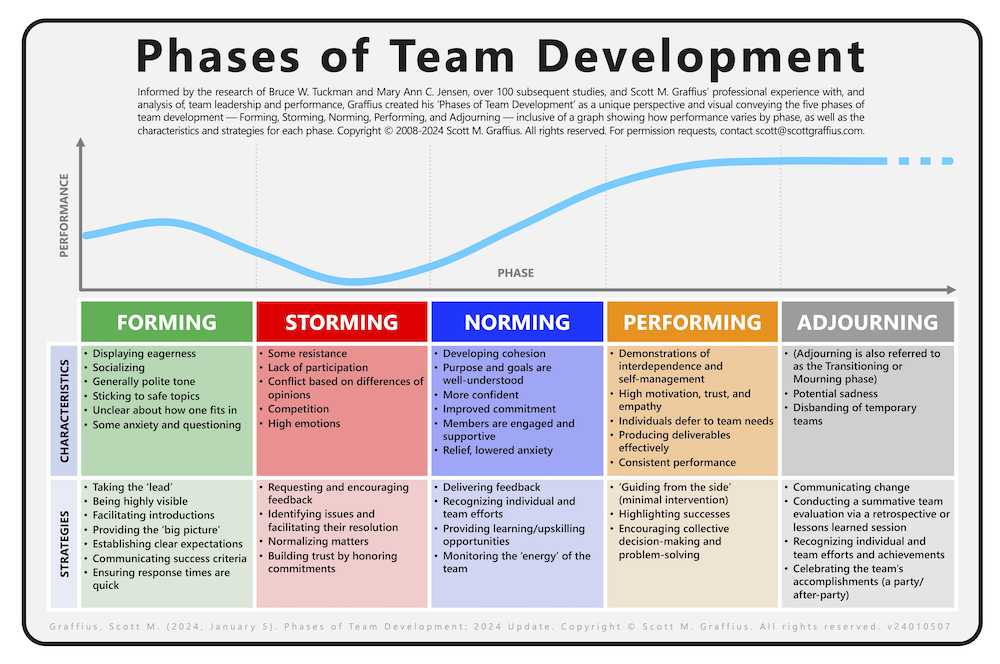
The visual from the 2024 edition of Graffius' 'Phases of Team Development' is shown above.

About Lam Research
Lam Research Corporation is a global supplier of innovative wafer fabrication equipment and services to the semiconductor industry. Lam's products and services enable customers to build smaller and better performing devices. Today, most advanced chips are built with Lam technology. Lam Research combines superior systems engineering, technology leadership, and a strong values-based culture, with an unwavering commitment to its customers. Lam Research (Nasdaq: LRCX) is a FORTUNE 500® company headquartered in Fremont, California, with operations around the globe. Visit https://www.lamresearch.com to learn more.

How to Cite This Article
Graffius, Scott M. (2024, June 13). Semiconductor Manufacturing Firm Lam Research Features Scott M. Graffius' 'Phases of Team Development' Intellectual Property. Available at: https://scottgraffius.com/blog/files/lam.html. DOI: 10.13140/RG.2.2.34699.30246.

© Copyright 2024 Scott M. Graffius. All rights reserved. This material may not be published, broadcast, rewritten or redistributed without the express written permission of Scott M. Graffius.

FINAT (Fédération Internationale des Fabricants et Transformateurs d'Adhésifs et Thermocollants sur Papiers et Autres Supports) Features Scott M. Graffius’ Intellectual Property


Scott M. Graffius' Intellectual Property on Teamwork Tradecraft
Informed by the research of Bruce W. Tuckman and Mary Ann C. Jensen, over 100 subsequent studies, and Scott M. Graffius' first-hand professional experience with, and analysis of, team leadership and performance, Graffius created his ‘Phases of Team Development’ as a unique perspective and visual conveying the five phases of team development — Forming, Storming, Norming, Performing, and Adjourning — inclusive of a graph showing how performance varies by phase, as well as the characteristics and strategies for each phase.
Graffius' intellectual property (IP) is registered with the United States Copyright Office.
Graffius initially developed his ‘Phases of Team Development’ unique material in 2008, and he periodically refreshes it.
For reference, the visual for the current (2024) edition is below and the details are here.

Organizations around the world engage Graffius to deliver compelling talks and workshops. To date, he's presented sessions at 91 conferences and other events across 25 countries: Armenia, Australia, Brazil, Canada, Czech Republic, Finland, France, Germany, Greece, Hong Kong, Hungary, India, Ireland, Lithuania, Luxembourg, Nepal, Netherlands, New Zealand, Norway, Romania, Sweden, Switzerland, United Arab Emirates, United Kingdom, and the United States.

Graffius ‘Phases of Team Development’ IP is central and key to many of those sessions. His rate card and a listing of his engagements are at https://scottgraffius.com/resources/Exceptional-PPM-and-PMO-Solutions-Rate-Card-for-2024-2025-v24071607.pdf and https://scottgraffius.com/publicspeaker.html, respectively.

Graffius' 'Phases of Team Development' Intellectual Property Is Used By Organizations Around The World — And FINAT Was Added To The List
With an authorization/license from Graffius, his ‘Phases of Team Development’ IP is featured and used by businesses, professional associations, government agencies, and universities around the globe. Examples include:
- Adobe,
- American Management Association,
- Amsterdam Public Health Research Institute,
- Bayer,
- Boston University,
- Broadcom,
- Cisco,
- Deimos Aerospace,
- DevOps Institute,
- Erste Group Bank AG (Austria),
- Ford Motor Company,
- FSU College of Medicine,
- Hasso Plattner Institute,
- IEEE,
- James Madison University,
- Johns Hopkins University,
- LeadingEng,
- London South Bank University,
- Manufacturers Alliance,
- Microsoft,
- New Zealand Government,
- Oracle,
- Royal Australasian College of Physicians,
- TBS Switzerland,
- Torrens University Australia,
- Tufts University,
- U.S. National Park Service,
- U.S. Tennis Association,
- UC San Diego,
- UK Sports Institute,
- University of Galway Ireland,
- Victorian Institute of Technology (Australia),
- Virginia Tech,
- Warsaw University,
- Western Sydney University,
- World Resources Institute,
- Yale University,
- ZHAW Zurich University of Applied Sciences,
- and many others.
FINAT — the international association for the label industry’s development, education, and innovation — was added to the list.
The following visual shows a post from FINAT on LinkedIn with text about and pictures (including one featuring Graffius’ IP) from the FINAT Committee Summit in May 2024 in Amsterdam.

The following visual includes a picture from FINAT on LinkedIn. It shows Graffius’ 'Phases of Team Development' IP displayed on-screen in a talk at the FINAT Committee Summit in May 2024 in Amsterdam.

To learn more about FINAT, read on.
To learn more about Graffius' 'Phases of Team Development' intellectual property, visit here.

This article uses limited excerpts from FINAT (a post shared by FINAT on LinkedIn, and a picture from the same post featuring Graffius’ IP), attributed to FINAT and used under fair use for news reporting and analysis. FINAT name, mark, and content are the property of FINAT. Graffius’ ‘Phases of Team Development’ is copyright © Scott M. Graffius. All rights reserved.

About FINAT
FINAT is the international association for the label industry’s development, education, and innovation.
FINAT is an abbreviation for Fédération Internationale des Fabricants et Transformateurs d'Adhésifs et Thermocollants sur Papiers et Autres Supports. In English: International Federation of Manufacturers and Processors of Adhesives and Heat-Sealable Materials on Paper and Other Supports.
FINAT’s mission involves empowering the label industry by being the uniting platform that helps the international label industry excel in their daily business. FINAT's scope is to:
- Provide a global communication and networking platform for converters and direct and indirect suppliers.
- Represent members' interests.
- Provide a central source for industry information.
- Produce and distribute related educational and technical publications.
- Represent the industry's views at the EU level.
- Establish and maintain industry-related best practices, standards, and test methods.
To learn more, visit https://www.finat.com.

About Scott M. Graffius

Scott M. Graffius is a global leader in agile project management, an expert on teamwork tradecraft, an authority on temporal dynamics on social media platforms, a creator, a consultant, a trainer, an award-winning author, and an international public speaker.
He's generated over $1.9 billion of business value in aggregate for Global Fortune 500 businesses and other organizations he's served. Businesses and industries range from consumer products to advanced technology (including AI, R&D), e-commerce, music, streaming/OTT video, television, film, video games, financial services, government, and more.
Graffius and content from his books (Agile Scrum and Agile Transformation), talks, workshops, and more have been featured and used by businesses, professional associations, governments, and universities around the world. Examples include Adobe, American Management Association, Amsterdam Public Health Research Institute, Bayer, Boston University, Broadcom, Cisco, Deimos Aerospace, DevOps Institute, EU's European Commission, Ford Motor Company, Hasso Plattner Institute Germany, IEEE, Johns Hopkins University, London South Bank University, Microsoft, National Academy of Sciences, New Zealand Government, Oracle, Project Management Institute, Torrens University Australia, UC San Diego, TBS Switzerland, UK Sports Institute, University of Galway Ireland, U.S. Department of Energy, U.S. National Park Service, U.S. Tennis Association, Virginia Tech, Warsaw University of Technology, Yale University, Zurich University of Applied Sciences, and many others.
He delights audiences around the world with dynamic and engaging talks and workshops. He's presented sessions at 91 conferences and other events across 25 countries. Visit here to learn more and here to ask Scott to speak at your event.



About Agile Scrum: Your Quick Start Guide with Step-by-Step Instructions

Shifting customer needs are common in today's marketplace. Businesses must be adaptive and responsive to change while delivering an exceptional customer experience to be competitive.
There are a variety of frameworks supporting the development of products and services, and most approaches fall into one of two broad categories: traditional or agile. Traditional practices such as waterfall engage sequential development, while agile involves iterative and incremental deliverables. Organizations are increasingly embracing agile to manage projects, and best meet their business needs of rapid response to change, fast delivery speed, and more.
With clear and easy to follow step-by-step instructions, Scott M. Graffius's award-winning Agile Scrum: Your Quick Start Guide with Step-by-Step Instructions helps the reader:
- Implement and use the most popular agile framework―Scrum;
- Deliver products in short cycles with rapid adaptation to change, fast time-to-market, and continuous improvement; and
- Support innovation and drive competitive advantage.
Hailed by Literary Titan as “the book highlights the versatility of Scrum beautifully.”
Winner of 17 first place awards.
Agile Scrum: Your Quick Start Guide with Step-by-Step Instructions is available in paperback and ebook/Kindle in the United States and around the world. Some links by country follow.
- 🇧🇷 Brazil
- 🇨🇦 Canada
- 🇨🇿 Czech Republic
- 🇩🇰 Denmark
- 🇫🇮 Finland
- 🇫🇷 France
- 🇩🇪 Germany
- 🇬🇷 Greece
- 🇭🇺 Hungary
- 🇮🇳 India
- 🇮🇪 Ireland
- 🇮🇱 Israel
- 🇮🇹 Italy
- 🇯🇵 Japan
- 🇱🇺 Luxembourg
- 🇲🇽 Mexico
- 🇳🇱 Netherlands
- 🇳🇿 New Zealand
- 🇳🇴 Norway
- 🇪🇸 Spain
- 🇸🇪 Sweden
- 🇨🇭 Switzerland
- 🇦🇪 UAE
- 🇬🇧 United Kingdom
- 🇺🇸 United States

About Agile Transformation: A Brief Story of How an Entertainment Company Developed New Capabilities and Unlocked Business Agility to Thrive in an Era of Rapid Change

Thriving in today's marketplace frequently depends on making a transformation to become more agile. Those successful in the transition enjoy faster delivery speed and ROI, higher satisfaction, continuous improvement, and additional benefits.
Based on actual events, Agile Transformation: A Brief Story of How an Entertainment Company Developed New Capabilities and Unlocked Business Agility to Thrive in an Era of Rapid Change provides a quick (60-90 minute) read about a successful agile transformation at a multinational entertainment and media company, told from the author's perspective as an agile coach.
The award-winning book by Scott M. Graffius is available in paperback and ebook/Kindle in the United States and around the world. Some links by country follow.
- 🇦🇺 Australia
- 🇦🇹 Austria
- 🇧🇷 Brazil
- 🇨🇦 Canada
- 🇨🇿 Czech Republic
- 🇩🇰 Denmark
- 🇫🇮 Finland
- 🇫🇷 France
- 🇩🇪 Germany
- 🇬🇷 Greece
- 🇮🇳 India
- 🇮🇪 Ireland
- 🇯🇵 Japan
- 🇱🇺 Luxembourg
- 🇲🇽 Mexico
- 🇳🇱 Netherlands
- 🇳🇿 New Zealand
- 🇪🇸 Spain
- 🇸🇪 Sweden
- 🇨🇭 Switzerland
- 🇦🇪 United Arab Emirates
- 🇬🇧 United Kingdom
- 🇺🇸 United States


How to Cite This Article
Graffius, Scott M. (2024, September 12). FINAT (Fédération Internationale des Fabricants et Transformateurs d'Adhésifs et Thermocollants sur Papiers et Autres Supports) Features Scott M. Graffius’ Intellectual Property. Available at: https://scottgraffius.com/blog/files/finat.html. DOI: 10.13140/RG.2.2.16446.50244.


Post-Publication Notes
If there are any supplements or updates to this article after the date of publication, they will appear here.

A PDF of this article is here
The short link for this article is https://bit.ly/finat-24
© Copyright 2024 Scott M. Graffius. All rights reserved. This material may not be published, broadcast, rewritten or redistributed without the express written permission of Scott M. Graffius.

TurningWest's 'Trial'


If there's an update after this article is published, the information will appear in the Post-Publication Notes section.

Introduction
Plagiarism—defined as ‘to steal and pass off (the ideas or words of another) as one’s own: use (another's production) without crediting the source’ (source: Merriam-Webster)—infringes on the intellectual property rights of others, results in misinformation, and often violates copyright.

Background
Informed by the research of Bruce W. Tuckman and Mary Ann C. Jensen, over 100 subsequent studies, and Scott M. Graffius' first-hand professional experience with, and analysis of, team leadership and performance, Graffius created his ‘Phases of Team Development’ as a unique perspective and visual conveying the five phases of team development—Forming, Storming, Norming, Performing, and Adjourning—inclusive of a graph showing how performance varies by phase, as well as the characteristics and strategies for each phase.
Graffius' intellectual property (IP) is registered with the United States Copyright Office.
Graffius initially developed his ‘Phases of Team Development’ unique material in 2008, and he periodically refreshes it.
For reference, the visual applicable to this case (2021 edition) is shown below [Exhibit 1] and is available at: https://dx.doi.org/10.13140/RG.2.2.22040.42246.

As shown above, Graffius’ copyright ownership details are integrated into and appear on his copyrighted property. Specifically, it reads: “Copyright © 2008-2021 Scott M. Graffius. All rights reserved. For permission requests, contact scott@scottgraffius.com.”
Again, this 2021 edition is referenced because it is the one applicable to this case.
Organizations around the world engage Graffius to deliver compelling talks and workshops. To date, he's presented sessions at 91 conferences and other events across 25 countries:
- Armenia,
- Australia,
- Brazil,
- Canada,
- Czech Republic,
- Finland,
- France,
- Germany,
- Greece,
- Hong Kong,
- Hungary,
- India,
- Ireland,
- Lithuania,
- Luxembourg,
- Nepal,
- Netherlands,
- New Zealand,
- Norway,
- Romania,
- Sweden,
- Switzerland,
- United Arab Emirates,
- United Kingdom,
- and the United States.

Graffius ‘Phases of Team Development’ IP is central and key to many of those sessions. His rate card and a listing of his engagements are at https://scottgraffius.com/resources/Exceptional-PPM-and-PMO-Solutions-Rate-Card-for-2024-2025-v24071607.pdf and https://scottgraffius.com/publicspeaker.html, respectively.
With an authorization/license from Graffius, his copyrighted ‘Phases of Team Development’ intellectual property is featured and used by businesses, professional associations, government agencies, and universities around the globe. Examples include:
- Adobe,
- American Management Association,
- Amsterdam Public Health Research Institute,
- Boston University,
- Broadcom,
- Cisco,
- Deimos Aerospace,
- DevOps Institute,
- Erste Group Bank AG (Austria),
- FINAT,
- Ford Motor Company,
- FSU College of Medicine,
- Hasso Plattner Institute,
- IEEE,
- James Madison University,
- Johns Hopkins University,
- LeadingEng,
- London South Bank University,
- Manufacturers Alliance,
- Microsoft,
- New Zealand Government,
- Oracle,
- Royal Australasian College of Physicians,
- TBS Switzerland,
- Torrens University Australia,
- Tufts University,
- U.S. National Park Service,
- U.S. Tennis Association,
- UC San Diego,
- UK Sports Institute,
- University of Galway Ireland,
- Victorian Institute of Technology (Australia),
- Virginia Tech,
- Warsaw University,
- Western Sydney University,
- World Resources Institute,
- Yale University,
- and many others.

Details on the Plagiarism
Note: All evidence has been preserved.
A whistleblower tip informed Scott M. Graffius that a video is using Graffius’ intellectual property. The video was identified as:
- Publisher of video: TurningWest
- Date of publication: 16 September 2024
- Title of video: ‘9 13 24 Mastering Team Dev webinar’ (note: the preceding is what is listed on YouTube as the title; however, for reference, the video itself notes that the title is: 'Mastering Team Development: Key Modules and Performance Examples')
- Link to video: https://www.youtube.com/watch?v=n7qldELhp7s
Exhibit 2 is shown below. It provides an overview, including thumbnail images from the the video.

Graffius reviewed TurningWest’s 2024 video and saw numerous examples of material—content on the characteristics and strategies for the phases of team development—plagiarized from Graffius’ 2021 copyrighted ‘Phases of Team Development’ property.
TurningWest did not request nor receive permission to use Graffius’ 2021 copyrighted ‘Phases of Team Development’ property. Yet, TurningWest used it (some with slight rewording such as changing "recognizing" to "recognize" and similar, which remains plagiarism) commercially and without attribution.
Again, plagiarism is defined as ‘to steal and pass off (the ideas or words of another) as one’s own: use (another's production) without crediting the source’ (source: Merriam-Webster). TurningWest’s presentation plagiarized Graffius’ copyrighted ’Phases of Team Development,’ violating his intellectual property.
Instances of TurningWest changing a word from a section from Graffius’ copyrighted property that’s in the present participle form (such as "recognizing") to the present simple form (such as "recognize") or otherwise similar slight rewording is still stealing Graffius' words and ideas; it is still plagiarism. The combination of such rewording and lack of attribution may be seen as a signal of intent to deceive. Regardless of whether the infringement was intentional or "inadvertent," the actions misrepresent the originator of the words and ideas, which is at the heart of plagiarism.
Plagiarism is a profound and disgraceful breach of professional ethics, moral standards, and Graffius’ intellectual property rights.
Graffius maintains, enforces, and protects his copyright and other intellectual property rights.
Graffius informed TurningWest and TurningWest’s Steve Goodwin about the infringement. An excerpt: "An authorized example of my copyrighted property is at https://dx.doi.org/10.13140/RG.2.2.22040.42246 and other locations. Steven Goodwin and Megan Sands of TurningWest's presentation used some of my intellectual property ... with no attribution to me whatsoever. By doing so, they are falsely leading others to wrongly believe that they are the authors and owners of my intellectual property. Uncool."
Here’s a reaction from TurningWest's Goodwin: "I have never heard of you before and have never seen any of your materials. This is very basic information and foundational to all team formation efforts." As shown by the indisputable proof to come, Goodwin's reaction is problematic for him. TurningWest plagiarized Graffius' work.
Here’s another reaction from TurningWest's Goodwin: "Who are you and what kind of scam are you trying to pull? I have NEVER heard your name before nor have I EVER seen one word of your materials." Again, as shown by the indisputable proof to come, Goodwin's reaction is problematic for him. TurningWest plagiarized Graffius' work.
Additionally, by TurningWest not taking responsibility for and addressing their damaging plagiarism, TurningWest continues to spread misinformation and is directly responsible for their ongoing violation of Graffius' intellectual property.
When Graffius reviewed the TurningWest's infringing 2024 video, he saw that content on the characteristics and strategies for the phases of team development was teeming with plagiarized material from Graffius’ 2021 copyrighted ‘Phases of Team Development’ property. The indisputable proof follows.
Here's Exhibit 3. It's a delineated, side-by-side comparison of content on the characteristics and strategies for the Forming phase of team development. Respective content from Graffius' 2021 copyrighted 'Phases of Team Development' appears with a green background. Material from TurningWest's infringing 2024 video is exposed with a red background. It shows examples of TurningWest's plagiarism—TurningWest stealing and passing off Graffius' words or ideas as their own.

Exhibit 4 is below. It provides diligent, side-by-side comparison of content on the characteristics and strategies for the Storming phase of team development. Respective content from Graffius' 2021 copyrighted 'Phases of Team Development' appears with a green background. Material from TurningWest's infringing 2024 video is exposed with a red background. It shows more examples of TurningWest's plagiarism—TurningWest stealing and passing off Graffius' words or ideas as their own.

Here's Exhibit 5. It's a delineated, side-by-side comparison of content on the characteristics and strategies for the Norming phase of team development. Respective content from Graffius' 2021 copyrighted 'Phases of Team Development' appears with a green background. Material from TurningWest's infringing 2024 video is exposed with a red background. It shows additional examples of TurningWest's plagiarism—TurningWest stealing and passing off Graffius' words or ideas as their own.

Here's Exhibit 6. It's a delineated, side-by-side comparison of content on the characteristics and strategies for the Performing phase of team development. Respective content from Graffius' 2021 copyrighted 'Phases of Team Development' appears with a green background. Material from TurningWest's infringing 2024 video is exposed with a red background. It shows examples of TurningWest's plagiarism—TurningWest stealing and passing off Graffius' words or ideas as their own.

Here's Exhibit 7. It's a delineated, side-by-side comparison of content on the characteristics and strategies for the Adjourning phase of team development. Respective content from Graffius' 2021 copyrighted 'Phases of Team Development' appears with a green background. Material from TurningWest's infringing 2024 video is exposed with a red background. It shows additional examples of TurningWest's plagiarism—TurningWest stealing and passing off Graffius' words or ideas as their own.

Each of the five immediately preceding exhibits (Exhibit 3, Exhibit 4, Exhibit 5, Exhibit 6, and Exhibit 7) showed examples of TurningWest's plagiarism—TurningWest stealing and passing off Graffius' words and ideas as their own. Individually, the exhibits are compelling. Collectively, they form an irrefutable, damning picture of TurningWest's plagiarism.
Given the indisputable facts, TurningWest’s Goodwin must now reflect on his earlier reactions with regret, as they have cast him in an entirely unfavorable light.
Graffius' 'Phases of Team Development' is registered with the US Copyright Office. TurningWest did not request nor receive permission to use Graffius' property. Yet, TurningWest used Graffius' property commercially and without attribution. TurningWest's actions are a disgraceful breach of professional ethics, moral standards, and Graffius’ intellectual property rights.
TurningWest's plagiarism damaged the marketability and value of Graffius' copyrighted property. Further, by not taking responsibility for and addressing their damaging plagiarism, TurningWest continues to spread misinformation and is directly responsible for their ongoing violation of Graffius' intellectual property.
Graffius maintains, enforces, and protects his copyright and other intellectual property rights. Plagiarism often involves the violation of copyright, and copyright infringement is so serious that it is a Federal crime. For many reasons including facts covered in this article, if Graffius opts to take legal action against TurningWest for their violation of his copyright, the Federal case will include the greater of statutory damages or actual damages, special charges for willful infringement (which has been clarified by the courts to be either "intentional behavior" or merely "reckless behavior"), and additional costs.

If there's an update after this article is published, the information will appear in the Post-Publication Notes section.

About Scott M. Graffius

Scott M. Graffius is a global leader in agile project management, an expert on teamwork tradecraft, an authority on temporal dynamics on social media platforms, a creator, a consultant, a trainer, an award-winning author, and an international public speaker.
See his bio to learn more.








About Agile Scrum: Your Quick Start Guide with Step-by-Step Instructions

Shifting customer needs are common in today's marketplace. Businesses must be adaptive and responsive to change while delivering an exceptional customer experience to be competitive.
There are a variety of frameworks supporting the development of products and services, and most approaches fall into one of two broad categories: traditional or agile. Traditional practices such as waterfall engage sequential development, while agile involves iterative and incremental deliverables. Organizations are increasingly embracing agile to manage projects, and best meet their business needs of rapid response to change, fast delivery speed, and more.
With clear and easy to follow step-by-step instructions, Scott M. Graffius's award-winning Agile Scrum: Your Quick Start Guide with Step-by-Step Instructions helps the reader:
- Implement and use the most popular agile framework―Scrum;
- Deliver products in short cycles with rapid adaptation to change, fast time-to-market, and continuous improvement; and
- Support innovation and drive competitive advantage.
Hailed by Literary Titan as “the book highlights the versatility of Scrum beautifully.”
Winner of 17 first place awards.
Agile Scrum: Your Quick Start Guide with Step-by-Step Instructions is available in paperback and ebook/Kindle in the United States and around the world. Some links by country follow.
- 🇧🇷 Brazil
- 🇨🇦 Canada
- 🇨🇿 Czech Republic
- 🇩🇰 Denmark
- 🇫🇮 Finland
- 🇫🇷 France
- 🇩🇪 Germany
- 🇬🇷 Greece
- 🇭🇺 Hungary
- 🇮🇳 India
- 🇮🇪 Ireland
- 🇮🇱 Israel
- 🇮🇹 Italy
- 🇯🇵 Japan
- 🇱🇺 Luxembourg
- 🇲🇽 Mexico
- 🇳🇱 Netherlands
- 🇳🇿 New Zealand
- 🇳🇴 Norway
- 🇪🇸 Spain
- 🇸🇪 Sweden
- 🇨🇭 Switzerland
- 🇦🇪 UAE
- 🇬🇧 United Kingdom
- 🇺🇸 United States

About Agile Transformation: A Brief Story of How an Entertainment Company Developed New Capabilities and Unlocked Business Agility to Thrive in an Era of Rapid Change

Thriving in today's marketplace frequently depends on making a transformation to become more agile. Those successful in the transition enjoy faster delivery speed and ROI, higher satisfaction, continuous improvement, and additional benefits.
Based on actual events, Agile Transformation: A Brief Story of How an Entertainment Company Developed New Capabilities and Unlocked Business Agility to Thrive in an Era of Rapid Change provides a quick (60-90 minute) read about a successful agile transformation at a multinational entertainment and media company, told from the author's perspective as an agile coach.
The award-winning book by Scott M. Graffius is available in paperback and ebook/Kindle in the United States and around the world. Some links by country follow.
- 🇦🇺 Australia
- 🇦🇹 Austria
- 🇧🇷 Brazil
- 🇨🇦 Canada
- 🇨🇿 Czech Republic
- 🇩🇰 Denmark
- 🇫🇮 Finland
- 🇫🇷 France
- 🇩🇪 Germany
- 🇬🇷 Greece
- 🇮🇳 India
- 🇮🇪 Ireland
- 🇯🇵 Japan
- 🇱🇺 Luxembourg
- 🇲🇽 Mexico
- 🇳🇱 Netherlands
- 🇳🇿 New Zealand
- 🇪🇸 Spain
- 🇸🇪 Sweden
- 🇨🇭 Switzerland
- 🇦🇪 United Arab Emirates
- 🇬🇧 United Kingdom
- 🇺🇸 United States


How to Cite This Article
Graffius, Scott M. (2024, October 8). TurningWest's Trial. Available at: https://scottgraffius.com/blog/files/turningwest.html. DOI: 10.13140/RG.2.2.19899.84008.


Post-Publication Notes
If there are any supplements or updates to this article after the date of publication, they will appear here.
Update on 6 November 2024
To date, the TurningWest has failed to remove their infringing material. Accordingly, TurningWest knowingly and willfully continues to spread misinformation and violate Graffius’ intellectual property rights.
Any further updates on this consequential matter will appear here.


Content Acknowledgements
This article uses limited excerpts from TurningWest, attributed to TurningWest and used under fair use for news reporting and analysis. TurningWest name, mark, and content (except for what was plagiarized) are the property of TurningWest.


Copyright
Copyright © Scott M. Graffius. All rights reserved.
Content on this site—including text, images, videos, and data—may not be used for training or input into any artificial intelligence, machine learning, or automatized learning systems, or published, broadcast, rewritten, or redistributed without the express written permission of Scott M. Graffius.

A PDF of this article is here
The short link for this article is https://bit.ly/turningwest

‘Comparative Methodological Guidelines: Handbook for Educators’ Violates Scott M. Graffius’ Copyright


If there's an update after this article is published, the information will appear in the Post-Publication Notes section.

Scott M. Graffius' 'Phases of Team Development' Copyrighted Property
Informed by the research of Bruce W. Tuckman and Mary Ann C. Jensen, over 100 subsequent studies, and Scott M. Graffius' first-hand professional experience with, and analysis of, team leadership and performance, Graffius created his ‘Phases of Team Development’ as a unique perspective and visual conveying the five phases of team development — Forming, Storming, Norming, Performing, and Adjourning — inclusive of a graph showing how performance varies by phase, as well as the characteristics and strategies for each phase.
Graffius' intellectual property (IP) is registered with the United States Copyright Office.
Graffius initially developed his ‘Phases of Team Development’ unique material in 2008, and he periodically refreshes it.
For reference, the visual from the edition applicable to this case (4 January 2021 edition) is shown below [Exhibit 1] and is available at: https://dx.doi.org/10.13140/RG.2.2.22040.42246. The integrated text applies.

As shown above, Graffius’ copyright ownership details are integrated into and appear on his copyrighted property. Specifically, it reads: “Copyright © 2008-2021 Scott M. Graffius. All rights reserved. For permission requests, contact scott@scottgraffius.com.”
Organizations around the world engage Graffius to deliver compelling talks and workshops. To date, he's presented sessions at 91 conferences and other events across 25 countries, including:
- Armenia,
- Australia,
- Brazil,
- Canada,
- Czech Republic,
- Finland,
- France,
- Germany,
- Greece,
- Hong Kong,
- Hungary,
- India,
- Ireland,
- Lithuania,
- Luxembourg,
- Nepal,
- Netherlands,
- New Zealand,
- Norway,
- Romania,
- Sweden,
- Switzerland,
- United Arab Emirates,
- United Kingdom,
- and the United States.

Graffius ‘Phases of Team Development’ IP is central and key to many of those sessions. His rate card and a listing of his engagements are at https://scottgraffius.com/resources/Exceptional-PPM-and-PMO-Solutions-Rate-Card-for-2024-2025-v24071607.pdf and https://scottgraffius.com/publicspeaker.html, respectively.
With an authorization/license from Graffius, his ‘Phases of Team Development’ IP is featured and used by businesses, professional associations, government agencies, and universities around the world. Examples include:
- Adobe,
- American Management Association,
- Amsterdam Public Health Research Institute,
- Bayer,
- Boston University,
- Broadcom,
- Cisco,
- Deimos Aerospace,
- DevOps Institute,
- Ford Motor Company,
- Hasso Plattner Institute,
- IEEE,
- Johns Hopkins University,
- LeadingEng,
- London South Bank University,
- Manufacturers Alliance,
- Microsoft,
- New Zealand Government,
- Oracle,
- TBS Switzerland,
- Torrens University Australia,
- U.S. National Park Service,
- U.S. Tennis Association,
- UC San Diego,
- UK Sports Institute,
- University of Galway Ireland,
- Virginia Tech,
- Warsaw University,
- Yale University,
- and many others.
Copyrights protect the intellectual property rights of creators, ensuring they receive recognition and compensation for their work, thus incentivizing creativity and innovation. Graffius is vigilant in upholding, protecting and enforcing his copyrights and other IP rights.

Comparative Methodological Guidelines: Handbook for Educators Violates Scott M. Graffius’ Copyright
Here's information on the infringing publication:
- Title of infringing publication: Comparative Methodological Guidelines: Handbook for Educators
- Authors of infringing publication: Maša Cek, Kety Zhvania-Tyson, Ema Žufić, Diana Maminaishvili, Sara Sušanj, and Tatia Gogishvili
- Infringing publication was created within the project: The Roadmap for Educators in Digital Soft Skills (TRENDSS)
- Infringing publication was co-funded by: Erasmus+ Programme of the European Union
- Known location(s) of the infringing publication: https://trendss.eu/wp-content/uploads/2021/06/Comparative-Methodological-Guidelines-Handbook-for-Digital-Educators.pdf
Details, including indisputable proof of the violation, are reported next.
Again, Graffius’ copyright ownership details and permission request information are integrated into and appear on his intellectual property.
The authors (Maša Cek, Kety Zhvania-Tyson, Ema Žufić, Diana Maminaishvili, Sara Sušanj, and Tatia Gogishvili) of Comparative Methodological Guidelines: Handbook for Educators did not request nor receive permission to use Graffius’ copyrighted property.
Nevertheless, the authors used Graffius’ 4 January 2021 copyrighted property in their publication.
Exhibit 2 is below. It shows thumbnail images of pages 1, 2, 73, 75, 77, 78, 80, and 89 from the infringing publication.

Comparing Graffius' copyrighted 4 January 2021 'Phases of Team Development' intellectual property with Comparative Methodological Guidelines reveals that Comparative Methodological Guidelines violated Graffius' copyright. There are too many examples to list, but some follow.
The infringing publication used Graffius’ copyrighted property on the characteristics and strategies for the phases of team development word-for-word. Here are some examples:
🟢 Graffius’ copyrighted Phases of Team Development has this content: "Some resistance"
🔴 Infringing Comparative Methodological Guidelines has this material: "Some resistance"
🟢 Graffius’ copyrighted Phases of Team Development has this content: "Lack of participation"
🔴 Infringing Comparative Methodological Guidelines has this material: "Lack of participation"
🟢 Graffius’ copyrighted Phases of Team Development has this content: "Requesting & encouraging feedback"
🔴 Infringing Comparative Methodological Guidelines has this material: "Requesting and encouraging feedback"
🟢 Graffius’ copyrighted Phases of Team Development has this content: "Identifying issues & facilitating their resolution"
🔴 Infringing Comparative Methodological Guidelines has this material: "Identifying issues and facilitating their resolutions"
🟢 Graffius’ copyrighted Phases of Team Development has this content: "Building trust by honoring commitments"
🔴 Infringing Comparative Methodological Guidelines has this material: "Building trust by honouring commitments"
🟢 Graffius’ copyrighted Phases of Team Development has this content: "Sadness"
🔴 Infringing Comparative Methodological Guidelines has this material: "Sadness"
Additionally the infringing publication used Graffius’ copyrighted property on the characteristics and strategies for the phases of team development with slight re-wording (which, in context, is still infringement). Here are some examples:
🟢 Graffius’ copyrighted Phases of Team Development has this content: "More confident"
🔴 Infringing Comparative Methodological Guidelines has this material: "Confidence is high"
🟢 Graffius’ copyrighted Phases of Team Development has this content: "Improved commitment"
🔴 Infringing Comparative Methodological Guidelines has this material: "High commitment"
The indisputable proof shows that the infringing publication used Graffius' copyrighted property.
The authors used Graffius' material but did not attribute the material to him through citation in-line (in pages 73, 75, 77, 78, 80, and 89 of the infringing publication), or in the references and resources section (page 89 of the infringing publication) or otherwise. Through their actions or failure to act, the authors are wrongly leading others to falsely believe that they (or others) are the author and owner of Graffius’ respective copyrighted content.
Additionally, the authors made their violation of Graffius’ intellectual property even worse by marking page 2 of their infringing publication with the following (with hyperlink): "Attribution 4.0 International (CC BY 4.0)" — where the link is https://creativecommons.org/licenses/by/4.0/. At the preceding link, Creative Commons specifies that CC BY 4.0 means that: "You are free to: Share — copy and redistribute the material in any medium or format for any purpose, even commercially. Adapt — remix, transform, and build upon the material for any purpose, even commercially." Again, the authors do not have any rights to Graffius' intellectual property. By the marking the infringing document with "Attribution 4.0 International (CC BY 4.0)," the authors are falsely informing and instructing readers that anyone can freely copy and redistribute or adapt Graffius' copyrighted property in any medium or format for any purpose, even commercially. That's egregious, appalling, and destructive.
So long as the infringing publication exists in any language or form, it continues to spread misinformation and violate Graffius’ intellectual property.

Conclusion
Again, Graffius’ copyright ownership details and permission request information are integrated into and appear on his intellectual property.
Authors (Maša Cek, Kety Zhvania-Tyson, Ema Žufić, Diana Maminaishvili, Sara Sušanj, and Tatia Gogishvili) of Comparative Methodological Guidelines: Handbook for Educators did not request nor receive permission to use Graffius’ copyrighted property.
Nevertheless, the authors used Graffius’ 4 January 2021 copyrighted property in their publication.
The authors used a material volume of Graffius’ copyrighted property.
The authors used Graffius' copyrighted property word-for-word and also with slight re-wording (which is still a violation).
The authors did not attribute their use of Graffius' copyrighted property to Graffius through citation or otherwise. Through their actions or failure to act, the authors are wrongly leading others to falsely believe that they (or others) are the author and owner of Graffius’ respective copyrighted content.
Could it possibly get worse? Unfortunately, yes. The authors marked page 2 of their infringing publication with the following (with hyperlink): "Attribution 4.0 International (CC BY 4.0)" — where the link is https://creativecommons.org/licenses/by/4.0/. At the preceding link, Creative Commons specifies that CC BY 4.0 means that: "You are free to: Share — copy and redistribute the material in any medium or format for any purpose, even commercially. Adapt — remix, transform, and build upon the material for any purpose, even commercially." Again, the authors do not have any rights to Graffius' intellectual property. By the marking the infringing document with "Attribution 4.0 International (CC BY 4.0)," the authors are falsely informing and instructing readers that anyone can freely copy and redistribute or adapt Graffius' copyrighted property in any medium or format for any purpose, even commercially. That's egregious, appalling, and destructive.
So long as the infringing publication exists in any language or form, it continues to spread misinformation and violate Graffius’ intellectual property.
The authors damaged the marketability and value of Graffius’ copyrighted property.
For the aforementioned reasons, the authors’ use of Graffius’ copyrighted property was not ‘fair use’ nor ‘fair dealing’ nor otherwise allowed.
The actions of the authors are a disgraceful breach of professional ethics, moral standards, and Graffius’ intellectual property rights.
The publisher must immediately implement the following three (3) actions:
- Remove the Infringing Material. Electronic Versions: Immediately remove the infringing material from digital platforms where it is advertised, promoted, sold, or distributed; this includes removing or disabling any online access to it. Physical Copies: If physical copies of the material are in inventory or circulation, stop further distribution; recall any copies already distributed.
- Issue a Retraction. Publish a formal retraction notice acknowledging the infringement and the steps taken to rectify the situation. The notice will present the facts as they are—the notice will not "spin" or "downplay" the infringement. The notice is to be clearly visible and accessible.
- Notify Relevant Parties. Subscribers and Purchasers and other Recipients: Inform the respective subscribers, purchasers, or recipients of the material about the retraction, ensuring transparency about the issue; again, the notice will present the facts as they are—the notice will not "spin" or "downplay" the infringement. Indexes and Databases: Notify any databases or indexing services that list the material so they can update their records accordingly.
Graffius maintains, enforces, and protects his copyright and other intellectual property rights. He reserves his rights in this disturbing and consequential matter.
If there's an update after this article is published, the information will appear in the Post-Publication Notes section.

About the Erasmus+ Programme of the European Union
The Erasmus+ Programme, funded by the European Union, is a flagship initiative designed to enhance education, training, youth, and sports across Europe and beyond. Established as a successor to various EU programs, it aims to promote mobility, cooperation, and skills development among individuals and institutions. Erasmus+ supports a wide array of activities including student and staff exchanges, traineeships, and various collaborative projects. Since its inception, it has impacted millions of participants, contributing significantly to cultural exchange and lifelong learning across different sectors of society.
To learn more about the Erasmus+ Programme, visit its website.

About Scott M. Graffius

Scott M. Graffius is a global leader in agile project management, an expert on teamwork tradecraft, an authority on temporal dynamics on social media platforms, a creator, a consultant, a trainer, an award-winning author, and an international public speaker.
See his bio to learn more.









Post-Publication Notes
If there are any supplements or updates to this article after the date of publication, they will appear here.


How to Cite This Article
Graffius, Scott M. (2024, October 8). ‘Comparative Methodological Guidelines: Handbook for Educators’ Violates Scott M. Graffius’ Copyright. Available at: https://scottgraffius.com/blog/files/cmg-eu-ec-publication-infringes-on-copyright-of-scott-m-graffius.html. DOI: 10.13140/RG.2.2.29872.78085.


Content Acknowledgements
This article uses limited excerpts from Comparative Methodological Guidelines: Handbook for Educators, attributed to Comparative Methodological Guidelines: Handbook for Educators and used under fair use for news reporting and analysis. Names, marks, and content are the property of their respective owners.


Copyright
Copyright © Scott M. Graffius. All rights reserved.
Content on this site—including text, images, videos, and data—may not be used for training or input into any artificial intelligence, machine learning, or automatized learning systems, or published, broadcast, rewritten, or redistributed without the express written permission of Scott M. Graffius.

Singapore Institute of Technology Features Work of Scott M. Graffius


Scott M. Graffius' Intellectual Property on Team Development
Informed by the research of Bruce W. Tuckman and Mary Ann C. Jensen, over 100 subsequent studies, and Scott M. Graffius' first-hand professional experience with, and analysis of, team leadership and performance, Graffius created his ‘Phases of Team Development’ as a unique perspective and visual conveying the five phases of team development — Forming, Storming, Norming, Performing, and Adjourning — inclusive of a graph showing how performance varies by phase, as well as the characteristics and strategies for each phase.
Graffius' intellectual property (IP) is registered with the United States Copyright Office.
Graffius initially developed his ‘Phases of Team Development’ unique material in 2008, and he periodically refreshes it.
For reference, the visual for the current (2024) edition is below and the details are here.

Organizations around the world engage Graffius to deliver compelling talks and workshops. To date, he's presented sessions at 91 conferences and other events across 25 countries:
- Armenia,
- Australia,
- Brazil,
- Canada,
- Czech Republic,
- Finland,
- France,
- Germany,
- Greece,
- Hong Kong,
- Hungary,
- India, Ireland,
- Lithuania,
- Luxembourg,
- Nepal,
- Netherlands,
- New Zealand,
- Norway,
- Romania,
- Sweden,
- Switzerland,
- United Arab Emirates,
- United Kingdom,
- and the United States.

Graffius ‘Phases of Team Development’ IP is central and key to many of those sessions. His rate card and a listing of his engagements are at https://scottgraffius.com/resources/Exceptional-PPM-and-PMO-Solutions-Rate-Card-for-2024-2025-v24071607.pdf and https://scottgraffius.com/publicspeaker.html, respectively.
With an authorization/license from Graffius, his ‘Phases of Team Development’ intellectual property is featured and used by businesses, professional associations, government agencies, and universities around the globe. Examples include:
- Adobe,
- American Management Association,
- Amsterdam Public Health Research Institute,
- Bayer
- Boston University,
- Broadcom,
- Cisco,
- Deimos Aerospace,
- DevOps Institute,
- Erste Group Bank AG (Austria),
- FINAT,
- Ford Motor Company,
- FSU College of Medicine,
- Hasso Plattner Institute,
- IEEE,
- James Madison University,
- Johns Hopkins University,
- LeadingEng,
- London South Bank University,
- Manufacturers Alliance,
- Microsoft,
- New Zealand Government,
- Oracle,
- Royal Australasian College of Physicians,
- TBS Switzerland,
- Torrens University Australia,
- Tufts University,
- U.S. National Park Service,
- U.S. Tennis Association,
- UC San Diego,
- UK Sports Institute,
- University of Galway Ireland,
- Victorian Institute of Technology (Australia),
- Virginia Tech,
- Warsaw University,
- Western Sydney University,
- World Resources Institute,
- Yale University,
- ZHAW Zurich University of Applied Sciences,
- and many others.
The Singapore Institute of Technology (新加坡理工大学), or SIT (新工大), was added to the list!
SIT features Graffius’ ‘Phases of Team Development’ intellectual property in course USI2001: Social Innovation Project.
Page 1 of SIT’s corresponding module guide and journal for the course is shown below. It’s Exhibit 2.

Page 15 of SIT’s corresponding module guide and journal for the course is shown below. It’s Exhibit 3.

Page 16 of SIT’s corresponding module guide and journal for the course is shown below. It’s Exhibit 4.

As shown above, page 16 includes, “Graffius (2021) has succinctly captured Tuckman’s five sages in one diagram (Figure 2).” The document incorporated the 2021 edition of the visual.
Read on to learn:
- About the Singapore Institute of Technology,
- About Scott M. Graffius,
- How to Cite This Article,
- and more.

About the Singapore Institute of Technology
The Singapore Institute of Technology (新加坡理工大学), or SIT (新工大), is Singapore's inaugural University of Applied Learning, dedicated to offering specialized degree programs that equip graduates to enter the workforce as professionals. SIT is committed to fostering individual growth, driving innovation in partnership with industry to positively influence the economy and society, and leading in innovative workplace education and applied research.
SIT's distinctive educational approach blends practical work experience with academic studies, fostering real-world learning through partnerships with significant industry allies. The emphasis on applied research with business implications is designed to assist industries in innovation and expansion. The University's main campus in Punggol is purposefully designed within the broader Punggol Digital District, where education, business, and community are seamlessly intertwined.
Visit https://www.singaporetech.edu.sg to learn more.

About Scott M. Graffius

Scott M. Graffius is a global leader in agile project management, an expert on teamwork tradecraft, an authority on temporal dynamics on social media platforms, a creator, a consultant, a trainer, an award-winning author, and an international public speaker.
See his bio to learn more.









About Agile Scrum: Your Quick Start Guide with Step-by-Step Instructions

Shifting customer needs are common in today's marketplace. Businesses must be adaptive and responsive to change while delivering an exceptional customer experience to be competitive.
There are a variety of frameworks supporting the development of products and services, and most approaches fall into one of two broad categories: traditional or agile. Traditional practices such as waterfall engage sequential development, while agile involves iterative and incremental deliverables. Organizations are increasingly embracing agile to manage projects, and best meet their business needs of rapid response to change, fast delivery speed, and more.
With clear and easy to follow step-by-step instructions, Scott M. Graffius's award-winning Agile Scrum: Your Quick Start Guide with Step-by-Step Instructions helps the reader:
- Implement and use the most popular agile framework―Scrum;
- Deliver products in short cycles with rapid adaptation to change, fast time-to-market, and continuous improvement; and
- Support innovation and drive competitive advantage.
Hailed by Literary Titan as “the book highlights the versatility of Scrum beautifully.”
Winner of 17 first place awards.
Agile Scrum: Your Quick Start Guide with Step-by-Step Instructions is available in paperback and ebook/Kindle in the United States and around the world. Some links by country follow.
- 🇧🇷 Brazil
- 🇨🇦 Canada
- 🇨🇿 Czech Republic
- 🇩🇰 Denmark
- 🇫🇮 Finland
- 🇫🇷 France
- 🇩🇪 Germany
- 🇬🇷 Greece
- 🇭🇺 Hungary
- 🇮🇳 India
- 🇮🇪 Ireland
- 🇮🇱 Israel
- 🇮🇹 Italy
- 🇯🇵 Japan
- 🇱🇺 Luxembourg
- 🇲🇽 Mexico
- 🇳🇱 Netherlands
- 🇳🇿 New Zealand
- 🇳🇴 Norway
- 🇪🇸 Spain
- 🇸🇪 Sweden
- 🇨🇭 Switzerland
- 🇦🇪 UAE
- 🇬🇧 United Kingdom
- 🇺🇸 United States

About Agile Transformation: A Brief Story of How an Entertainment Company Developed New Capabilities and Unlocked Business Agility to Thrive in an Era of Rapid Change

Thriving in today's marketplace frequently depends on making a transformation to become more agile. Those successful in the transition enjoy faster delivery speed and ROI, higher satisfaction, continuous improvement, and additional benefits.
Based on actual events, Agile Transformation: A Brief Story of How an Entertainment Company Developed New Capabilities and Unlocked Business Agility to Thrive in an Era of Rapid Change provides a quick (60-90 minute) read about a successful agile transformation at a multinational entertainment and media company, told from the author's perspective as an agile coach.
The award-winning book by Scott M. Graffius is available in paperback and ebook/Kindle in the United States and around the world. Some links by country follow.
- 🇦🇺 Australia
- 🇦🇹 Austria
- 🇧🇷 Brazil
- 🇨🇦 Canada
- 🇨🇿 Czech Republic
- 🇩🇰 Denmark
- 🇫🇮 Finland
- 🇫🇷 France
- 🇩🇪 Germany
- 🇬🇷 Greece
- 🇮🇳 India
- 🇮🇪 Ireland
- 🇯🇵 Japan
- 🇱🇺 Luxembourg
- 🇲🇽 Mexico
- 🇳🇱 Netherlands
- 🇳🇿 New Zealand
- 🇪🇸 Spain
- 🇸🇪 Sweden
- 🇨🇭 Switzerland
- 🇦🇪 United Arab Emirates
- 🇬🇧 United Kingdom
- 🇺🇸 United States


How to Cite This Article
Graffius, Scott M. (2024, October 23). Singapore Institute of Technology Features Work of Scott M. Graffius. Available at: https://scottgraffius.com/blog/files/sit-2024.html. DOI: 10.13140/RG.2.2.13413.41441.


Post-Publication Notes
If there are any supplements or updates to this article after the date of publication, they will appear here.


Content Acknowledgements
The Singapore Institute of Technology (新加坡理工大学) features Scott M. Graffius’ ‘Phases of Team Development’ intellectual property in a course on innovation (USI2001).
This article uses limited excerpts from The Singapore Institute of Technology content, attributed to The Singapore Institute of Technology and used under fair use for news reporting and analysis.
The Singapore Institute of Technology name, mark, and content are the property of the Singapore Institute of Technology.
Graffius’ ‘Phases of Team Development’ is copyright © Scott M. Graffius. All rights reserved.


Copyright
Copyright © Scott M. Graffius. All rights reserved.
Content on this site—including text, images, videos, and data—may not be used for training or input into any artificial intelligence, machine learning, or automatized learning systems, or published, broadcast, rewritten, or redistributed without the express written permission of Scott M. Graffius.

Tufts University Features Scott M. Graffius 'Phases of Team Development' Intellectual Property


Scott M. Graffius' Intellectual Property on Teamwork Tradecraft
Informed by the research of Bruce W. Tuckman and Mary Ann C. Jensen, over 100 subsequent studies, and Scott M. Graffius' first-hand professional experience with, and analysis of, team leadership and performance, Graffius created his ‘Phases of Team Development’ as a unique perspective and visual conveying the five phases of team development — Forming, Storming, Norming, Performing, and Adjourning — inclusive of a graph showing how performance varies by phase, as well as the characteristics and strategies for each phase.
Graffius' intellectual property (IP) is registered with the United States Copyright Office.
Graffius initially developed his ‘Phases of Team Development’ unique material in 2008, and he periodically refreshes it.
For reference, the visual for the current (2024) edition is below and the details are here.

Organizations around the world engage Graffius to deliver compelling talks and workshops. To date, he's presented sessions at 91 conferences and other events across 25 countries:
- Armenia,
- Australia,
- Brazil,
- Canada,
- Czech Republic,
- Finland,
- France,
- Germany,
- Greece,
- Hong Kong,
- Hungary,
- India, Ireland,
- Lithuania,
- Luxembourg,
- Nepal,
- Netherlands,
- New Zealand,
- Norway,
- Romania,
- Sweden,
- Switzerland,
- United Arab Emirates,
- United Kingdom,
- and the United States.

Graffius ‘Phases of Team Development’ IP is central and key to many of those sessions. His rate card and a listing of his engagements are here and here, respectively.
With an authorization/license from Graffius, his ‘Phases of Team Development’ intellectual property is featured and used by businesses, professional associations, government agencies, and universities around the globe. Examples include:
- Adobe,
- American Management Association,
- Amsterdam Public Health Research Institute,
- Bayer
- Boston University,
- Broadcom,
- Cisco,
- Deimos Aerospace,
- DevOps Institute,
- Erste Group Bank AG (Austria),
- FINAT,
- Ford Motor Company,
- FSU College of Medicine,
- Hasso Plattner Institute,
- IEEE,
- James Madison University,
- Johns Hopkins University,
- LeadingEng,
- London South Bank University,
- Manufacturers Alliance,
- Microsoft,
- New Zealand Government,
- Oracle,
- Royal Australasian College of Physicians,
- TBS Switzerland,
- Torrens University Australia,
- Tufts University,
- U.S. National Park Service,
- U.S. Tennis Association,
- UC San Diego,
- UK Sports Institute,
- University of Galway Ireland,
- Victorian Institute of Technology (Australia),
- Virginia Tech,
- Warsaw University,
- Western Sydney University,
- World Resources Institute,
- Yale University,
- ZHAW Zurich University of Applied Sciences,
- and many others.
Tufts University was added to the list!
The following visuals show the request from Tufts University and license granted by Scott M. Graffius to Tufts University. Personal, sensitive, or confidential information was redacted.
Here's excerpt 1.

And here's excerpt 2.

Read on to learn:
- About Tufts University,
- About Scott M. Graffius,
- How to Cite This Article,
- and more.

About Tufts University
Tufts University is a private research university in Medford and Somerville, Massachusetts, United States, with additional facilities in Boston and Grafton, as well as Talloires, France. Tufts refers to itself as a community of active and engaged scholars and creators who drive innovation, discovery, and collaboration to make meaningful individual and global impact. The university is renowned for preparing its students for leadership and success.

About Scott M. Graffius

Scott M. Graffius is a global leader in agile project management, an expert on teamwork tradecraft, an authority on temporal dynamics on social media platforms, a creator, a consultant, a trainer, an award-winning author, and an international public speaker.
See his bio to learn more.









About Agile Scrum: Your Quick Start Guide with Step-by-Step Instructions

Shifting customer needs are common in today's marketplace. Businesses must be adaptive and responsive to change while delivering an exceptional customer experience to be competitive.
There are a variety of frameworks supporting the development of products and services, and most approaches fall into one of two broad categories: traditional or agile. Traditional practices such as waterfall engage sequential development, while agile involves iterative and incremental deliverables. Organizations are increasingly embracing agile to manage projects, and best meet their business needs of rapid response to change, fast delivery speed, and more.
With clear and easy to follow step-by-step instructions, Scott M. Graffius's award-winning Agile Scrum: Your Quick Start Guide with Step-by-Step Instructions helps the reader:
- Implement and use the most popular agile framework―Scrum;
- Deliver products in short cycles with rapid adaptation to change, fast time-to-market, and continuous improvement; and
- Support innovation and drive competitive advantage.
Hailed by Literary Titan as “the book highlights the versatility of Scrum beautifully.”
Winner of 17 first place awards.
Agile Scrum: Your Quick Start Guide with Step-by-Step Instructions is available in paperback and ebook/Kindle in the United States and around the world. Some links by country follow.
- 🇧🇷 Brazil
- 🇨🇦 Canada
- 🇨🇿 Czech Republic
- 🇩🇰 Denmark
- 🇫🇮 Finland
- 🇫🇷 France
- 🇩🇪 Germany
- 🇬🇷 Greece
- 🇭🇺 Hungary
- 🇮🇳 India
- 🇮🇪 Ireland
- 🇮🇱 Israel
- 🇮🇹 Italy
- 🇯🇵 Japan
- 🇱🇺 Luxembourg
- 🇲🇽 Mexico
- 🇳🇱 Netherlands
- 🇳🇿 New Zealand
- 🇳🇴 Norway
- 🇪🇸 Spain
- 🇸🇪 Sweden
- 🇨🇭 Switzerland
- 🇦🇪 UAE
- 🇬🇧 United Kingdom
- 🇺🇸 United States

About Agile Transformation: A Brief Story of How an Entertainment Company Developed New Capabilities and Unlocked Business Agility to Thrive in an Era of Rapid Change

Thriving in today's marketplace frequently depends on making a transformation to become more agile. Those successful in the transition enjoy faster delivery speed and ROI, higher satisfaction, continuous improvement, and additional benefits.
Based on actual events, Agile Transformation: A Brief Story of How an Entertainment Company Developed New Capabilities and Unlocked Business Agility to Thrive in an Era of Rapid Change provides a quick (60-90 minute) read about a successful agile transformation at a multinational entertainment and media company, told from the author's perspective as an agile coach.
The award-winning book by Scott M. Graffius is available in paperback and ebook/Kindle in the United States and around the world. Some links by country follow.
- 🇦🇺 Australia
- 🇦🇹 Austria
- 🇧🇷 Brazil
- 🇨🇦 Canada
- 🇨🇿 Czech Republic
- 🇩🇰 Denmark
- 🇫🇮 Finland
- 🇫🇷 France
- 🇩🇪 Germany
- 🇬🇷 Greece
- 🇮🇳 India
- 🇮🇪 Ireland
- 🇯🇵 Japan
- 🇱🇺 Luxembourg
- 🇲🇽 Mexico
- 🇳🇱 Netherlands
- 🇳🇿 New Zealand
- 🇪🇸 Spain
- 🇸🇪 Sweden
- 🇨🇭 Switzerland
- 🇦🇪 United Arab Emirates
- 🇬🇧 United Kingdom
- 🇺🇸 United States


How to Cite This Article
Graffius, Scott M. (2024, October 22). Tufts University Features Scott M. Graffius 'Phases of Team Development' Intellectual Property. Available at: https://scottgraffius.com/blog/files/tufts-2024.html. DOI: 10.13140/RG.2.2.24587.30241.


Post-Publication Notes
If there are any supplements or updates to this article after the date of publication, they will appear here.


Content Acknowledgements
Tufts University name and mark are the property of Tufts University.
Graffius’ ‘Phases of Team Development’ is copyright © Scott M. Graffius. All rights reserved.


Copyright
Copyright © Scott M. Graffius. All rights reserved.
Content on this site—including text, images, videos, and data—may not be used for training or input into any artificial intelligence, machine learning, or automatized learning systems, or published, broadcast, rewritten, or redistributed without the express written permission of Scott M. Graffius.

Toastmasters Used Scott M. Graffius' Copyrighted Property Word-for-Word in Their Publication Without Authorization or Attribution
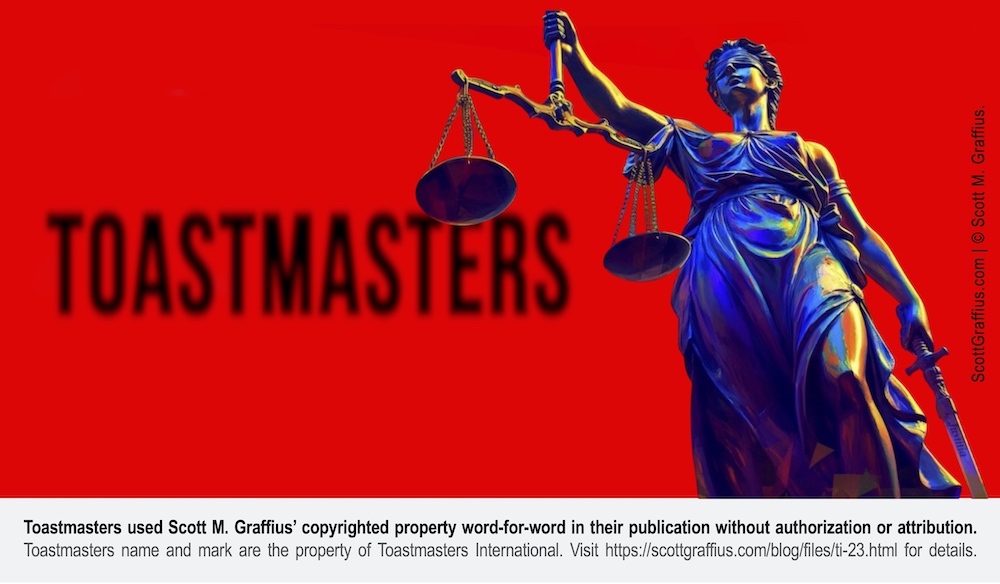

Introduction
Toastmasters used—without authorization or attribution—Scott M. Graffius’ copyrighted property in their publication. Based on the indisputable facts, Toastmasters’ bad acts involve the ethical issue of plagiarism and the legal issue of copyright infringement.
Graffius maintains, enforces, and protects his copyright and other intellectual property rights. This article serves as a clarion call for Toastmasters to face the repercussions of, and take responsibility for, their blatant and damaging violation.

Background
Informed by the research of Bruce W. Tuckman, Ph.D., and Mary Ann C. Jensen, over 100 subsequent studies, and Scott M. Graffius’ first-hand professional experience with, and analysis of, team leadership and performance, Graffius created his ‘Phases of Team Development.’ It’s a unique perspective on the five phases of team development—Forming, Storming, Norming, Performing, and Adjourning—and it’s inclusive of the characteristics/features/traits and strategies for each phase.
Graffius’ ‘Phases of Team Development’ intellectual property is registered with the United States Copyright Office.
Graffius initially developed his intellectual property in 2008, and he periodically refreshes it. For reference, an authorized example of his copyrighted property applicable in this case (2021 edition) is here: https://dx.doi.org/10.13140/RG.2.2.22040.42246 . It is shown below as well (as Exhibit 1).

As shown above, Graffius’ copyright ownership details are integrated into and appear on his copyrighted property. Specifically, it reads: “Copyright © 2008-2021 Scott M. Graffius. All rights reserved. For permission requests, contact scott@scottgraffius.com.”
Conference organizers, businesses, professional associations, government agencies, and universities around the world engage Graffius to deliver compelling talks and workshops. Examples are here.
Graffius’ ‘Phases of Team Development’ intellectual property is central and key to many of those sessions. Details including his rate card, a listing of his engagements, and more are here.
With an authorization/license from Graffius, many organizations around the world have featured and used his copyrighted ‘Phases of Team Development’ work. Select examples include Yale University, Adobe, IEEE, Microsoft, UK Sports Institute, Amsterdam Public Health Research Institute, American Management Association, and many others.
Copyrights protect the intellectual property rights of creators, ensuring they receive recognition and compensation for their work, thus incentivizing creativity and innovation. Graffius is vigilant in upholding, protecting, and enforcing his copyrights and other IP rights.
Toastmasters Used Scott M. Graffius' Copyrighted Property Word-for-Word in Their Publication Without Authorization or Attribution, Violating Graffius’ Intellectual Property Rights
Toastmasters infringing 2022 publication is marked with:
- “Toastmasters International”
- “Area Director Handbook”
- “2022”
- “Guide to a successful year as Area Director”
- “District 101”
Exhibit 2 is below. It shows pages 2, 19, 20, and 21 from the infringing 2022 publication.

Further details follow.
Again, Graffius’ copyright ownership details and permission request information are integrated into and appear on his intellectual property.
Toastmasters did not request nor receive permission to use Graffius’ copyrighted property.
Nevertheless, Toastmasters used Graffius’ 4 January 2021 copyrighted property in their 2022 publication.
Comparing Graffius' copyrighted 4 January 2021 'Phases of Team Development' intellectual property what Toastmasters has in its 2022 publication is reveals Toastmasters’ blatant infringement.
Exhibit 3 is below. It shows Toastmasters extensive—including word-for-word—use of Graffius’ copyrighted property on the characteristics and strategies for the Forming stage of team development.

Exhibit 4 is below. It shows Toastmasters extensive—including word-for-word—use of Graffius’ copyrighted property on the characteristics and strategies for the Storming stage of team development.

Exhibit 5 is below. It shows Toastmasters extensive—including word-for-word—use of Graffius’ copyrighted property on the characteristics and strategies for the Norming stage of team development.

Exhibit 6 is below. It shows Toastmasters extensive—including word-for-word—use of Graffius’ copyrighted property on the characteristics and strategies for the Performing stage of team development.

Exhibit 7 is below. It shows Toastmasters extensive—including word-for-word—use of Graffius’ copyrighted property on the characteristics and strategies for the Adjourning stage of team development.

Further, Toastmasters did not attribute their use of Graffius’ copyrighted property to Graffius. Accordingly, Toastmasters is wrongly leading others to falsely believe that they (or others) are the author and owner of Graffius’ respective copyrighted property.

Conclusion
Again, Graffius’ copyright ownership details and permission request information are integrated into and appear on his intellectual property.
Toastmasters did not request nor receive permission to use Graffius’ copyrighted property.
Nevertheless, Toastmasters used Graffius’ 4 January 2021 copyrighted property in their 2022 infringing publication.
Toastmasters used a significant volume of Graffius’ copyrighted property.
Toastmasters’ infringement included extensive word-for-word use of Graffius’ copyrighted property.
Toastmasters did not attribute their use of Graffius’ copyrighted property to Graffius. Accordingly, Toastmasters is wrongly leading others to falsely believe that they (or others) are the author and owner of Graffius’ respective copyrighted content.
Toastmasters damaged the marketability and value of Graffius’ copyrighted property.
For the aforementioned reasons, Toastmasters’ use of Graffius’ copyrighted property was not ‘fair use’ nor otherwise allowed.
Additionally, the Digital Millennium Copyright Act (DMCA), 17 U.S. Code § 1202, addresses the integrity of copyright management information. It specifies that that removal of copyright information from another’s intellectual property is a crime. That’s for all cases, including educational/non-commercial use. As shown by comparing Graffius' copyrighted property (Exhibit 1) and with page 19 of Toastmasters infringing publication (shown in Exhibit 2), Toastmasters cropped-out or otherwise removed Graffius’ copyright information. That alone makes Toastmasters' actions not ‘fair use’ and a crime.
Toastmasters’ actions in this matter are a disgraceful breach of professional ethics, moral standards, and Graffius’ intellectual property rights.
So long as the infringing publication exists in any form, Toastmasters knowingly and willfully continues to spread misinformation and violate Graffius’ intellectual property rights.
Toastmasters must immediately implement the following three (3) actions:
- Remove the Infringing Material. Electronic Versions: Immediately remove the infringing material from all digital platforms where it is advertised, promoted, sold, or distributed; this includes removing or disabling any online access to it. Physical Copies: If physical copies of the material are in inventory or circulation, stop further distribution; recall any copies already distributed; destroy (recycle) physical copies.
- Issue a Retraction. Publish a formal retraction notice acknowledging the infringement and the steps taken to rectify the situation. The notice will present the facts as they are—the notice will not "spin" or "downplay" the infringement.
- Notify Relevant Parties. Subscribers and Purchasers and other Recipients: Inform the respective subscribers, purchasers, or recipients of the material about the retraction, ensuring transparency about the issue; again, the notice will present the facts as they are—the notice will not "spin" or "downplay" the infringement. Indexes and Databases: Notify any databases or indexing services that list the material so they can update their records accordingly.
Graffius maintains, enforces, and protects his copyright and other intellectual property rights. He reserves his rights in this damaging, disturbing, and consequential matter.
This article serves as a clarion call for Toastmasters to face the repercussions of, and take responsibility for, their blatant and damaging violation.
This case is open.

About Scott M. Graffius

Scott M. Graffius is a global leader in agile project management, an expert on teamwork tradecraft, an authority on temporal dynamics on social media platforms, a creator, a consultant, a trainer, an award-winning author, and an international public speaker.
See his bio to learn more.









About Agile Scrum: Your Quick Start Guide with Step-by-Step Instructions

Shifting customer needs are common in today's marketplace. Businesses must be adaptive and responsive to change while delivering an exceptional customer experience to be competitive.
There are a variety of frameworks supporting the development of products and services, and most approaches fall into one of two broad categories: traditional or agile. Traditional practices such as waterfall engage sequential development, while agile involves iterative and incremental deliverables. Organizations are increasingly embracing agile to manage projects, and best meet their business needs of rapid response to change, fast delivery speed, and more.
With clear and easy to follow step-by-step instructions, Scott M. Graffius's award-winning Agile Scrum: Your Quick Start Guide with Step-by-Step Instructions helps the reader:
- Implement and use the most popular agile framework―Scrum;
- Deliver products in short cycles with rapid adaptation to change, fast time-to-market, and continuous improvement; and
- Support innovation and drive competitive advantage.
Hailed by Literary Titan as “the book highlights the versatility of Scrum beautifully.”
Winner of 17 first place awards.
Agile Scrum: Your Quick Start Guide with Step-by-Step Instructions is available in paperback and ebook/Kindle in the United States and around the world. Some links by country follow.
- 🇧🇷 Brazil
- 🇨🇦 Canada
- 🇨🇿 Czech Republic
- 🇩🇰 Denmark
- 🇫🇮 Finland
- 🇫🇷 France
- 🇩🇪 Germany
- 🇬🇷 Greece
- 🇭🇺 Hungary
- 🇮🇳 India
- 🇮🇪 Ireland
- 🇮🇱 Israel
- 🇮🇹 Italy
- 🇯🇵 Japan
- 🇱🇺 Luxembourg
- 🇲🇽 Mexico
- 🇳🇱 Netherlands
- 🇳🇿 New Zealand
- 🇳🇴 Norway
- 🇪🇸 Spain
- 🇸🇪 Sweden
- 🇨🇭 Switzerland
- 🇦🇪 UAE
- 🇬🇧 United Kingdom
- 🇺🇸 United States

About Agile Transformation: A Brief Story of How an Entertainment Company Developed New Capabilities and Unlocked Business Agility to Thrive in an Era of Rapid Change

Thriving in today's marketplace frequently depends on making a transformation to become more agile. Those successful in the transition enjoy faster delivery speed and ROI, higher satisfaction, continuous improvement, and additional benefits.
Based on actual events, Agile Transformation: A Brief Story of How an Entertainment Company Developed New Capabilities and Unlocked Business Agility to Thrive in an Era of Rapid Change provides a quick (60-90 minute) read about a successful agile transformation at a multinational entertainment and media company, told from the author's perspective as an agile coach.
The award-winning book by Scott M. Graffius is available in paperback and ebook/Kindle in the United States and around the world. Some links by country follow.
- 🇦🇺 Australia
- 🇦🇹 Austria
- 🇧🇷 Brazil
- 🇨🇦 Canada
- 🇨🇿 Czech Republic
- 🇩🇰 Denmark
- 🇫🇮 Finland
- 🇫🇷 France
- 🇩🇪 Germany
- 🇬🇷 Greece
- 🇮🇳 India
- 🇮🇪 Ireland
- 🇯🇵 Japan
- 🇱🇺 Luxembourg
- 🇲🇽 Mexico
- 🇳🇱 Netherlands
- 🇳🇿 New Zealand
- 🇪🇸 Spain
- 🇸🇪 Sweden
- 🇨🇭 Switzerland
- 🇦🇪 United Arab Emirates
- 🇬🇧 United Kingdom
- 🇺🇸 United States


How to Cite This Article
Graffius, Scott M. (2023, October 23). Toastmasters Used Scott M. Graffius' Copyrighted Property Word-for-Word in Their Publication Without Authorization or Attribution. Available at: https://scottgraffius.com/blog/files/ti-23.html. DOI: 10.13140/RG.2.2.18914.34240.


Post-Publication Notes
If there are any supplements or updates to this article after the date of publication, they will appear here.


Content Acknowledgements
This article uses limited excerpts from Toastmasters International content, attributed to Toastmasters International and used under fair use for news reporting and analysis.
Toastmasters International name, mark, and content (except for what was stolen from others) are the property of Toastmasters International.
Graffius’ ‘Phases of Team Development’ is copyright © Scott M. Graffius. All rights reserved.


Copyright
Copyright © Scott M. Graffius. All rights reserved.
Content on this site—including text, images, videos, and data—may not be used for training or input into any artificial intelligence, machine learning, or automatized learning systems, or published, broadcast, rewritten, or redistributed without the express written permission of Scott M. Graffius.

Scott M. Graffius' 'Phases of Team Development' was Spotlighted in Journal of Neurosurgery


Scott M. Graffius' Work on Team Tradecraft
Informed by the research of Bruce W. Tuckman and Mary Ann C. Jensen, over 100 subsequent studies, and Scott M. Graffius' first-hand professional experience with, and analysis of, team leadership and performance, Graffius created his ‘Phases of Team Development’ as a unique perspective and visual conveying the five phases of team development — Forming, Storming, Norming, Performing, and Adjourning — inclusive of a graph showing how performance varies by phase, as well as the characteristics and strategies for each phase.
Graffius' intellectual property (IP) is registered with the United States Copyright Office.
Graffius initially developed his ‘Phases of Team Development’ unique material in 2008, and he periodically refreshes it.
For reference, the visual for the current (2024) edition is below and the details are here.

Organizations around the world engage Graffius to deliver compelling talks and workshops. To date, he's presented sessions at 91 conferences and other events across 25 countries:
- Armenia,
- Australia,
- Brazil,
- Canada,
- Czech Republic,
- Finland,
- France,
- Germany,
- Greece,
- Hong Kong,
- Hungary,
- India, Ireland,
- Lithuania,
- Luxembourg,
- Nepal,
- Netherlands,
- New Zealand,
- Norway,
- Romania,
- Sweden,
- Switzerland,
- United Arab Emirates,
- United Kingdom,
- and the United States.

Graffius ‘Phases of Team Development’ IP is central and key to many of those sessions. His rate card and a listing of his engagements are at https://scottgraffius.com/resources/Exceptional-PPM-and-PMO-Solutions-Rate-Card-for-2024-2025-v24071607.pdf and https://scottgraffius.com/publicspeaker.html, respectively.
With an authorization/license from Graffius, his ‘Phases of Team Development’ intellectual property is featured and used by businesses, professional associations, government agencies, and universities around the globe. Examples include:
- Adobe,
- American Management Association,
- Amsterdam Public Health Research Institute,
- Bayer
- Boston University,
- Broadcom,
- Cisco,
- Deimos Aerospace,
- DevOps Institute,
- Erste Group Bank AG (Austria),
- FINAT,
- Ford Motor Company,
- FSU College of Medicine,
- Hasso Plattner Institute,
- IEEE,
- James Madison University,
- Johns Hopkins University,
- LeadingEng,
- London South Bank University,
- Manufacturers Alliance,
- Microsoft,
- New Zealand Government,
- Oracle,
- Royal Australasian College of Physicians,
- TBS Switzerland,
- Torrens University Australia,
- Tufts University,
- U.S. National Park Service,
- U.S. Tennis Association,
- UC San Diego,
- UK Sports Institute,
- University of Galway Ireland,
- Victorian Institute of Technology (Australia),
- Virginia Tech,
- Warsaw University,
- Western Sydney University,
- World Resources Institute,
- Yale University,
- ZHAW Zurich University of Applied Sciences,
- and many others.
The Journal of Neurosurgery (JNS) was added to this list! A JNS article — Muhlestein, W. E., Chang, K. W. C., Justice, D., Johnson, S., Brown, S., & Popadich, M. (2023). Developing interdisciplinary research teams in neurosurgery: key elements to success in brachial plexus and peripheral nerve surgery. Journal of Neurosurgery, 139 (6), 1552-1559. https://doi.org/10.3171/2023.4.JNS222254 — featured Graffius' 'Phases of Team Development' intellectual property on teamwork tradecraft.
The first page of the article is shown below.

Next, citation 40 (a reference to Graffius' work) annotation is shown below.

Team development material, based on Graffius' work, is shown below.

Lastly, citation 40 in the References section is shown below.

Read on to learn:
- About the Journal of Neurosurgery,
- About Scott M. Graffius,
- How to Cite This Article,
- and more.

About the Journal of Neurosurgery
The Journal of Neurosurgery (JNS) is a leading, peer-reviewed medical journal dedicated to advancing the field of neurosurgery. Published by the American Association of Neurological Surgeons (AANS), it serves as a premier platform for original research, clinical studies, and innovative techniques in the diagnosis and treatment of neurological conditions. With a history spanning over 75 years, JNS is widely recognized for its commitment to promoting scientific discovery and clinical excellence. Its global readership includes neurosurgeons, researchers, and healthcare professionals striving to improve patient outcomes.

About Scott M. Graffius

Scott M. Graffius is an agile project management expert practitioner, consultant, award-winning author, and international public speaker.
Graffius has generated more than USD $1.9 billion in business value for organizations served, including Fortune 500 companies. Businesses and industries range from technology (including R&D and AI) to entertainment, financial services, and healthcare, government, social media, and more.
Graffius leads the professional services firm Exceptional PPM and PMO Solutions, along with its subsidiary Exceptional Agility. These consultancies offer strategic and tactical advisory, training, embedded talent, and consulting services to public, private, and government sectors. They help organizations enhance their capabilities and results in agile, project management, program management, portfolio management, and PMO leadership, supporting innovation and driving competitive advantage. The consultancies confidently back services with a Delighted Client Guarantee™. Graffius is a former vice president of project management with a publicly traded provider of diverse consumer products and services over the Internet. Before that, he ran and supervised the delivery of projects and programs in public and private organizations with businesses ranging from e-commerce to advanced technology products and services, retail, manufacturing, entertainment, and more. He has experience with consumer, business, reseller, government, and international markets.
He is the author of two award-winning books.
- His first book, Agile Scrum: Your Quick Start Guide with Step-by-Step Instructions (ISBN-13: 9781533370242), received 17 awards.
- His second book is Agile Transformation: A Brief Story of How an Entertainment Company Developed New Capabilities and Unlocked Business Agility to Thrive in an Era of Rapid Change (ISBN-13: 9781072447962). BookAuthority named it one of the best Scrum books of all time.
Organizations around the world invite Graffius to speak on tech (including AI), agile, project management, program management, portfolio management, and PMO leadership. He has developed and delivered unique and compelling talks and workshops. To date, Graffius has delivered 91 sessions across 25 countries. Select examples of events include Agile Trends Gov, BSides (Newcastle Upon Tyne), Conf42 Quantum Computing, DevDays Europe, DevOps Institute, DevOpsDays (Geneva), Frug’Agile, IEEE, Microsoft, Scottish Summit, Scrum Alliance RSG (Nepal), Techstars, and W Love Games International Video Game Development Conference (Helsinki), and more. With an average rating of 4.81 (on a scale of 1-5), his sessions are highly valued.
Prominent businesses, professional associations, government agencies, and universities have featured Graffius and his work including content from his books, talks, workshops, and more. Select examples include:
- Adobe,
- American Management Association,
- Amsterdam Public Health Research Institute,
- Bayer,
- Boston University,
- Broadcom,
- Cisco,
- Constructor University Germany,
- Deimos Aerospace,
- DevOps Institute,
- EU's European Commission,
- Ford Motor Company,
- Hasso Plattner Institute Germany,
- IEEE,
- Johns Hopkins University,
- London South Bank University,
- Microsoft,
- National Academy of Sciences,
- New Zealand Government,
- Oracle,
- Pinterest Inc.,
- Project Management Institute,
- TBS Switzerland,
- Torrens University Australia,
- Tufts University,
- UC San Diego,
- UK Sports Institute,
- University of Galway Ireland,
- U.S. Department of Energy,
- U.S. National Park Service,
- U.S. Tennis Association,
- Virginia Tech,
- Warsaw University of Technology,
- Yale University,
- and many others.
Graffius has been actively involved with the Project Management Institute (PMI) in the development of professional standards. He was a member of the team which produced the Practice Standard for Work Breakdown Structures—Second Edition. Graffius was a contributor and reviewer of A Guide to the Project Management Body of Knowledge—Sixth Edition, The Standard for Program Management—Fourth Edition, and The Practice Standard for Project Estimating—Second Edition. He was also a subject matter expert reviewer of content for the PMI’s Congress. Beyond the PMI, Graffius also served as a member of the review team for two of the Scrum Alliance’s Global Scrum Gatherings.
Graffius has a bachelor’s degree in psychology with a focus in Human Factors. He holds eight professional certifications:
- Certified SAFe 6 Agilist (SA),
- Certified Scrum Professional - ScrumMaster (CSP-SM),
- Certified Scrum Professional - Product Owner (CSP-PO),
- Certified ScrumMaster (CSM),
- Certified Scrum Product Owner (CSPO),
- Project Management Professional (PMP),
- Lean Six Sigma Green Belt (LSSGB), and
- IT Service Management Foundation (ITIL).
He is an active member of the Scrum Alliance, the Project Management Institute (PMI), and the Institute of Electrical and Electronics Engineers (IEEE).
He divides his time between Los Angeles and Paris, France.









About Agile Scrum: Your Quick Start Guide with Step-by-Step Instructions

Shifting customer needs are common in today's marketplace. Businesses must be adaptive and responsive to change while delivering an exceptional customer experience to be competitive.
There are a variety of frameworks supporting the development of products and services, and most approaches fall into one of two broad categories: traditional or agile. Traditional practices such as waterfall engage sequential development, while agile involves iterative and incremental deliverables. Organizations are increasingly embracing agile to manage projects, and best meet their business needs of rapid response to change, fast delivery speed, and more.
With clear and easy to follow step-by-step instructions, Scott M. Graffius's award-winning Agile Scrum: Your Quick Start Guide with Step-by-Step Instructions helps the reader:
- Implement and use the most popular agile framework―Scrum;
- Deliver products in short cycles with rapid adaptation to change, fast time-to-market, and continuous improvement; and
- Support innovation and drive competitive advantage.
Hailed by Literary Titan as “the book highlights the versatility of Scrum beautifully.”
Winner of 17 first place awards.
Agile Scrum: Your Quick Start Guide with Step-by-Step Instructions is available in paperback and ebook/Kindle in the United States and around the world. Some links by country follow.
- 🇧🇷 Brazil
- 🇨🇦 Canada
- 🇨🇿 Czech Republic
- 🇩🇰 Denmark
- 🇫🇮 Finland
- 🇫🇷 France
- 🇩🇪 Germany
- 🇬🇷 Greece
- 🇭🇺 Hungary
- 🇮🇳 India
- 🇮🇪 Ireland
- 🇮🇱 Israel
- 🇮🇹 Italy
- 🇯🇵 Japan
- 🇱🇺 Luxembourg
- 🇲🇽 Mexico
- 🇳🇱 Netherlands
- 🇳🇿 New Zealand
- 🇳🇴 Norway
- 🇪🇸 Spain
- 🇸🇪 Sweden
- 🇨🇭 Switzerland
- 🇦🇪 UAE
- 🇬🇧 United Kingdom
- 🇺🇸 United States

About Agile Transformation: A Brief Story of How an Entertainment Company Developed New Capabilities and Unlocked Business Agility to Thrive in an Era of Rapid Change

Thriving in today's marketplace frequently depends on making a transformation to become more agile. Those successful in the transition enjoy faster delivery speed and ROI, higher satisfaction, continuous improvement, and additional benefits.
Based on actual events, Agile Transformation: A Brief Story of How an Entertainment Company Developed New Capabilities and Unlocked Business Agility to Thrive in an Era of Rapid Change provides a quick (60-90 minute) read about a successful agile transformation at a multinational entertainment and media company, told from the author's perspective as an agile coach.
The award-winning book by Scott M. Graffius is available in paperback and ebook/Kindle in the United States and around the world. Some links by country follow.
- 🇦🇺 Australia
- 🇦🇹 Austria
- 🇧🇷 Brazil
- 🇨🇦 Canada
- 🇨🇿 Czech Republic
- 🇩🇰 Denmark
- 🇫🇮 Finland
- 🇫🇷 France
- 🇩🇪 Germany
- 🇬🇷 Greece
- 🇮🇳 India
- 🇮🇪 Ireland
- 🇯🇵 Japan
- 🇱🇺 Luxembourg
- 🇲🇽 Mexico
- 🇳🇱 Netherlands
- 🇳🇿 New Zealand
- 🇪🇸 Spain
- 🇸🇪 Sweden
- 🇨🇭 Switzerland
- 🇦🇪 United Arab Emirates
- 🇬🇧 United Kingdom
- 🇺🇸 United States


How to Cite This Article
Graffius, Scott M. (2024, December 20). Scott M. Graffius' 'Phases of Team Development' was Spotlighted in Journal of Neurosurgery. Available at: https://scottgraffius.com/blog/files/jns-2024.html. DOI: 10.13140/RG.2.2.31746.59849.


Post-Publication Notes
If there are any supplements or updates to this article after the date of publication, they will appear here.


Content Acknowledgements
This article includes limited excerpts from the Journal of Neurosurgery, attributed to the Journal of Neurosurgery and used under fair use for news reporting and analysis.
Journal of Neurosurgery name, mark and content are the property of the American Association of Neurological Surgeons.
Graffius’ ‘Phases of Team Development’ is copyright © Scott M. Graffius. All rights reserved. Visit ScottGraffius.com to learn more.


Short Link for Article
The short link for this article is https://bit.ly/the-jns


Copyright
Copyright © Scott M. Graffius. All rights reserved.
Content on this site—including text, images, videos, and data—may not be used for training or input into any artificial intelligence, machine learning, or automatized learning systems, or published, broadcast, rewritten, or redistributed without the express written permission of Scott M. Graffius.

Verizon Features Scott M. Graffius


Scott M. Graffius' Intellectual Property on Teamwork
Informed by the research of Bruce W. Tuckman and Mary Ann C. Jensen, over 100 subsequent studies, and Scott M. Graffius' first-hand professional experience with, and analysis of, team leadership and performance, Graffius created his ‘Phases of Team Development’ as a unique perspective and visual conveying the five phases of team development — Forming, Storming, Norming, Performing, and Adjourning — inclusive of a graph showing how performance varies by phase, as well as the characteristics and strategies for each phase.
Graffius' intellectual property (IP) is registered with the United States Copyright Office.
Graffius initially developed his ‘Phases of Team Development’ unique material in 2008, and he periodically refreshes it.
For reference, the visual for the current (2024) edition is below and the details are here.

Organizations around the world engage Graffius to deliver compelling talks and workshops. To date, he's presented sessions at 91 conferences and other events across 25 countries:
- Armenia,
- Australia,
- Brazil,
- Canada,
- Czech Republic,
- Finland,
- France,
- Germany,
- Greece,
- Hong Kong,
- Hungary,
- India, Ireland,
- Lithuania,
- Luxembourg,
- Nepal,
- Netherlands,
- New Zealand,
- Norway,
- Romania,
- Sweden,
- Switzerland,
- United Arab Emirates,
- United Kingdom,
- and the United States.

Graffius ‘Phases of Team Development’ IP is central and key to many of those sessions. His rate card and a listing of his engagements are at https://scottgraffius.com/resources/Exceptional-PPM-and-PMO-Solutions-Rate-Card-for-2024-2025-v24071607.pdf and https://scottgraffius.com/publicspeaker.html, respectively.
With an authorization/license from Graffius, his ‘Phases of Team Development’ intellectual property is featured and used by businesses, professional associations, government agencies, and universities around the globe. Examples include:
- Adobe,
- American Management Association,
- Amsterdam Public Health Research Institute,
- Bayer
- Boston University,
- Broadcom,
- Cisco,
- Deimos Aerospace,
- DevOps Institute,
- Erste Group Bank AG (Austria),
- FINAT,
- Ford Motor Company,
- FSU College of Medicine,
- Hasso Plattner Institute,
- IEEE,
- James Madison University,
- Johns Hopkins University,
- LeadingEng,
- London South Bank University,
- Manufacturers Alliance,
- Microsoft,
- New Zealand Government,
- Oracle,
- Mary Raum (Professor of National Security Affairs, United States Naval War College),
- Royal Australasian College of Physicians,
- TBS Switzerland,
- Torrens University Australia,
- Tufts University,
- U.S. National Park Service,
- U.S. Tennis Association,
- UC San Diego,
- UK Sports Institute,
- University of Galway Ireland,
- Victorian Institute of Technology (Australia),
- Virginia Tech,
- Warsaw University,
- Western Sydney University,
- World Resources Institute,
- Yale University,
- ZHAW Zurich University of Applied Sciences,
- and many others.
Verizon was added to this list!
As shown below, Graffius' work was spotlighted in two articles.

Both the 14 May 2024 and 21 May 2024 articles by Verizon Associate Director Cheryl Abellanoza, PhD, highlight and link to Graffius' 'Phases of Team Development' intellectual property on teamwork. They link to the 2021 edition of Graffius' work, here and here. The current (2024) edition is here.
Read on to learn:
- About Verizon,
- About Scott M. Graffius,
- How to Cite This Article,
- and more.

About Verizon
Verizon (NYSE: VZ) is a leading provider of technology, communications, information, and entertainment products and services. Founded in 1983 and headquartered in New York City, Verizon is a global leader in delivering innovative solutions across mobility, broadband, and digital platforms. The company operates one of the most reliable wireless networks in the United States, serving millions of consumers, businesses, and government customers. In addition to its telecommunications services, Verizon is at the forefront of advancing 5G technology, aiming to transform industries such as healthcare, manufacturing, and public safety. Recognized for its forward-thinking strategies, Verizon continues to shape the future of connectivity and digital transformation.

About Scott M. Graffius

Scott M. Graffius is an agile project management expert practitioner, consultant, award-winning author, and international public speaker.
Graffius has generated more than USD $1.9 billion in business value for organizations served, including Fortune 500 companies. Businesses and industries range from technology (including R&D and AI) to entertainment, financial services, and healthcare, government, social media, and more.
Graffius leads the professional services firm Exceptional PPM and PMO Solutions, along with its subsidiary Exceptional Agility. These consultancies offer strategic and tactical advisory, training, embedded talent, and consulting services to public, private, and government sectors. They help organizations enhance their capabilities and results in agile, project management, program management, portfolio management, and PMO leadership, supporting innovation and driving competitive advantage. The consultancies confidently back services with a Delighted Client Guarantee™. Graffius is a former vice president of project management with a publicly traded provider of diverse consumer products and services over the Internet. Before that, he ran and supervised the delivery of projects and programs in public and private organizations with businesses ranging from e-commerce to advanced technology products and services, retail, manufacturing, entertainment, and more. He has experience with consumer, business, reseller, government, and international markets.
He is the author of two award-winning books.
- His first book, Agile Scrum: Your Quick Start Guide with Step-by-Step Instructions (ISBN-13: 9781533370242), received 17 awards.
- His second book is Agile Transformation: A Brief Story of How an Entertainment Company Developed New Capabilities and Unlocked Business Agility to Thrive in an Era of Rapid Change (ISBN-13: 9781072447962). BookAuthority named it one of the best Scrum books of all time.
Organizations around the world invite Graffius to speak on tech (including AI), agile, project management, program management, portfolio management, and PMO leadership. He has developed and delivered unique and compelling talks and workshops. To date, Graffius has delivered 91 sessions across 25 countries. Select examples of events include Agile Trends Gov, BSides (Newcastle Upon Tyne), Conf42 Quantum Computing, DevDays Europe, DevOps Institute, DevOpsDays (Geneva), Frug’Agile, IEEE, Microsoft, Scottish Summit, Scrum Alliance RSG (Nepal), Techstars, and W Love Games International Video Game Development Conference (Helsinki), and more. With an average rating of 4.81 (on a scale of 1-5), his sessions are highly valued.
Prominent businesses, professional associations, government agencies, and universities have featured Graffius and his work including content from his books, talks, workshops, and more. Select examples include:
- Adobe,
- American Management Association,
- Amsterdam Public Health Research Institute,
- Bayer,
- Boston University,
- Broadcom,
- Cisco,
- Constructor University Germany,
- Deimos Aerospace,
- DevOps Institute,
- EU's European Commission,
- Ford Motor Company,
- Hasso Plattner Institute Germany,
- IEEE,
- Johns Hopkins University,
- London South Bank University,
- Microsoft,
- National Academy of Sciences,
- New Zealand Government,
- Oracle,
- Pinterest Inc.,
- Project Management Institute,
- TBS Switzerland,
- Torrens University Australia,
- Tufts University,
- UC San Diego,
- UK Sports Institute,
- University of Galway Ireland,
- U.S. Department of Energy,
- U.S. National Park Service,
- U.S. Tennis Association,
- Virginia Tech,
- Warsaw University of Technology,
- Yale University,
- and many others.
Graffius has been actively involved with the Project Management Institute (PMI) in the development of professional standards. He was a member of the team which produced the Practice Standard for Work Breakdown Structures—Second Edition. Graffius was a contributor and reviewer of A Guide to the Project Management Body of Knowledge—Sixth Edition, The Standard for Program Management—Fourth Edition, and The Practice Standard for Project Estimating—Second Edition. He was also a subject matter expert reviewer of content for the PMI’s Congress. Beyond the PMI, Graffius also served as a member of the review team for two of the Scrum Alliance’s Global Scrum Gatherings.
Graffius has a bachelor’s degree in psychology with a focus in Human Factors. He holds eight professional certifications:
- Certified SAFe 6 Agilist (SA),
- Certified Scrum Professional - ScrumMaster (CSP-SM),
- Certified Scrum Professional - Product Owner (CSP-PO),
- Certified ScrumMaster (CSM),
- Certified Scrum Product Owner (CSPO),
- Project Management Professional (PMP),
- Lean Six Sigma Green Belt (LSSGB), and
- IT Service Management Foundation (ITIL).
He is an active member of the Scrum Alliance, the Project Management Institute (PMI), and the Institute of Electrical and Electronics Engineers (IEEE).
He divides his time between Los Angeles and Paris, France.









About Agile Scrum: Your Quick Start Guide with Step-by-Step Instructions

Shifting customer needs are common in today's marketplace. Businesses must be adaptive and responsive to change while delivering an exceptional customer experience to be competitive.
There are a variety of frameworks supporting the development of products and services, and most approaches fall into one of two broad categories: traditional or agile. Traditional practices such as waterfall engage sequential development, while agile involves iterative and incremental deliverables. Organizations are increasingly embracing agile to manage projects, and best meet their business needs of rapid response to change, fast delivery speed, and more.
With clear and easy to follow step-by-step instructions, Scott M. Graffius's award-winning Agile Scrum: Your Quick Start Guide with Step-by-Step Instructions helps the reader:
- Implement and use the most popular agile framework―Scrum;
- Deliver products in short cycles with rapid adaptation to change, fast time-to-market, and continuous improvement; and
- Support innovation and drive competitive advantage.
Hailed by Literary Titan as “the book highlights the versatility of Scrum beautifully.”
Winner of 17 first place awards.
Agile Scrum: Your Quick Start Guide with Step-by-Step Instructions is available in paperback and ebook/Kindle in the United States and around the world. Some links by country follow.
- 🇧🇷 Brazil
- 🇨🇦 Canada
- 🇨🇿 Czech Republic
- 🇩🇰 Denmark
- 🇫🇮 Finland
- 🇫🇷 France
- 🇩🇪 Germany
- 🇬🇷 Greece
- 🇭🇺 Hungary
- 🇮🇳 India
- 🇮🇪 Ireland
- 🇮🇱 Israel
- 🇮🇹 Italy
- 🇯🇵 Japan
- 🇱🇺 Luxembourg
- 🇲🇽 Mexico
- 🇳🇱 Netherlands
- 🇳🇿 New Zealand
- 🇳🇴 Norway
- 🇪🇸 Spain
- 🇸🇪 Sweden
- 🇨🇭 Switzerland
- 🇦🇪 UAE
- 🇬🇧 United Kingdom
- 🇺🇸 United States

About Agile Transformation: A Brief Story of How an Entertainment Company Developed New Capabilities and Unlocked Business Agility to Thrive in an Era of Rapid Change

Thriving in today's marketplace frequently depends on making a transformation to become more agile. Those successful in the transition enjoy faster delivery speed and ROI, higher satisfaction, continuous improvement, and additional benefits.
Based on actual events, Agile Transformation: A Brief Story of How an Entertainment Company Developed New Capabilities and Unlocked Business Agility to Thrive in an Era of Rapid Change provides a quick (60-90 minute) read about a successful agile transformation at a multinational entertainment and media company, told from the author's perspective as an agile coach.
The award-winning book by Scott M. Graffius is available in paperback and ebook/Kindle in the United States and around the world. Some links by country follow.
- 🇦🇺 Australia
- 🇦🇹 Austria
- 🇧🇷 Brazil
- 🇨🇦 Canada
- 🇨🇿 Czech Republic
- 🇩🇰 Denmark
- 🇫🇮 Finland
- 🇫🇷 France
- 🇩🇪 Germany
- 🇬🇷 Greece
- 🇮🇳 India
- 🇮🇪 Ireland
- 🇯🇵 Japan
- 🇱🇺 Luxembourg
- 🇲🇽 Mexico
- 🇳🇱 Netherlands
- 🇳🇿 New Zealand
- 🇪🇸 Spain
- 🇸🇪 Sweden
- 🇨🇭 Switzerland
- 🇦🇪 United Arab Emirates
- 🇬🇧 United Kingdom
- 🇺🇸 United States


How to Cite This Article
Graffius, Scott M. (2024, June 3). Verizon Features Scott M. Graffius. Available at: https://scottgraffius.com/blog/files/verizon-features-scott-m-graffius.html. DOI: 10.13140/RG.2.2.11276.42887.


Post-Publication Notes
If there are any supplements or updates to this article after the date of publication, they will appear here.


Content Acknowledgements
This article includes limited excerpts from Verizon Associate Director Cheryl Abellanoza, PhD, attributed to Cheryl Abellanoza, PhD, and used under fair use for news reporting and analysis.
Verizon name and mark are the property of Verizon.
Scott M. Graffius’ ‘Phases of Team Development’ is copyright © Scott M. Graffius.


Short Link for Article
The short link for this article is https://bit.ly/team-vz


Copyright
Copyright © Scott M. Graffius. All rights reserved.
Content on this site—including text, images, videos, and data—may not be used for training or input into any artificial intelligence, machine learning, or automatized learning systems, or published, broadcast, rewritten, or redistributed without the express written permission of Scott M. Graffius.

Government of Finland Agency Features Graffius' Phases of Team Development IP
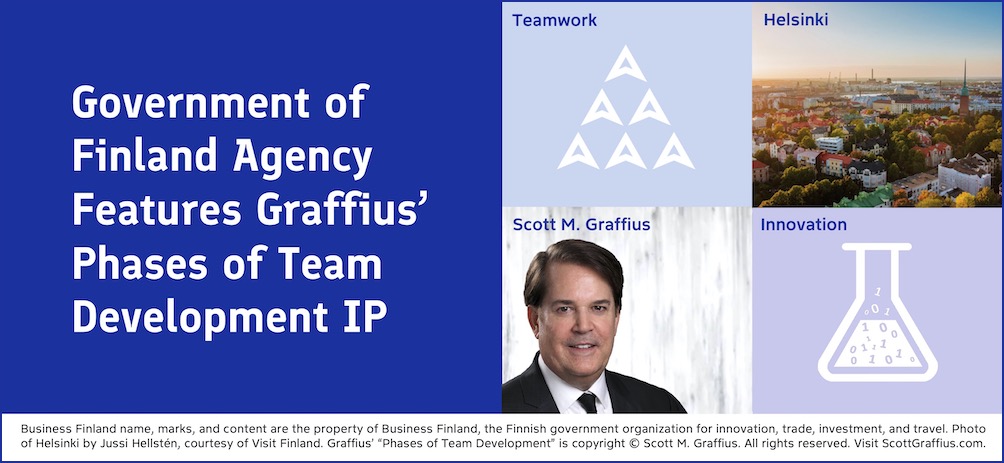

Introduction with Background
Informed by the research of Bruce W. Tuckman and Mary Ann C. Jensen, over 100 subsequent studies, and Scott M. Graffius' first-hand professional experience with, and analysis of, team leadership and performance, Graffius created his ‘Phases of Team Development’ as a unique perspective and visual conveying the five phases of team development — Forming, Storming, Norming, Performing, and Adjourning — inclusive of a graph showing how performance varies by phase, as well as the characteristics and strategies for each phase.
Graffius' intellectual property (IP) is registered with the United States Copyright Office.
Graffius initially developed his 'Phases of Team Development' unique material in 2008, and he periodically refreshes it.
For reference, the visual for the current (2025) edition is below and the details are here.

Organizations around the world engage Graffius to deliver compelling talks and workshops. To date, he's presented sessions at 95 conferences and other events across 25 countries:
- Armenia,
- Australia,
- Brazil,
- Canada,
- Czech Republic,
- Finland,
- France,
- Germany,
- Greece,
- Hong Kong,
- Hungary,
- India, Ireland,
- Lithuania,
- Luxembourg,
- Nepal,
- Netherlands,
- New Zealand,
- Norway,
- Romania,
- Sweden,
- Switzerland,
- United Arab Emirates,
- United Kingdom,
- and the United States.
Graffius 'Phases of Team Development' IP is central and key to many of those sessions. His rate card and a listing of his engagements are at https://scottgraffius.com/resources/Exceptional-PPM-and-PMO-Solutions-Rate-Card-for-2024-2025-v24071607.pdf and https://scottgraffius.com/publicspeaker.html, respectively.
With authorization/license from Graffius, his 'Phases of Team Development' intellectual property is featured and used by businesses, professional associations, government agencies, universities, and others around the world. Examples include:
- Adobe,
- American Management Association,
- Amsterdam Public Health Research Institute,
- Bayer
- Boston University,
- Broadcom,
- Cisco,
- Deimos Aerospace,
- DevOps Institute,
- Erste Group Bank AG (Austria),
- FINAT,
- Ford Motor Company,
- FSU College of Medicine,
- Hasso Plattner Institute,
- IEEE,
- James Madison University,
- Johns Hopkins University,
- LeadingEng,
- London South Bank University,
- Manufacturers Alliance,
- Microsoft,
- New Zealand Government,
- Oracle,
- Mary Raum (Professor of National Security Affairs, United States Naval War College),
- Royal Australasian College of Physicians,
- TBS Switzerland,
- Torrens University Australia,
- Tufts University,
- U.S. National Park Service,
- U.S. Soccer,
- U.S. Tennis Association,
- UC San Diego,
- UK Sports Institute,
- University of Galway Ireland,
- Victorian Institute of Technology (Australia),
- Virginia Tech,
- Warsaw University,
- Western Sydney University,
- World Resources Institute,
- Yale University,
- ZHAW Zurich University of Applied Sciences,
- and many others.
A Government of Finland Agency was Added to the List!
Business Finland is the Finnish government organization dedicated to promoting innovation, trade, investment, and travel. Operating under the Ministry of Employment and the Economy, it plays a central role in strengthening Finland’s global competitiveness and fostering sustainable economic growth. The agency provides funding for research and development, supports startups and established enterprises, and connects Finnish companies with international markets. Business Finland is also known for initiatives such as Talent Boost, which helps attract and integrate international talent into Finland’s workforce. With offices in dozens of countries and an extensive global network, it serves as Finland’s official link to the international business community. Widely respected as a trusted government partner, Business Finland is recognized for advancing innovation and enabling collaboration between businesses, academia, and the public sector. Its scope, influence, and reputation make it one of the most important economic development agencies in Europe.
Business Finland featured Scott M. Graffius’ Phases of Team Development framework in their Talent Boost leadership program on August 6, 2025. A photo from the event is shown below.
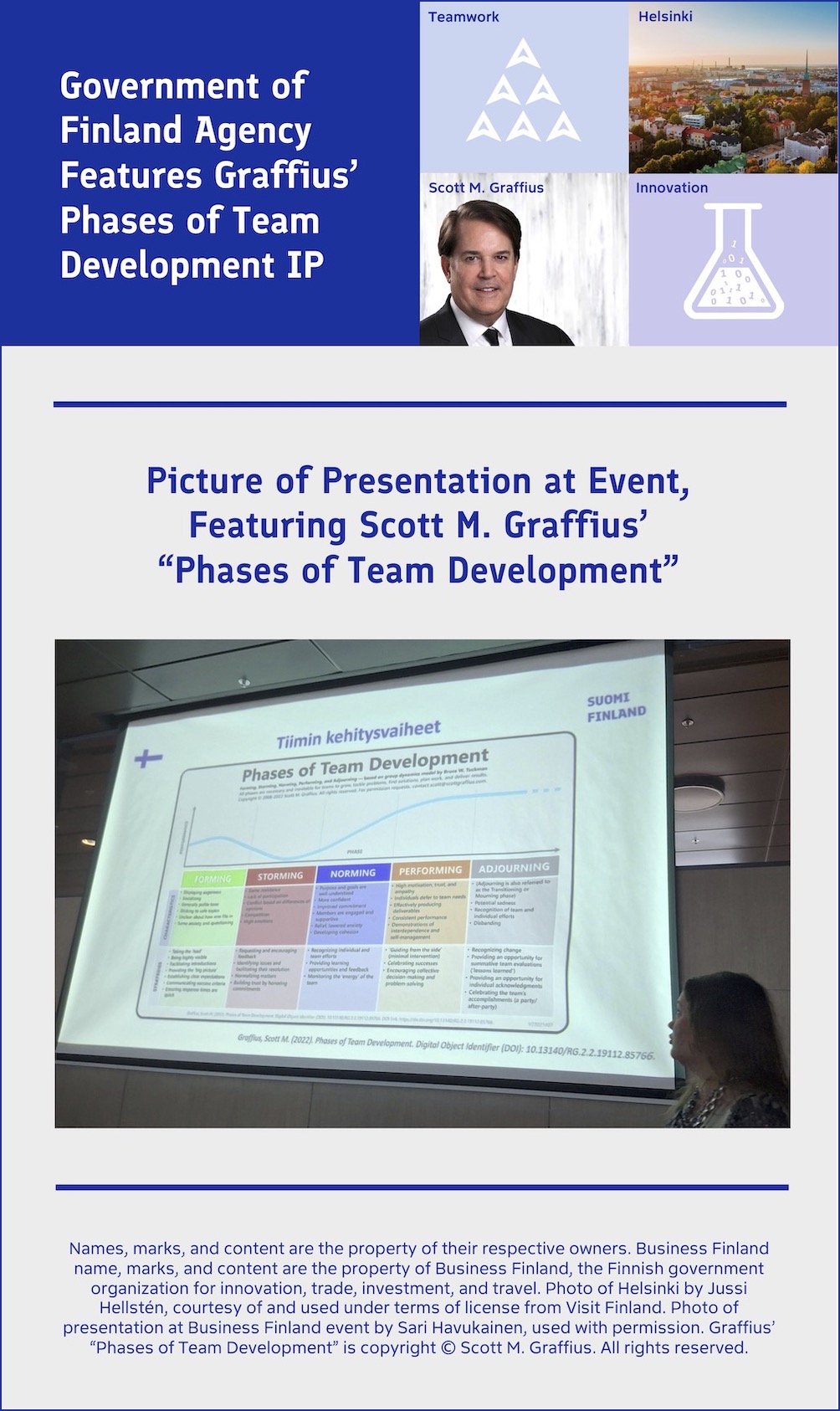
To learn more about Graffius' 'Phases of Team Development' work, visit here.
The Business Finland event is described in a LinkedIn post here.

More
Continue reading for:
- Additional Articles,
- About Scott M. Graffius,
- How to Cite This Article,
- and more.

Additional Articles
You may be interested in these stories.
Environmental Science Journal References Scott M. Graffius’ Project Management Work
AI Institute of Switzerland Features Scott M. Graffius’ Work on Algorithms
Exotic Team Dynamics: The New Frontier of Human–AI Collaboration
Scott M. Graffius’ Work Featured at ACM DIS ’25
Climbing the Ladder: The Head of Agile/PMO’s Organizational Proximity to the CEO is Closer Than Ever
Harness Sci-Fi and Speculative Design While Embracing Imperfection to Drive Innovation and Proactively Predict and Prepare for the Future
Scott M. Graffius’ “Agile Scrum” Book Featured in a Publication of the Associação Nacional de Educação Católica do Brasil (ANEC)
Setting Direction with OKRs and Tracking Progress with KPIs: A Guide for Agile, Project Management, and Tech Teams
AI Showcase Showdown: Ranking AI Accuracy on Project Management Basics
BookAuthority Features “Agile Scrum” by Scott M. Graffius in “10 Agile Software Development Books That Define the Field”
Exploring Team Dynamics, Adaptability, and Creative Problem-Solving Through Felix the Cat’s Metaphorical Toolkit
Mind Games and Master Plans: How PsyOps Exploit Psychological Phenomena
The “Pants-on-Fire Index for AI”
16 Causes of Technical Debt and How to Avoid It
PMI’s Infinity AI Gets the Basics of Team Development Alarmingly and Repeatedly Wrong
Agile for Unicorns: 7 Keys to Thrive; Scott M. Graffius’ Workshop
Scott M. Graffius’ “Agile Scrum: Your Quick Start Guide with Step-by-Step Instructions” Featured in Prestigious National Academies of Sciences Publication
Meta and Anduril’s EagleEye and the Future of XR: How Gaming, AI, and Agile Are Transforming Defense
"Agile Protocol" and the Power of Satire, Parody, and Humor
AI in Agile: Benefits, Risks, Outlook
Hostinger Highlights Scott M. Graffius’ “Agile Protocol” Book in Feature on Software Projects
French Ministry of Culture Links to Scott M. Graffius Research in Their Guide for Responsible Digital Communication
National Science Foundation’s LTER Network Features Scott M. Graffius’ Phases of Team Development IP
Waterfall vs. Agile: What’s Fixed, What’s Flexible, and Why It Matters
Scott M. Graffius Delivering $2.3 Billion in Value Through AI, Agile, and Project/PMO Leadership
The Problem with Heroes in Agile
The 3 Vital Rules of Science: What They Are and Why They Matter
“Agile Protocol: The Transformation Ultimatum” Lands on the Amazon Best Sellers List!
Scott M. Graffius Recognized as a Top Thought Leader in Digital Disruption by Thinkers360
“Agile Protocol: The Transformation Ultimatum” by Scott M. Graffius Crashes the Book Scene with Satirical Firepower
NCKU in Taiwan Integrates Graffius' 'Phases of Team Development' into Its Curriculum
The Art and Science of Aligning Initiatives with Strategic Objectives
RGPV University Adds Scott M. Graffius’ "Agile Scrum: Your Quick Start Guide with Step-by-Step Instructions" to Its Syllabus
Introducing ‘Engage or Fade: Decoding the Half-Life of Digital Resonance’ – A New Talk by Scott M. Graffius
Dropbox Company (Nira) Taps into Scott M. Graffius’ Expertise in Strategic Planning
Reporting Errors in a Publication: A Case Study on ‘Frontiers in Public Health’
NESEA Conference Session on Innovation Highlights Scott M. Graffius' 'Phases of Team Development'
U.S. Soccer Scores with Scott M. Graffius' Intellectual Property on Teamwork
U.S. Department of Commerce Partner (IEDC) Features Scott M. Graffius’ Intellectual Property
How Long Do Your Posts Live? AI Critiques Scott M. Graffius’ Research on the Half-Life of Social Media
Agile's Journey Through the Decades
Scott M. Graffius' Role in Advancing Project Management Institute (PMI) Standards Excellence
Most Valuable IT Certifications: Update for 2025
The PMI + Agile Alliance Merger: A Recipe for Success?
When Agile, AI, and Strategic Thinking Converge
Scott M. Graffius’ Phases of Team Development: 2025 Update
Lifespan (Half-Life) of Social Media Posts: Update for 2025
Verizon Features Scott M. Graffius
Do Not Read This Article! An Exploration of the Streisand Effect and Other Phenomena
Scott M. Graffius' 'Phases of Team Development' was Spotlighted in Journal of Neurosurgery
Pinterest Japan Uses Graffius’ Research on Temporal Dynamics on Social Media Platforms
Hochschule Coburg (Coburg University) Germany Uses Scott M. Graffius’ Phases of Team Development IP in Coursework on Agile Development
Wild World of Team Dynamics [Updated Two-Minute Video]
EU Europass Teacher Academy Features Scott M. Graffius’ ‘Phases of Team Development’ in Leadership Training
Side-by-Side Comparison of Retrospectives and Hot Washes
Constructor University 2024 Advanced Software Technology Handbook References Scott M. Graffius' Work on Team Dynamics
Strategies for Medical Team Success Featured Scott M. Graffius’ ‘Phases of Team Development’ Intellectual Property
SBG Neumark — Europe’s Largest Distribution Transformer Plant — Powers Up with Scott M. Graffius’ Intellectual Property
Scott M. Graffius’ Intellectual Property was Employed by the NHS — the Largest Single-Payer Healthcare System in Europe
Luxury Unwrapped: The Ultimate Holiday Gift Guide for Every Budget
Singapore Institute of Technology Features Work of Scott M. Graffius
Tufts University Features Scott M. Graffius 'Phases of Team Development' Intellectual Property
'Cat Herders': Retelling the Massive Success Story
Pennsylvania State Agency Used Scott M. Graffius' Intellectual Property
Copyright Infringement in a Book Published by AuthorHouse / Author Solutions / The Najafi Companies: Publisher Fails to Respond or Take Required Action
Pinterest Inc. References Scott M. Graffius’ Research
Bournemouth University Used Scott M. Graffius’ Intellectual Property
‘Comparative Methodological Guidelines: Handbook for Educators’ Violates Scott M. Graffius’ Copyright
Japan Backlog User Group Event Featured Scott M. Graffius’ ‘Phases of Team Development’
TurningWest's 'Trial'
Radio Silence from the American Association of Neurological Surgeons on Report of Blatant Plagiarism in Their ‘Journal of Neurosurgery’ Publication
Supplement to Graffius' 'Lifespan (Half-Life) of Social Media Posts' Research: Typical Engagement Distribution Pattern for Social Media Posts
How Algorithms Shape the User Experience on Social Media Platforms
Thinkers360 Named Scott M. Graffius a Top Thought Leader on Agile
'Maximizing LinkedIn for Business Growth' Book References and Incorporates Scott M. Graffius' 'Lifespan (Half-Life) of Social Media Posts' Research
Bayer Employs Scott M. Graffius' Intellectual Property
FINAT (Fédération Internationale des Fabricants et Transformateurs d'Adhésifs et Thermocollants sur Papiers et Autres Supports) Features Scott M. Graffius’ Intellectual Property
Broadcom Features Scott M. Graffius' Intellectual Property
Agile Project Management: Insights from Scott M. Graffius in ‘Managing Information Technology’ Book
Harvard Medical School Talk Featured Insights by Scott M. Graffius
Boston Scientific Corporation Utilizes Scott M. Graffius' Intellectual Property
Johns Hopkins University Features the Work of Scott M. Graffius
Oracle Featured Scott M. Graffius' IP on Team Tradecraft in Their Publication
A Certification/Training Company Stole Scott M. Graffius' Copyrighted Property and Used It Word-For-Word: This Scandal is a Big "Dumpster Fire"
Semiconductor Manufacturing Firm Lam Research Features Scott M. Graffius' 'Phases of Team Development' Intellectual Property
Scott M. Graffius' Intellectual Property Was Utilized by Robert W. Malone, MD
U.S. Department of Energy Quoted Scott M. Graffius
Pudgy Penguins CEO Luca Netz Used Scott M. Graffius' Intellectual Property (IP) Without Consent or Credit; That Act was Uncool and Proliferated Bad Vibes
Paper in Peer-Reviewed Academic Journal 'Res Rhetorica' Features Research by Scott M. Graffius on the Lifespan (Half-Life) of Social Media Posts
Scott M. Graffius Speaking on Agile, AI, and Innovation at a Private Event in Dubai
Graffius' 'Phases of Team Development' Featured by TAG at TBS24 Conference in Zermatt Switzerland
Research by Scott M. Graffius Featured at CEWEP 10th Congress (Berlin)
Cisco Features Scott M. Graffius' 'Phases of Team Development' Work
"How Teams Work" Book Referenced Scott M. Graffius' 'Phases of Team Development'
Division of the EU’s European Commission Used Material Developed by Scott M. Graffius
Ford Features Scott M. Graffius' 'Phases of Team Development' Work
UK Telecommunications Regulator Ofcom Featured Research by Scott M. Graffius
The Protocol for Reporting an Error to an Author or Publisher
Research by Scott M. Graffius Featured in Scientific Paper Published by INFORMS
Most Valuable IT Certifications: Update for 2024



About Scott M. Graffius

Scott M. Graffius is a globally recognized technology leader who drives innovation in AI, Agile, and Project Management/PMO leadership.
He’s a practitioner, researcher, thought leader, award-winning author, and keynote speaker who’s taken the stage at 95 conferences and other events across 25 countries.
He’s delivered over $2.3 billion in value for Fortune 500 companies and other leaders in technology, entertainment, financial services, healthcare, and beyond.
Businesses, professional associations, government agencies, and universities use Graffius and feature his work. Examples include Adobe, Bayer, Boston University, Ford, Gartner, Harvard Medical School, IEEE, Johns Hopkins University, Microsoft, National Academy of Sciences, Oracle, Pinterest Inc., Project Management Institute, UC San Diego, Verizon, Yale University, and others.
The following sections provide additional information on his experience, contributions, and influence.
Experience
Graffius heads the professional services firm Exceptional PPM and PMO Solutions, along with its subsidiary Exceptional Agility. These consultancies offer strategic and tactical advisory, training, embedded expertise, and consulting services to the public, private, and government sectors. They help organizations enhance their capabilities and results in agile, project management, program management, portfolio management, and PMO leadership, supporting innovation and driving competitive advantage. The consultancies confidently back services with a Delighted Client Guarantee™.
Graffius is a former VP of project management with a publicly traded provider of diverse consumer products and services over the Internet. Before that, he ran and supervised the delivery of projects and programs in public and private organizations with businesses ranging from e-commerce to advanced technology products and services, retail, manufacturing, entertainment, and more.
He has experience with consumer, business, reseller, government, and international markets.
Award-Winning Author
Graffius has authored three books.
- Agile Scrum: Your Quick Start Guide with Step-by-Step Instructions, his first book, earned 17 awards.
- Agile Transformation: A Brief Story of How an Entertainment Company Developed New Capabilities and Unlocked Business Agility to Thrive in an Era of Rapid Change, his second book, was named one of the best Scrum books of all time by BookAuthority.
- Agile Protocol: The Transformation Ultimatum, his third book and his first work of fiction, was released in April 2025. The book trailer is on YouTube.
International Public Speaker
Organizations worldwide engage Graffius to present on tech (including AI), Agile, project management, program management, portfolio management, and PMO leadership. He crafts and delivers unique and compelling talks and workshops. Graffius has conducted 95 sessions across 25 countries. Select examples of events include Agile Trends Gov, BSides (Newcastle Upon Tyne), Conf42 Quantum Computing, DevDays Europe, DevOps Institute, DevOpsDays (Geneva), Frug’Agile, IEEE, Microsoft, Scottish Summit, Scrum Alliance RSG (Nepal), Techstars, and W Love Games International Video Game Development Conference (Helsinki), and more.
With an average rating of 4.81 (on a scale of 1-5), sessions are highly valued.
The speaker engagement request form is here.
Thought Leadership and Influence
Prominent businesses, professional associations, government agencies, and universities have showcased Graffius and his contributions—spanning his books, talks, workshops, and beyond. Select examples include:
- Adobe,
- American Management Association,
- Amsterdam Public Health Research Institute,
- Bayer,
- BMC Software,
- Boston University,
- Broadcom,
- Cisco,
- Coburg University of Applied Sciences and Arts - Germany,
- Computer Weekly,
- Constructor University - Germany,
- Data Governance Success,
- Deimos Aerospace,
- DevOps Institute,
- Dropbox,
- EU's European Commission,
- Ford Motor Company,
- Gartner,
- GoDaddy,
- Harvard Medical School,
- Hasso Plattner Institute - Germany,
- IEEE,
- Innovation Project Management,
- Johns Hopkins University,
- Journal of Neurosurgery,
- Lam Research (Semiconductors),
- Leadership Worthy,
- Life Sciences Trainers and Educators Network,
- London South Bank University,
- Microsoft,
- NASSCOM,
- National Academy of Sciences,
- New Zealand Government,
- Oracle,
- Pinterest Inc.,
- Project Management Institute,
- Mary Raum (Professor of National Security Affairs, United States Naval War College),
- SANS Institute,
- SBG Neumark - Germany,
- Singapore Institute of Technology,
- Torrens University - Australia,
- TBS Switzerland,
- Tufts University,
- UC San Diego,
- UK Sports Institute,
- University of Galway - Ireland,
- US Department of Energy,
- US National Park Service,
- US Soccer,
- US Tennis Association,
- Verizon,
- Wrike,
- Yale University,
- and many others.
Graffius has played a key role in the Project Management Institute (PMI) in developing professional standards. He was a member of multiple teams that authored, reviewed, and produced:
- Practice Standard for Work Breakdown Structures—Second Edition.
- A Guide to the Project Management Body of Knowledge—Sixth Edition.
- The Standard for Program Management—Fourth Edition.
- The Practice Standard for Project Estimating—Second Edition.
Additional details are here.
He was also a subject matter expert reviewer of content for the PMI’s Congress. Beyond the PMI, Graffius also served as a member of the review team for two of the Scrum Alliance’s Global Scrum Gatherings.
Acclaimed Authority on Teamwork Tradecraft

Graffius is a renowned authority on teamwork tradecraft. Informed by the research of Bruce W. Tuckman and Mary Ann C. Jensen, over 100 subsequent studies, and Graffius' first-hand professional experience with, and analysis of, team leadership and performance, Graffius created his 'Phases of Team Development' as a unique perspective and visual conveying the five phases of team development. First introduced in 2008 and periodically updated, his work provides a diagnostic and strategic guide for navigating team dynamics. It provides actionable insights for leaders across industries to develop high-performance teams. Its adoption by esteemed organizations such as Yale University, IEEE, Cisco, Microsoft, Ford, Oracle, Broadcom, the U.S. National Park Service, and the Journal of Neurosurgery, among others, highlights its utility and value, solidifying its status as an indispensable resource for elevating team performance and driving organizational excellence.
The 2025 edition of Graffius' "Phases of Team Development" intellectual property is here.
Expert on Temporal Dynamics on Social Media Platforms

Graffius is also an authority on temporal dynamics on social media platforms. His 'Lifespan (Half-Life) of Social Media Posts' research—first published in 2018 and updated annually—delivers a precise quantitative analysis of post longevity across digital platforms, utilizing advanced statistical techniques to determine mean half-life with precision. It establishes a solid empirical base, effectively highlighting the ephemeral nature of content within social media ecosystems. Referenced and applied by leading entities such as the Center for Direct Marketing, Fast Company, GoDaddy, Pinterest Inc., and PNAS, among others, his research exemplifies methodological rigor and sustained significance in the field of digital informatics.
The 2025 edition of Graffius "Lifespan (Half-Life) of Social Media Posts" research is here.
Education and Professional Certifications
Graffius has a bachelor’s degree in psychology with a focus in Human Factors. He holds eight professional certifications:
- Certified SAFe 6 Agilist (SA),
- Certified Scrum Professional - ScrumMaster (CSP-SM),
- Certified Scrum Professional - Product Owner (CSP-PO),
- Certified ScrumMaster (CSM),
- Certified Scrum Product Owner (CSPO),
- Project Management Professional (PMP),
- Lean Six Sigma Green Belt (LSSGB), and
- IT Service Management Foundation (ITIL).
He is an active member of the Scrum Alliance, the Project Management Institute (PMI), and the Institute of Electrical and Electronics Engineers (IEEE).
Advancing AI, Agile, and Project/PMO Management
Scott M. Graffius continues to advance the fields of AI, Agile, and Project/PMO Management through his leadership, research, writing, and real-world impact. Businesses and other organizations leverage Graffius’ insights to drive their success.

Check out Scott’s books:
- Agile Scrum: Your Quick Start Guide with Step-by-Step Instructions — Deliver Products in Short Cycles with Rapid Adaptation to Change, Fast Time-to-Market, and Continuous Improvement
- Agile Transformation: A Brief Story of How an Entertainment Company Developed New Capabilities and Unlocked Business Agility to Thrive in an Era of Rapid Change
- Agile Protocol: The Transformation Ultimatum
Follow and connect with Scott on social media:


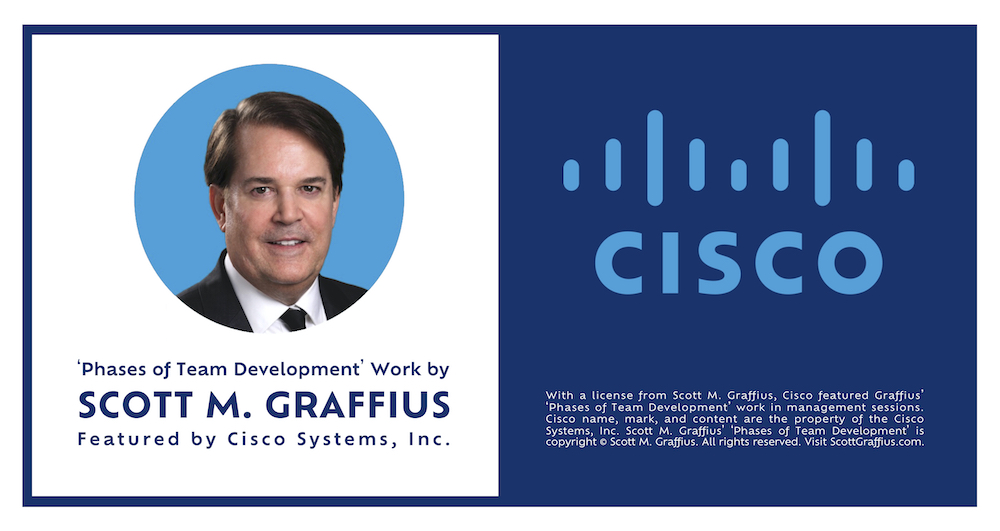











Sign up for Miro—it's free!
(Want more features? You can always upgrade to a paid plan.)


How to Cite This Article
Graffius, Scott M. (2025, September 4). Government of Finland Agency Features Graffius' Phases of Team Development IP. Available at: https://scottgraffius.com/blog/files/government-of-finland-agency-features-graffius-phases-of-team-development.html.

Digital Object Identifier (DOI)
DOI: (coming soon)

Content Acknowledgements
Names, marks, and content are the property of their respective owners.
Business Finland name, marks, and content are the property of Business Finland, the Finnish government organization for innovation, trade, investment, and travel.
Photo of Helsinki by Jussi Hellstén, courtesy of and used under terms of license from Visit Finland.
Photo of presentation at Business Finland event by Sari Havukainen, used with permission.
Graffius’ “Phases of Team Development” is copyright © Scott M. Graffius. All rights reserved. 

Top 5 Hashtags
#BusinessFinland
#Leadership
#TalentBoost
#TeamDevelopment
#Teamwork

Post-Publication Notes
If there are any supplements or updates to this article after the date of publication, they will appear here.

Copyright
Copyright © Scott M. Graffius. All rights reserved.
Content on this site—including text, images, videos, and data—may not be used for training or input into any artificial intelligence, machine learning, or automatized learning systems, or published, broadcast, rewritten, or redistributed without the express written permission of Scott M. Graffius.
